Growth Strategy – Workshop 2 (Market Opportunity)

The Appleton Greene Corporate Training Program (CTP) for Growth Strategy is provided by Mr. Ardila Certified Learning Provider (CLP). Program Specifications: Monthly cost USD$2,500.00; Monthly Workshops 6 hours; Monthly Support 4 hours; Program Duration 27 months; Program orders subject to ongoing availability.
If you would like to view the Client Information Hub (CIH) for this program, please Click Here
Learning Provider Profile

Mr Ardila is the co-founder of The Hawksbill Group, a business consulting and investment firm advising medium and large clients in the public and private sectors. Mr. Ardila is also a member of the Board of Directors of Accenture, Goldman Sachs BDCs, Nexa Resources and Ola Electric Mobility. Prior to his current activities, he was Executive Vice President of General Motors and CEO of Latin America from 2010-2016 (March). In his 30-year career with GM, he held several important positions, including country CEO in Ecuador, Colombia, Argentina and Brazil, as well as CFO of Latin America, Africa and the Middle East. He also worked as an investment banker for the Rothschild Group from 1996-1998 and Secretary General at the Ministry of Industry and Trade in Colombia (1983-84).
Mr. Ardila is a graduate of the London School of Economics where he obtained a MSc. Degree in Economics. He has lived in 10 countries and speaks English, Spanish, Portuguese and German.
MOST Analysis
Mission Statement
Simply described, a market opportunity is a gap in the market. Something, someone, or some place that isn’t being serviced by other businesses that you may take advantage of and exploit to expand your company swiftly. However, it is simpler said than done. Everyone is striving for the same spot and searching for that extra, unheard-of thing to put them ahead of the competition. How therefore can you identify a promising market opportunity before your rivals do? And once you have one, how do you go about creating an effective business growth strategy? Four crucial factors come into play when determining a promising market potential for your company: What do consumers want or need? What, more crucially, is your competition NOT doing? How does your product address a specific issue? or strengthen an existing remedy? What is the market like right now? Following the completion of these inquiries, you ought to be in a better position to comprehend your target market, spot product flaws, and ultimately find untapped markets. At the end of the exercise, you also need to understand the profit potential of the opportunity, which normally is arrived at by estimating the gross margin over a period of time.
Objectives
01. Identify Strengths and Weaknesses: departmental SWOT analysis; strategy research & development. Time Allocated: 1 Month
02. Purchase Situation Analysis: departmental SWOT analysis; strategy research & development. Time Allocated: 1 Month
03. Direct Competition Analysis: departmental SWOT analysis; strategy research & development. Time Allocated: 1 Month
04. Indirect Competition Analysis: departmental SWOT analysis; strategy research & development. Time Allocated: 1 Month
05. Analysis of Complementary Products and Services: departmental SWOT analysis; strategy research & development. Time Allocated: 1 Month
06. Analysis of other Industries: departmental SWOT analysis; strategy research & development. Time Allocated: 1 Month
07. Foreign Markets Analysis: departmental SWOT analysis; strategy research & development. 1 Month
08. Environmental Analysis: departmental SWOT analysis; strategy research & development. Time Allocated: 1 Month
09. Listen to your Customers: departmental SWOT analysis; strategy research & development. Time Allocated: 1 Month
10. Consumer Segmentation: departmental SWOT analysis; strategy research & development. Time Allocated: 1 Month
11. Spot Acute Unsolved Problems: departmental SWOT analysis; strategy research & development. Time Allocated: 1 Month
12. Profit Potential: departmental SWOT analysis; strategy research & development. Time Allocated: 1 Month
Strategies
01. Identify Strengths and Weaknesses: Each individual department head to undertake departmental SWOT analysis; strategy research & development.
02. Purchase Situation Analysis: Each individual department head to undertake departmental SWOT analysis; strategy research & development.
03. Direct Competition Analysis: Each individual department head to undertake departmental SWOT analysis; strategy research & development.
04. Indirect Competition Analysis: Each individual department head to undertake departmental SWOT analysis; strategy research & development.
05. Analysis of Complementary Products and Services: Each individual department head to undertake departmental SWOT analysis; strategy research & development.
06. Analysis of other Industries: Each individual department head to undertake departmental SWOT analysis; strategy research & development.
07. Foreign Markets Analysis: Each individual department head to undertake departmental SWOT analysis; strategy research & development.
08. Environmental Analysis: Each individual department head to undertake departmental SWOT analysis; strategy research & development.
09. Listen to your Customers: Each individual department head to undertake departmental SWOT analysis; strategy research & development.
10. Consumer Segmentation: Each individual department head to undertake departmental SWOT analysis; strategy research & development.
11. Spot Acute Unsolved Problems: Each individual department head to undertake departmental SWOT analysis; strategy research & development.
12. Profit Potential: Each individual department head to undertake departmental SWOT analysis; strategy research & development.
Tasks
01. Create a task on your calendar, to be completed within the next month, to analyze Identify Strengths and Weaknesses.
02. Create a task on your calendar, to be completed within the next month, to analyze Purchase Situation Analysis.
03. Create a task on your calendar, to be completed within the next month, to analyze Direct Competition Analysis.
04. Create a task on your calendar, to be completed within the next month, to analyze Indirect Competition Analysis.
05. Create a task on your calendar, to be completed within the next month, to analyze Analysis of Complementary Products and Services.
06. Create a task on your calendar, to be completed within the next month, to analyze Analysis of other Industries.
07. Create a task on your calendar, to be completed within the next month, to analyze Foreign Markets Analysis.
08. Create a task on your calendar, to be completed within the next month, to analyze Environmental Analysis.
09. Create a task on your calendar, to be completed within the next month, to analyze Listen to your Customers.
10. Create a task on your calendar, to be completed within the next month, to analyze Consumer Segmentation.
11. Create a task on your calendar, to be completed within the next month, to analyze Spot Acute Unsolved Problems.
12. Create a task on your calendar, to be completed within the next month, to analyze Profit Potential.
Introduction
Every company needs to know who they are, where they fit into the market, and where they’re going. Only 33% of businesses make it past their tenth year after starting out, while only 66% survive their first two years.
What does it thus take to locate the ideal market opportunities and create a development plan that gets you where you want to go?
What is a market opportunity?
Simply described, a market opportunity is a gap in the market. Something, someone, or some place that isn’t being serviced by other businesses that you may take advantage of and exploit to expand your company swiftly.
However, it is simpler said than done. Everyone is striving for the same spot and searching for that extra, unheard-of thing to put them ahead of the competition.
How therefore can you identify a promising market opportunity before your rivals do? And once you have one, how do you go about creating an effective business growth strategy?
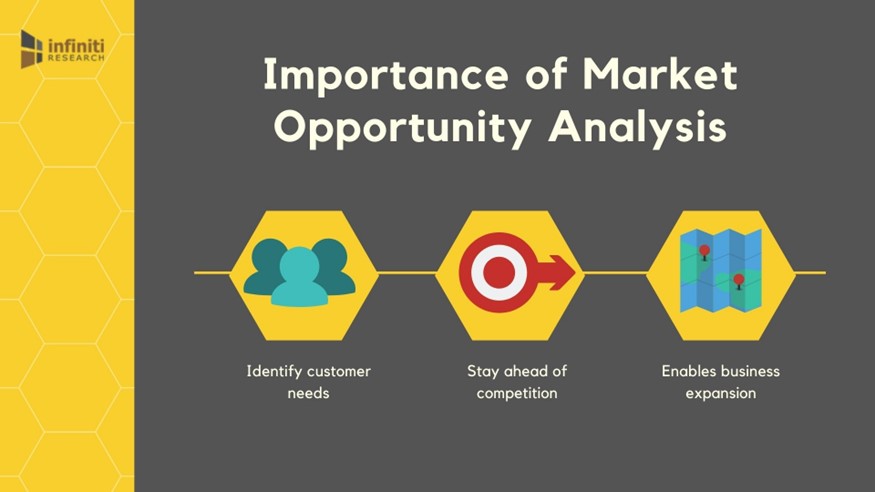
How to identify a good market opportunity
Identifying a good market opportunity for your business boils down to four key areas:
1. What do consumers want/need?
2. What is your competition doing, or more importantly, NOT doing?
3. How can your product solve a particular problem? Or compliment a pre-existing solution?
4. What is the current state of the market?
Following the completion of these inquiries, you ought to be in a better position to comprehend your target market, spot product flaws, and ultimately find untapped markets.
Let’s look at some of the methods you might use to respond to the following four questions.
How to use consumer data analysis to identify market opportunities
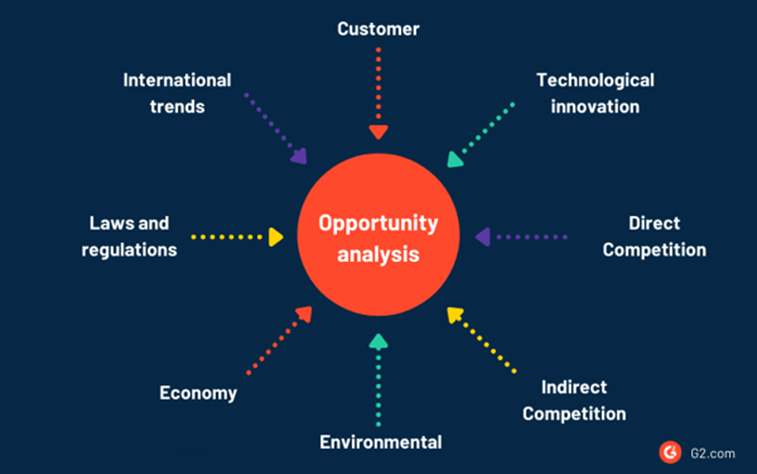
The first thing you need to do is figure out who exactly you are selling to. Knowing your audience is essential to assisting you in discovering a new market opportunity, whether you are doing customer surveys, analyzing data from your own website, or using third-party research.
Customer reviews and surveys analysis
Asking your consumers directly is one of the finest methods to find out who they are and what they want from your company. Customer feedback and surveys may provide you with valuable information about every facet of your company, from what clients think of your goods and services to how well your website and customer care department run.
Even though analyzing all of this feedback can be time-consuming, there are tools available to help. Sentiment analysis software can automatically determine the feelings underlying each comment and find recurring patterns in your comments. For instance, you can learn that multiple consumers have brought up a product’s flaw or that they feel your service falls short when it comes to after-sale support.
You may use the information you learn from your reviews and surveys to enhance your offerings, customer service, and brand perception. You must choose what you want to take away from your feedback and how you will apply it moving ahead.
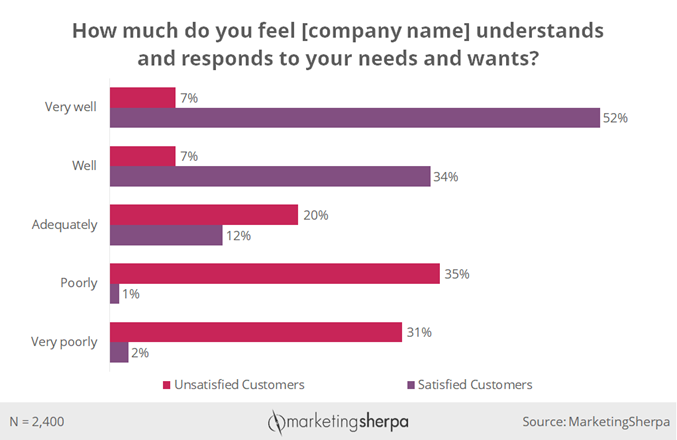
Identifying consumer segments
Examine your current audience and divide it into groups according to characteristics you find common. These can be hard demographic variables that can be used to estimate market size, such as age, gender, geography, income, occupation, etc. You may find out why individuals would purchase your items by analyzing “softer” factors like attitudes, lifestyle, and personal values. These factors can affect everything from price to design.
Creating customer personas
After segmenting your audience, you should become a little more specific and create some distinct client profiles. Customer personas are a more thorough breakdown of the many customer types most likely to patronize your company. For instance, a toy store might include personas for parents, children, grandparents, and so on.
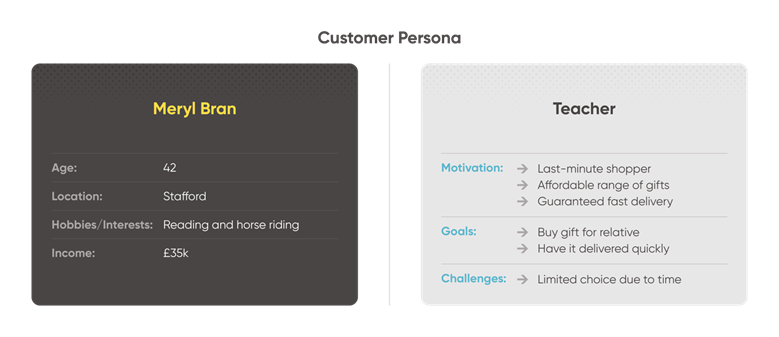
If it helps, you can give each of these personalities a name, age, and personality. The more real-looking they are, the simpler it will be to start relating to them on an emotional level. Personas make it simple for everyone in your company to understand the motives, potential pain areas, and ways in which your company may assist your target customer.
Based on actual clients, create each of your personalities. You may go deeper into who has purchased from you in the past and why by using surveys, feedback, and site analytics. In the long run, your business growth strategy will benefit from personas more if they are accurate.

Market opportunity examples across the world: Starbucks
When it comes to illustrating the failures of worldwide expansion, Starbucks has been virtually every expert’s go-to case study. Its failed attempt to dominate the Australian scene resulted in the closure of almost 70% of its outlets.
But another American coffee shop, Gloria Jean’s, did well in Australia.
It was a case of Starbucks not knowing how to make their brand relevant, not knowing how Australians loved their ambiance, and not being able to offer a menu that was palatable to the general populace.
Purchasing pattern analysis
Until you know how frequently and how much a consumer is likely to spend with you, you cannot assess the potential value of a new market opportunity. Your target audience’s frequency, amount, and value of purchases are revealed by their buying behaviors.
Key inquiries to make are:
• When do customers purchase our goods or services?
• When they need it, is it there?
• Where do people make the purchase?
• How are payments made?
Types of buying pattern
Every consumer purchase falls into one of the following categories:
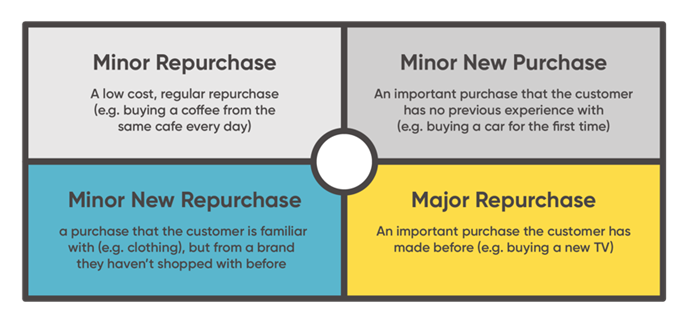
How to carry out purchasing pattern analysis
Consumers often go through five stages when making any purchase, regardless of the pattern they fall into. It’s crucial to comprehend each of them to determine where and how your company fits in.
1. Problem recognition
When a consumer realizes they either need or want to buy something, this is when it happens. They might require new headphones because their old ones broke, or they might decide to update their existing set of headphones since a new model just came out.
2. Collect information
At this point, buyers start to learn more about the products they might buy from a variety of sources, such as asking for suggestions, reading reviews, speaking with salespeople, clicking on advertisements, and more.
3. Evaluate alternatives
Consumers will have a number of options to pick from in terms of the kind of product or service and the brand or company after doing their research. Consider purchasing headphones as an example. The buyer will need to determine the brand they want to purchase as well as the sort of headphones they want (in-ear, wireless, or over-ear) (Sony, Bose, Beats, etc.).
They will evaluate the benefits, costs, and features of each good or service during this stage of the process in order to make a choice.
4. Final buying decision
Time to make or break! The consumer will now make a final decision regarding the good or service they’re going to acquire, albeit they also have the option of choosing not to do so! If they do decide to move further, they will additionally think about the location, timing, and mode of their intended purchase.
5. Post-purchase evaluation
The last stage is the most crucial if you want to keep your consumers. After making a transaction from you, did your consumer express satisfaction with it? Do they know who to call if they require assistance?
Asking for feedback at this point is a wonderful approach to assess how easy the consumers’ entire purchasing process was for them as well as to uncover any problems with the product or service so you can address them quickly and keep the client satisfied.

2. How to use product analysis to identify market opportunities
Product analysis can take many different shapes, but to put it simply, it is enquiring about and gathering feedback on your product. You can get information from a variety of sources for this, such as focus groups, current customers, and industry or product specialists. Almost any step of the design process is a good time to conduct a product analysis.
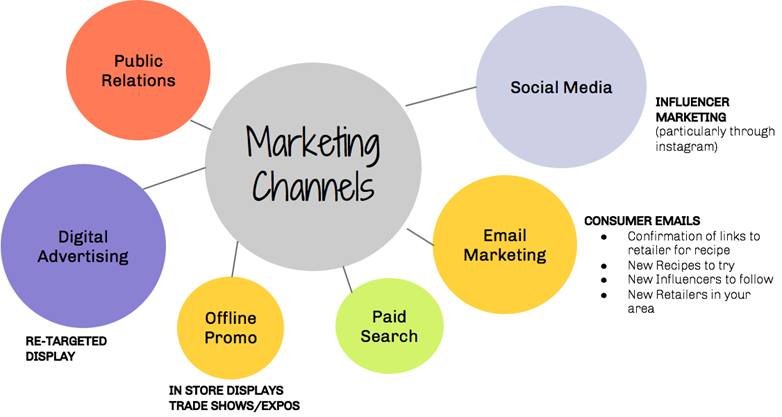
Evaluating your existing products using consumer feedback
Finding and analyzing customer reviews of items is a terrific approach to receive insightful feedback on both new and existing products. Sentiment analysis tools can highlight the positive and negative aspects of your product so you can quickly see what is working well and what needs to be improved.
When you know which products are popular with your customers and are receiving positive reviews, you can choose to concentrate on expanding the lines of these products, or you can switch up your marketing strategy by emphasizing the aspects of your products that your target market finds most appealing.
Evaluating complimentary or new product launches
You should be watching not just your own items but also those of others. Your growth strategy will be greatly influenced by how well items that complement your own perform. You must stay current with current trends in order to comprehend how these complementary items might impact you.
For example, if you make printers, you should monitor paper sales because more and more companies are putting a premium on sustainability. If you see a dip, you’ll need to either come up with a different plan of action or modify your growth approach.
But it’s vital to keep in mind that it’s not just passively monitoring how other people fare. Building connections and collaborating with like-minded companies might actually help your clients and open up new market prospects.

Market opportunity examples across the world: Ikea
The culture of the area is another element that has a significant impact on how people perceive products.
Ikea is renowned for its ready-to-assemble furniture and DIY philosophy. But in India, people are accustomed to having their furniture constructed. Indians of the middle and upper classes rarely own power tools, much less utilize them, or read manuals with complex graphics.
Ikea has however made progress in figuring out what the target market wants, changing everything from the type of wood used in the furniture to the Indianized Swedish meatballs offered on the menu.
It’s too soon to predict if Ikea will succeed in the subcontinent, but it surely helps to conduct accurate fieldwork the first time.
A business would be well to consider expanding to another area, especially if the market it serves is starting to become saturated. Untapped markets can present a variety of new prospects, potential clients, and business lessons.

3. How to use competitor analysis to identify market opportunity
The following phase in creating a successful growth strategy is comprehending your competition. There are several approaches, but the main thing you want to attempt and unearth are the primary advantages and disadvantages of each of your competitors. Then, use what you’ve discovered to influence the course of your firm.
Many new firms overlook competitor analysis, yet doing so will help you create good offensive and defensive plans, as well as forewarn you of any prospective possibilities or threats as early as feasible.
Competitor benchmarking
In order to compare your performance to that of your primary competitors, competitor benchmarking makes use of a variety of metrics. With anything you’re comparing, whether it’s market share, sales, or even your Net Promoter Score, you may be as general or particular as you wish. This is your chance to assess your performance in detail and determine the potential location of your next market opportunity.
How to choose competitors to benchmark against
Keep your attention on the task at hand and resist the urge to simply put everyone’s name in the hat. If you want to understand how you can improve right away, the main players in your field if you have higher growth aspirations, or even those who are playing catch up if you want to prevent being caught off guard in the future, you can opt to look at your direct competitors.
How do you choose what to benchmark
Where do you begin when there is so much to look at? Consider your company’s goals and the KPIs that will be most helpful in achieving your growth objectives. If you’re still hesitant, you can start in a few of the following places:
• Financial results (revenue, profit, year-on-year growth, etc.)
• Marketing stats (brand recognition, social following, engagement rates, etc.)
• Sales numbers
• Customer service statistics (customer relationship, action and efficiency, response times, etc.)
• Customer experience metrics (Customer Satisfaction Score, Net Promoter Score, Customer Effort Score etc.)
Industry benchmarking
Establishing your existing standing in the business you have chosen is also crucial. You can get a better understanding of where you stand in the market and identify new growth possibilities by comparing your business processes to “best practice” approaches and your performance to industry standards.
How to choose what to benchmark
It’s not always the simplest information to obtain, but if you look carefully, you can find a lot of data that you can use as a benchmark. Brand awareness, for example, could be difficult to measure precisely, but site traffic, Net Promoter Score, and social engagement are all quantifiable if you know where to look.
Here are a few metrics you may start monitoring to better understand how you’re doing in comparison to industry standards:
• Average order value
• Net promoter score
• Site traffic
• Average revenue per customer
• Social engagement
• PPC cost and rankings
• Feedback response rates
What to do if you’re looking to enter a new industry
Benchmarking won’t do if your business growth strategy calls for entering a new sector of the market. To more accurately assess the market opportunity available, you’ll want to learn as much as you can about your new industry.
Before starting your new business, there are a few things you should learn more about, such as:
• Market size
• Market share
• Growth rates
• Brand positioning of competitors
• Pricing and sales rates

4. How to use market analysis to identify market opportunity
Understanding the market, or the elements of the business environment, that may have an impact on the course your organization is taking, is the last piece of the puzzle. There are many external events that could possibly disrupt or even increase your odds of success, including political decisions like Brexit, legal changes like GDPR, and broader economic changes.
It might be challenging to keep up with everything that is happening, but it is critical that you do so in order to make more informed decisions for your company.
The following are a few things you should pay particular attention to:
• Technological developments
• Government regulations
• Geopolitical shifts
• Economic indicators
• Trade policies
• Social and cultural changes
Although much of this research will involve some fieldwork, using customer feedback can help you immediately gauge how seriously your consumers take these concerns.
Customers can be questioned about how these concerns might effect them in surveys, which gives you a wealth of viewpoints and more knowledge to assist inform your strategy for dealing with any potential roadblocks.

How to develop the right growth strategy for your brand
You’ll need a business growth strategy that enables you to capitalize now that you’ve finished a thorough analysis of the market and located the opportunities.
Because they never stop moving forward, companies like Apple, Netflix, and Amazon are able to maintain their growth. Their growth plan is adjusted as a result of their listening to and learning from the marketplaces and, most crucially, their consumers.
It all comes down to creating a reliable brand with lasting appeal. Creating a brand identity and a growth strategy that aims for constant and flexible expansion is crucial. Sure, there are some fast wins that could give you a few additional leads in the near term.
Ultimately, each firm is unique, so what works for one company might not work for you. If you’re still unsure about where to start, let’s look at a few possibilities.
Improve the reputation of your company
How is your brand viewed by consumers? Have you earned a good or bad reputation? Do you even have a reputation for your brand given how well-known it is? There is always space for improvement, regardless of how positive, negative, or neutral your reputation is, and doing so could greatly accelerate your progress.
To begin with, you must ascertain the reputation of your brand, which may be done by starting a client feedback collection process. Reviews and polls are a great place to start, but you can also utilize social listening techniques to find out what customers are saying about your business even though they might be reluctant to say it to your face.
You can leverage any favorable comments you receive to enhance the reputation of your brand. You can utilize them to influence any upcoming marketing initiatives, share them on social media, and include them into your PPC advertising. For instance, if your research reveals that your customers adore your eco-friendly packaging, your upcoming campaign might emphasize just how green your business is!
It’s also important to think about if you’re taking any actions that can damage your reputation. For instance, if you ignore or respond poorly to negative comments, it will harm your relationship with your clients.

Market opportunity examples across the world: Netflix
Over the years, Netflix has filled a variety of market voids. The business started out by mailing out DVD rentals for a monthly charge in 1997. The business had a DVD rental website in 1998 that was in competition with Blockbuster Video, which had physical storefronts.
One of the first profitable online DVD rental businesses, the business had more than a million clients by 2003. When the company launched its streaming service, it had 10 million subscribers by 2009, and Blockbuster declared bankruptcy the following year. As of 2022, Netflix has 200 million subscribers worldwide and is available in 190 countries.
Employee engagement
Your employees are the face of your company, so whether you know it or not, if they’re unhappy, they’ll be talking poorly about it. This may have a long-term negative effect on your reputation and stunt the development of your brand.
Additionally, it can make your initiatives unsuccessful, as was the case with Starbucks’ recent transgender acceptance campaign. Unfortunately, the campaign became viral for all the wrong reasons because the brand values portrayed in the video advertisement didn’t align with how many transgender employees felt.
It is simple to determine where your brand is succeeding and failing from the viewpoint of your employees. Your staff members can voice any complaints, express what they enjoy about their positions, and participate in the development and success of the company by participating in regular anonymous employee engagement surveys.
Even if you won’t be able to accommodate every employee’s request, you still need to demonstrate that you value their input, even if it’s not always favorable.
Focus on customer experience
Isn’t it time you stopped thinking about selling items and started focusing on selling experiences since firms who excel at their customer experience generate 5.7 times more income than the competition?
The economy of experiences is flourishing. 72% of millennials decide to spend their hard-earned money on experiences rather than actual things when making purchases. Due in part to technology, but also to changing consumer behavior that places a premium on shared experiences and the convenience of using smartphones for socializing, sharing, and shopping.
You must first understand what makes your customers tick if you want your firm to benefit from it. However, receiving feedback from your consumers before you start developing a new customer experience-focused growth plan will help you learn a lot about what you’re doing properly and, more crucially, what might be missing from your existing offering. Start building individualized brand experiences that are based on what your clients are telling you they genuinely want by utilizing his insight! removing the uncertainty and providing you an edge over the competitors.
Product development
Even though you already have some excellent goods under your belt, you still need to have a product development strategy in place if you want to stay ahead of the competition. You must be able to stand out in a crowded market, and distinctive goods and services are a wonderful method to achieve this. In addition to helping you keep your current consumers, fresh product advancements can draw in new ones.
To create a successful product development plan, you must first understand the needs of your target market. Consider:
• What your customers need
• What needs to be improved
• What your competitors are doing
Engaging your customers in your strategy is one of the finest methods to learn this information. To get input for improving your product offering, create surveys, read reviews, organize focus groups, and execute beta tests on new items. This will not only guarantee that you are producing goods that consumers value, but it will also strengthen your relationship with your current clientele because they will feel invested in the expansion and success of your business. If you want to expand your business, you need to check both of these boxes: this can assist increase customer loyalty and draw in new clients.

What is the difference between market research and market opportunity analysis?
Consider that you are in charge of putting up an ice cream counter in a shopping center. How would you approach the whole thing?
Finding the counter’s placement would be the first step. Would it take place inside the mall or outside? What flavors would you then be providing to everyone else? What would you charge for your goods, in the end?
When doing your market research, you would start by asking questions like these. You would need to draw on data that you either currently have on hand or obtain through market intelligence from multiple sources in order to respond to these inquiries.
After setting up your ice cream kiosk, you start thinking about how to expand your company. Could you perhaps raise the cost of each flavor? Maybe you could come up with some new combos or bargains. Perhaps you could collaborate with a different well-known brand to release a new flavor? These are only a few instances of market prospects that might enable your company to reach new heights of development.
Given that there are many overlaps between market research and market opportunity, it is simple to become confused between the two.
Market research provides information on which market opportunities are worthwhile, which makes it simple to recognize the difference.
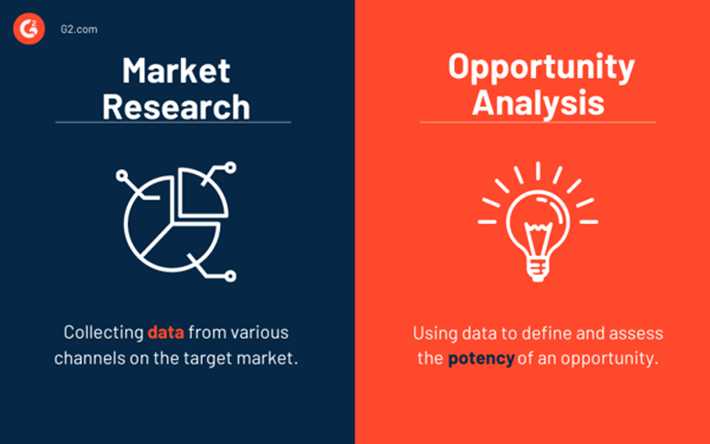
With their rapid fluctuations, markets may be sensitive things. It can feel hazardous to try something new or ambitious for your business.
However, seizing market opportunities shouldn’t require making a big bet. When done well, market research can eliminate ambiguity on multiple levels.

Market opportunity examples across the world: Whole Foods
Whole Foods fills the market void created by consumers’ desire for a central location to buy natural, organic, and nutritious food goods. Only a few natural food supermarkets existed in the United States in 1980, when the first Whole Foods Market opened in Texas.
The business spread all over Texas and the southern United States by 1984. The business began acquiring additional natural food stores on the West Coast and in the Northeast during the 1990s. Amazon.com bought Whole Foods in 2017, and it will be its property as of 2022.
Executive Summary
Chapter 1: Identify Strengths and Weaknesses
Even companies that appear to have it all together and be in the lead might have both strengths and disadvantages. Even while it is crucial for each firm to recognize its advantages and disadvantages, not all companies take the time to do so. People frequently find it simple to recognize their strengths, but it can be more difficult to acknowledge their flaws. However, that is precisely what every company ought to be doing!
Every company should focus on identifying its strengths and shortcomings for a variety of reasons. To begin with, once you are aware of your company’s advantages, you can utilize that knowledge to narrow your attention to those advantages, use those advantages to create a game-changing product, and ultimately expand your company. Knowing your shortcomings gives you the opportunity to make changes for the better and possibly enhance current items. Because you will be addressing it and perhaps resolving something that could be perceived as a threat to your organization, that shift can aid in the growth of your enterprise.
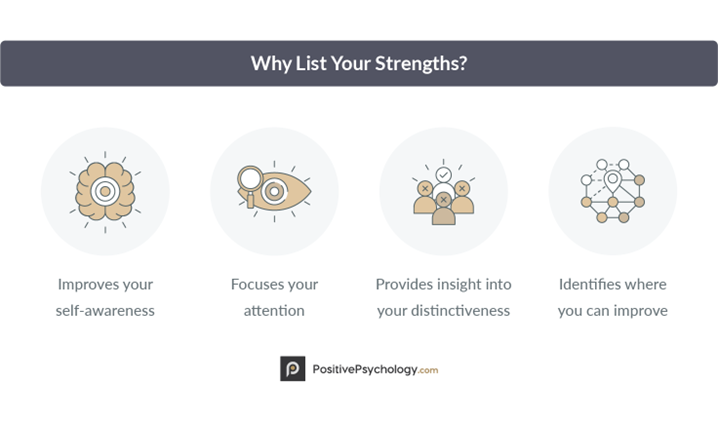
Here are several tips for determining your business’s strengths and weaknesses:
• Analyze. In order to identify the advantages and disadvantages of your company, analysis is crucial. You should be truthful when doing this. Again, admitting to our shortcomings can be challenging, but doing so is necessary if we want to make progress. After reviewing your prices in relation to the market using a pricing analysis report, you could occasionally need to make these price changes. In other instances, they could result from an ignorance of your target audience as a whole. Without evaluating everything and being sincere with yourself, changes cannot occur.
• Compile a list. Make a note of all the areas where the company, in your opinion, demonstrates its strengths and flaws on a piece of paper. If you’re being sincere, there’s a strong probability that you can recognize many of those places on your own. It may not have occurred to you previously, but once you do, it won’t be difficult to identify some areas for concern and those in which your company thrives.
• Consult others. Consider including others in the discussion if you are having trouble determining the company’s strengths and drawbacks. Ask your loved ones, your coworkers, and perhaps even your customers what they think. Create a survey for your consumers to complete if you’re going to ask them for feedback on your products or services, as well as any areas where you think your business may improve. A competitive pricing analysis company might be used as an example to analyze what is happening with your company’s price schedule and how it compares to market values. You can grow and change for the better with the help of the knowledge you gain from something like this.
• Take note of complaints. Does your business keep track of the consumer complaints it gets? If not, begin developing a procedure and a policy to do so. This is a fantastic technique to discover more about your company’s weaknesses. Since you will notice patterns in the complaints, the information you obtain will assist you in identifying weak points. Changes should be made using this information, especially if a certain policy, item, or service is frequently the subject of criticism.
• Make improvements. As you compile all of this data, you’ll discover your strengths and shortcomings. The details regarding your deficiencies are possibly the most crucial and should be addressed. Avoid overextending yourself by attempting to complete them all at once. Instead, concentrate on two or three areas of weakness at once. You can then set a target and establish a plan to take care of those before moving on to others. If changes can be made right away, fantastic. However, if they are the kind that will accept longer-term fixes, don’t worry. Things will eventually get better if you start making changes and attempt to enhance your weaknesses.
You may do this with your employees as well as as a firm as a whole. Ask them to honestly assess their assets and liabilities. Once they have, look into what may be done to fix the flaws. Perhaps making a few adjustments to your responsibilities will make your business more effective. Making such improvements allows for time savings and aids in the company’s future expansion.
Finding your strengths may be thrilling and joyful. However, having to examine the flaws in your business or workforce is never fun. But doing it is something that is crucial. This is especially important if you want to deal with dangers, support your company’s goals, and keep one step ahead of the competition. Set a goal to perform this exercise once a year or more, as new deficiencies could develop over time. By doing this, you can make sure issues are resolved and your business keeps running smoothly.
Make sure to seek assistance from a firm that performs a competitive price research and to look at your clientele as well. Make sure you are aware of your strategies for increasing the viability of your company.

Chapter 2: Purchase Situation Analysis
Any company decision should come after conducting a situation analysis. Planning for a new market opportunity or launching any new endeavor should start with this phase.
In this course manual, we’ll explain what a purchasing situation analysis is and walk you through how to conduct one to help you comprehend the idea better.
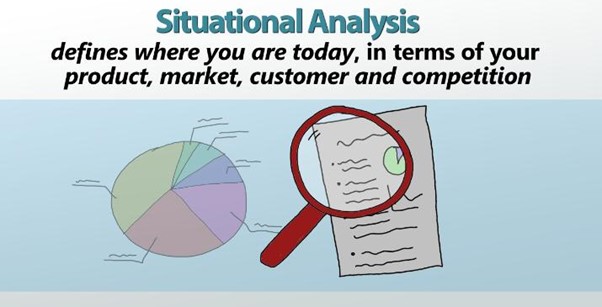
What is a Situation Analysis?
Prior to a new marketing initiative or project, it is essentially the process of critically examining the internal and external variables that affect a firm.
It gives you the information you need to see the opportunities and problems that are now facing your business, service, or product. The development of a strategy to advance from your current marketing scenario to your desired situation is aided by this.
Importance:
• Helps define the nature and scope of a problem
• Helps identify the current strategies and activities in place to overcome the problem
• Helps understand the opinions and experiences of stakeholders
• Helps give a comprehensive view of the current situation of the organization
• Helps detect the gaps between the current state and desired state
• Provides information necessary to create a plan to get to reach the goals
• Helps identify the best courses of action to take during the project
• Helps make sure that efforts and actions are not repeated and wasted unnecessarily
Steps to Conduct A Situation Analysis
By completing them, you will be able to get a thorough understanding of the conditions surrounding your organization.
Conduct a Customer Analysis
Investigate your target market in depth to learn about its demographics, geographic location, trends, interests, issues, etc. You may correctly organize the information using a client profile.
You may identify market trends, customer behavior, and demands and devise efficient methods to effectively reach them with the aid of a thorough customer study.
Take a look at the Product and Distribution Situation
Consider how well your current goods and services can meet the demands of your clients.
If you have distributors, you should also assess them in terms of distribution channels, distributor demands, distributor types, distributor sizes, as well as the numerous advantages enjoyed by both the distributors and the business.
Analyze the Competitive Advantage
You must identify your main competitors, their product positioning, and their strengths and shortcomings in order to ascertain your competitive advantage.
Here’s how to use some useful graphic tools to conduct an efficient analysis of your competitors.
Assess Your Environment
Examine how your organization’s performance may be impacted by both internal and external influences, including economic and political trends, personnel abilities, and the availability of resources.
Both the SWOT analysis and the PESTLE analysis are effective methods for doing an environmental scan.
After doing a thorough environmental scan, you will be able to pinpoint the opportunities and difficulties presented by recent developments.

Chapter 3: Direct Competition Analysis
What is direct and indirect competition in business?
Competition is not limited to athletics. It is something that exists in a variety of disciplines, including business, economics, psychology, and biology. In spite of the fact that the term itself may have a bad connotation (e.g., win-lose, zero-sum game), it is actually a crucial component for everyone, especially your business. Long-term improvements to your products, services, and client connections are made as a result of increased motivation and innovation.
Henry Ford once said:
“Competition whose motive is merely to compete, to drive some other fellow out, never carries very far. The competitor to be feared is one who never bothers about you at all, but goes on making his own business better all the time.”
Understand your competition, whether they are direct or indirect, regardless of whether your business is just getting off the ground or is well established. Why? Any company that might dissuade a potential client from picking you is one of your competitors. What company wouldn’t want to contend for that?
Understand your competitors
As corny as it may sound, competition is a given regardless of the goods or services you provide. For this reason, it’s essential to know what the other major players in the field are doing in order to retain your current clientele and advance. Google research is one of the cheapest, simplest, and quickest ways to find out more about your competition. To assist you understand what they’re all about, you can find client endorsements, reviews, opinionated blog articles, and other illuminating stuff online.
Pro tip: Perform a competitive analysis to keep a more detailed eye on your competitors. It’s crucial to conduct this extensive research in order to understand where your company fits into the market environment, even though it’s not a one-time project. This entails contrasting the pricing points, advantages, disadvantages, and characteristics of competing goods and services with those of your own.
Identifying the three major categories of competition—direct, indirect, and secondary competitors—is a vital component of mapping your competitors. Here, it’s crucial to be familiar with various company models in order to create a mental map while strategizing and guarantee that you have that “it” element in your market.
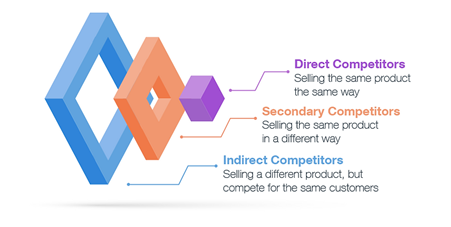
Direct competition
When two or more businesses fight for the same market by providing the same good or service, this is referred to as direct competition.
There are lots of typical instances of this. One is the competition between McDonald’s and Burger King; more particular, the Big Mac and the Whopper are fierce competitors. Apple’s iPhone and Samsung’s Galaxy is another illustration.
It’s not always easy to tell who your competitors are and who they aren’t. So, to assist you in locating direct competition, here are two straightforward methods:
• Customer feedback: Your clients undoubtedly have a few additional factors in mind before choosing you as their preferred brand. When you gather customer feedback, you can start to comprehend their preferences with the aid of your help desk software. Ask current clients which businesses they were considering. Ask prospective clients which companies they are thinking about in order to tailor and center your pitch on their requirements.
• Online communities: Boy, do people love to express their opinions on social media. Nowadays, the best places to go for advice are brands’ social media profiles and discussion boards on websites like Tumblr, Quora, and Reddit.
Secondary competition
When two or more companies provide a separate high-end or low-end version of your product or service to a similar market, this is known as secondary competition.
The following are a few instances of secondary rivals. Both Gap and Gucci, which are retail companies, aim to appeal to middle-class consumers who value practicality over luxury. Then there are websites that let you stream videos for free, but frequently at the expense of quality, such as Netflix and YouTube. With the first, you must pay a monthly charge to access premium content.
It frequently happens that launching a business is accompanied by a tornado of emotions. But you soon come to the realization that there are a lot of things you’ll need to do to put yourself on the proper road, including hiring smart staff members and developing an effective social media marketing plan.
Initially, you support customers through your personal Gmail account. However, when you develop and grow, you might find that it’s not scaleable. The next stage is to upgrade to “help desk software,” which comes with a full complement of features to expedite and manage your customer assistance. As a result, a ticketing system and your single Gmail mailbox are viewed as supplementary competitors.

Chapter 4: Indirect Competition Analysis
When two companies target the same market and audience, try to meet the same requirements, and offer different products, this is known as indirect rivalry. Because they offer various remedies for the same problems faced by customers, indirect competitors frequently steal away a sizable portion of a company’s potential customers.
Direct Competition vs Indirect Competition
Some junior marketers may design brand strategies without considering indirect competitors, concentrating primarily on the direct ones. To obtain a complete picture of the market environment, it is essential to take into account a range of goods and services. Below, we contrast direct and indirect rivalry and outline their unique differences.
When two businesses compete directly, they are providing the same goods to the same market. Although the brands, promotions, values, and marketing methods of the companies differ, their products are comparable. Additionally, direct competitors operate in the same market, such as coffee shops in a single city or luxury automobile manufacturers who sell the majority of their developments in Europe.
Businesses that target the same market and consumer segments while producing distinct items are said to be engaged in indirect competition. For instance, cookies and chocolate are both sweets that can be substituted for one another, making them indirect rivals. This idea is more expansive because there are so many alternatives available. For instance, watching different movies and cartoons, going out to dine or the theater, shopping at the mall, and even traveling are all ways to pass the time and can compete with one another.
Even if it could be difficult to consider every possible substitute, you can easily identify the most obvious ones by doing keyword research and researching related subjects. We also provide examples of indirect competition in other markets to assist you better comprehend this idea.

Indirect Competition Examples
You can find a clear strategy and significant competitive advantages by identifying and evaluating your company’s indirect competitors. Study some of the instances of indirect competition below to help with your analysis.
1. Domino’s Pizza vs. McDonald’s. These businesses cater to customers who want to eat quickly and sell fast cuisine. They operate globally and use very identical price guidelines. Additionally similar are their marketing and branding. Domino’s serves pizza, whereas McDonald’s sells burgers and fries, therefore we can say that they are indirect rivals.
2. Marvel comics vs Netflix movies. These two businesses face off in the teen and adult entertainment market. They both have a large following and work all around the world. Netflix movies can be replaced by Marvel comics, and vice versa, even if these two companies don’t directly compete with one another.
3. Targeting vs collaborating with influencers. We can state that these two advertising strategies are in direct competition with one another. The same markets and audiences can be reached utilizing influencer marketing or targeted advertising. Selling goods from the advertised brand is the objective as well. These techniques, however, differ and each has unique characteristics. We advise integrating them to improve the outcomes of your marketing activities.
Here are two effective techniques for identifying indirect competitors:
• Keyword research: Depending on the effectiveness of your SEO efforts, both Google and Bing search engines provide websites a chance to rank on the first page of SERPs (search engine results pages) for particular keywords. While it may seem strange that businesses compete for this real estate in the rankings, it really is no joke. The majority of your prospective consumers use specific keywords in their searches to locate the best answer.
Pro tip: Use Google Keyword Planner to determine how frequently people search for these terms. A more sophisticated SEO tool that can analyze keywords and other SEO data for any website or URL is SEMrush. Your chances of obtaining a high position in the SERPs of both of these search engines will increase with the use of these tactics.
• Creating material that is SEO-friendly: Many of your indirect rivals are producing genuine content (such as blog posts and landing pages) that is closely relevant to your good or service. Every page contains keywords, a seemingly simple yet incredibly effective method of boosting your visibility on Google. Indirect competitors include any companies, bloggers, or magazines that write on subjects related to your brand.
In the end, most of us deal with indirect rivalry on a daily basis. Will a salad or burger satisfy my hunger during lunch? or “Will I chose to take an Uber or drive my car to work?” Customers just need to choose once, which gives organizations a particularly strong opportunity to analyze and comprehend the thinking behind these choices.
Know thyself
A crucial marketing tactic for defining the steps your business takes to gain a competitive edge is competitive brand positioning. Given the concept’s many ramifications, it is both potent and difficult to comprehend. Philip Kolter and Kevin Lane Keller define this phrase as follows in their book Marketing Management:
“The act of designing the company’s offering and image to occupy a distinctive place in the minds of the target market.”
Simply said, it’s how your business sets itself apart from competitors and how your brand influences consumer perception.
You’ll be able to identify your rivals, analyze your strengths, and determine how to best position your brand to win the market through thorough market research. Create a statement that describes your brand’s identity to start.
You don’t have to come up with this yourself. Denise Lee Yohn, a specialist in brand leadership, offers a straightforward formula and some exploratory questions for each variable:
For ‘X,’ we are the ‘A’ who does ‘B’ because ‘C’
• ‘X’ = target audience: Who could be interested in your product or service? What makes them unique? Why are your offerings important for them?
• ‘A’ = brand position in the market: What is your brand’s position in the market? How do your existing and potential customers perceive your product or service?
• ‘B’ = the ‘it’ factor: What makes your brand different? Why should your target audience value you and not others?
• ‘C’ = show results: What proof do you have that shows you can deliver?

Chapter 5: Analysis of Complimentary Goods and Services
The part that complementary items play in the value creation equation is one aspect that could affect a company’s capacity to reap revenues from its goods and services.
The pricing and demand of these “complements,” as they are also known, are linked since they are goods that are utilized in conjunction with or as a result of using your goods or services.
Complements are a significant, yet frequently ignored, factor that we included in the Porter’s Five Forces model because they must be carefully considered while developing your company’s business plan.
According to economists, two items or products are complementary if a change in one’s price causes the demand for the other to shift in the opposite way.
For instance, if DVD movie prices decrease, there will be a greater demand for DVD players, and if ink cartridge prices decrease, there will be a greater need for printers.
However, the contrary is also true: if the cost of DVD movies increases, the demand for DVD players decreases, and if the cost of ink cartridges increases, the demand for printers decreases.
Complements can be crucial to your ability to regularly and successfully generate income as a result of this relationship.
For instance, if the complement is exclusive and one-of-a-kind, its dealer may be able to restrict your capacity to sell your goods.
In other words, the complement would limit the demand that YOU are able to meet by not being accessible to all of your “possible” clients.
Consider a company that produces coffee pods that are exclusive to a certain kind of brewing equipment from a separate company.
The machine manufacturer has sway over the capsule vendor because it decides where and to whom the brewers are sold and because it also grants the manufacturing licenses, which has an impact on how profitable the capsule producers can be.
This is taking place in the video game industry, where the developers of the PlayStation, Xbox, Nintendo, and other consoles set game prices and receive a share of the sales.
As a result, the strategy of the console manufacturers restricts the earnings that game developers can hope for.
You must pay close attention to how much the complementary solution is required to utilize your product and how easily available it is to YOUR target customers whenever you are marketing a product that depends on a complementary solution in any way.
If your customers require a complement to utilize your product, you must incorporate guarantees into your business strategy to prevent giving the complement’s creators influence over your revenues.
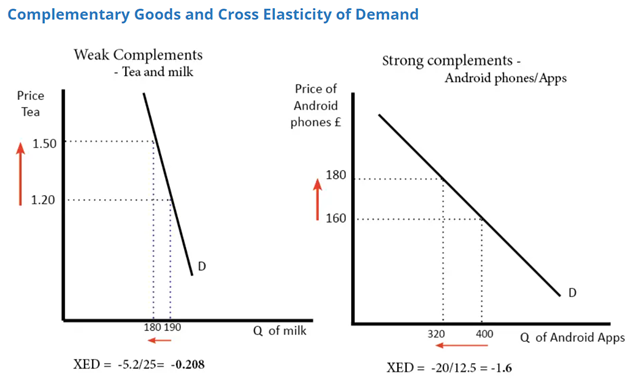
Understanding Supply Vs. Demand
The interaction between suppliers and consumers of a resource is the subject of the theory known as the law of supply and demand. The concept explains the relationship between a commodity or product’s price and consumers’ willingness to buy or sell it.
When prices rise, people frequently supply more while demanding less, and when prices fall, the opposite occurs. The law of supply and the law of demand are the two distinct “laws” upon which the concept is based. Together, the two laws determine the actual market price and the quantity of commodities on the market.
Demand
The rule of demand states that, given all other factors remain constant, fewer individuals will desire a thing the more expensive it is.
In other words, the quantity asked increases in proportion to the price. Because the opportunity cost of buying a good increases as its price rises, consumers buy less of something at a higher price.
Supply
How many units are sold for a specific price is shown by the law of supply. The slope of the supply connection is growing, in contradiction to the law of demand. This shows that as the price increases, the quantity given will increase as well.
The prospective cost of each new unit rises significantly from the standpoint of the seller. Because the higher selling price balances the higher opportunity cost of each additional unit sold, producers offer more at a higher price.

Chapter 6: Analysis of other industries
Many companies utilize industry analysis as a technique to evaluate the market. Market analysts and business owners utilize it to determine how the industry dynamics for the particular industry researched function. The analyst can gain a strong understanding of what is happening in the industry with the use of industry analysis. Consider it a sophisticated method of “getting the lay of the land.”
When it comes to business, industry analysis entails evaluating factors like industry competition, the interaction of supply and demand, how the industry compares to other, emerging industries that offer competition, the industry’s likely future, particularly in light of technological developments, how credit operates in the industry, and the precise magnitude of the impact that external factors have on the industry.
Industry analysis has numerous benefits. You can use industry research as an entrepreneur trying to establish yourself in the market of your choosing to determine where you are in relation to other market participants. When planning for the future of your company in the context of the development of your industry, you may utilize industry research to your advantage to spot possibilities and risks in your immediate surroundings. Understanding how you stack up against your rivals and utilizing that knowledge to your maximum advantage are the only ways to succeed in any cutthroat market.
What Does Industry Analysis Aim to Achieve?
It is impossible to overstate the value of industry analysis for marketing ability. For your firm to succeed, industry analysis and the related skills are vitally essential since they will provide you a deep awareness of the environment in which you are working. But there are several aspects to this importance that can each be examined in more detail.
Industry Analysis Can Be Used to Predict Performance
The performance of the industry as a whole is one of the best predictors of how well your organization will succeed in a certain sector. If the industry is doing well, then your business, assuming you run it well enough, is likely to do well inside that sector. You can determine the changes that industry is likely to experience by being able to predict the changes that are likely to occur in that sector. For instance, manufacturers of goods that need fuel to generate them will benefit from higher profit margins if the price of fuel falls significantly. Predicting such changes will enable your company to respond strategically while working on initiatives pertaining to your industry.
Industry Analysis and Positioning of a Business
If you comprehend how the market functions, you will be better equipped to position yourself in the market throughout the planning stage of your firm. For instance, you will be better able to determine how you may set yourself apart from the competition if you are aware of the kind of things being sold in the market as well as how saturated the industry is.
Analyzing the industry to find threats and opportunities
You will be able to recognize a wide range of dangers and opportunities when you do an industry study. Opportunities are phenomena that would promote the growth of your firm, whereas threats are phenomena that would prevent it.
What Types of Industry Analyses Are There?
There are three main ways in which you can perform industry analysis. These are:
1. The Competitive Forces Model, also known as Porter’s 5 Forces.
2. The Broad Factors Analysis, also known as PEST Analysis.
3. SWOT Analysis.

Chapter 7: Foreign markets analysis
Market research is a crucial task for businesses of all sizes. It’s essential to conduct as much research as you can over a wide range of topics before entering a new local market or category to make sure you’re as ready as you can be to launch a successful entry with the least amount of risk.
Market research is still crucial when entering a foreign market. In fact, it can be much more crucial because the stakes are bigger and you’ll be dealing with completely different market circumstances.
This article will discuss why businesses need to conduct international market research, how it often differs from domestic market research, and some of the primary motivations for doing so.
What is international market research?
The term “international market research” is used to refer generally to all pre-entry market research and preparation. International market research, in contrast to domestic market research, is concentrated on a foreign market, which frequently has completely different cultures, economic conditions, and consumer behaviors.
International market research involves a variety of techniques and phases. Although the specific tactics and procedures are frequently the same as those used in domestic market research, your overall strategy probably won’t be the same.
What are the objectives of international marketing research?
Before launching a product or service in a new international market, you can learn about it by conducting international market research. Understanding your target audience, identifying potential obstacles, becoming familiar with your competition, and everything else that will increase your chances of success and prevent unpleasant surprises are the major goals.
What distinguishes domestic market research from that conducted abroad?
Between local and international market research, there are a number of significant differences. The following are some significant variations:
You’re entering a market with social and cultural differences
International market research is far more difficult in many respects than domestic market research because of the frequently enormous contrasts between your home country and your target country.
The challenges are frequently the same as the reasons why you need to conduct the study in the first place: you want to learn as much as you can about a place and culture that may be very different from your own.
For researchers, the disparities between nations might provide numerous difficulties. One-on-one interviews, for instance, are a research technique that excels in western nations like the US and the UK but fails miserably in other regions of the world where it is viewed with scepticism.
There may be more restrictions around research
International marketplaces have legal variations in addition to cultural and social ones. Even while you may be quite familiar with domestic law—particularly as it relates to market research—the situation abroad might be very different.
You will therefore need to be familiar with a completely new set of regulations in order to refrain from breaking them and getting into trouble with the law. One such is the TCPA, which outlaws using an automated dialing system to call a cellphone in the USA.
Before starting any investigation, it is essential to undertake legal research and consult with attorneys in your target market because of the various legal requirements. Being on the wrong side of the law could have disastrous consequences.
It requires much more investment
You can frequently conduct market research on your own turf for a reasonable price. But expenses can soon soar if the same research is conducted abroad. When you’re conducting business in a foreign country with individuals who speak a different language, seemingly straightforward tasks like selecting interview locations, conducting phone interviews, and gathering candidates for interviews can become immensely more challenging.
To assist you in doing these chores, you could find that you need to hire a small army of local employees. Even more distressing, poorer nations with less extensive internet access don’t respond nearly as well to the less expensive market research techniques like email and online surveys.

Chapter 8: Environmental analysis
What is environmental analysis?
A strategic method for determining all internal and external aspects that might have an impact on a company’s success is environmental analysis. While external components reflect potential and threats, internal components show a company’s advantages and disadvantages. Outside of the company, this exists.
Environmental analysis takes trends and major elements into account. For instance, interest rates and how they could impact a business. These evaluations can aid companies in becoming more appealing to customers.
What advantages can environmental analysis offer?
Environmental assessments assist businesses in identifying potential repercussions. That might present a risk or a chance. They can anticipate changes in their environment thanks to this.
Environmental scanning has a number of benefits, such as the following:
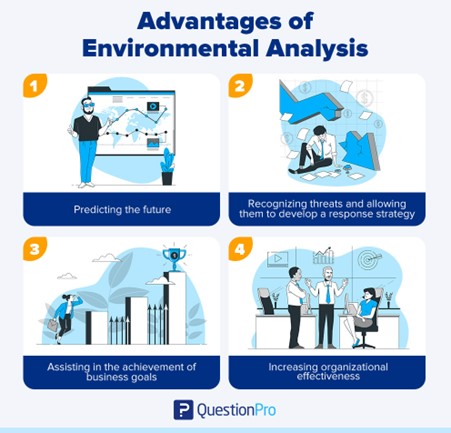
Assisting in the accomplishment of company objectives, threat detection, and response strategy development, future prediction, threat recognition, and increased organizational effectiveness.
Understanding the external local, national, or international variables that might effect your small business requires first creating a marketing environmental analysis. Although most of these elements are beyond your direct control, you can still modify your business and marketing plan to maximize the benefits and minimize any potential risks. The most typical approach to doing one of these reviews is a PESTLE analysis.
Example of an Environmental Analysis
Consider Mr. X, an analyst at the financial services company ABC Pvt. Ltd. Mr. X performs an environmental analysis in response to recent changes in the banking sector. Mr. X decides to do a PESTLE analysis because the finance sector is driven by technological improvements.
Mr. X takes into account the political, economic, social, technological, legal, and environmental elements in this analysis. He pays more attention to the technical details, though. He contrasts the technological developments taking place in other businesses operating in the same sector.
The findings demonstrate new developments in technically sound services. It explains how effective chatbots for financial services can boost a company’s profitability. Mr. X plans to create a powerful chatbot because ABC Pvt. Ltd. does not currently have one. The analysis’s recommended course of action is to increase their after-sales support through technological advancements. After that is finished, the company sees a 15% increase in revenue and profitability. The analysis is therefore regarded successful.

Chapter 9: Listen to Your Customers
All day long, our ears pick up sound. Colleagues are using the printer, filling their coffee cups to the brim, and typing on keyboards. We frequently ignore these background noises and carry on with our task in isolation.
What about the opinions of our coworkers, managers, and clients? Do we still act in the same manner toward them? It’s quite easy; since your customers are the ones who buy your products, they can tell you which products are lacking in the marketplace.
One of the most crucial abilities you may have in business is the ability to listen, especially if you manage a team or work in a customer-facing position.
Your clients are the ones that bring in the money for your company, therefore it makes a difference whether you pay attention to them or not if they decide to buy from you in the first place. Without customers, your business cannot function, and if you don’t take the time to understand their needs, you won’t have any customers either. This will then provide you the opportunity to create a good or service that no one else has yet imagined, therefore meeting a market need.
Why you Should Listen to Your Customers
The conversations you have with your potential or current consumers should be two-way; you want them to listen to you as you explain all the ways your product or service will benefit them, but you also need to lend them your ear.
It’s in your best advantage to acknowledge that your consumers are also people with needs to be acknowledged and understood.
Here are some benefits of listening rather than talking in case you’re still unsure;
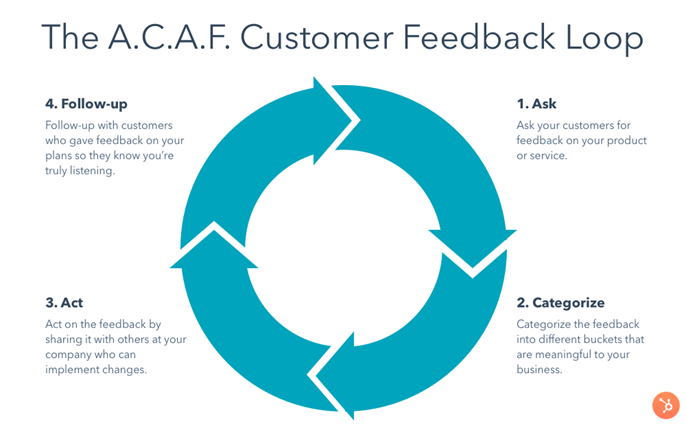
Your Customers Know What They Want
You can never be completely certain that you understand what a consumer wants until you pay attention to their pain areas, regardless of how much market research you conduct.
Your presumptions about the features, price range, and even the product they want could be wholly incorrect. Be cautious and pay attention to what your client requests.
You’d be insane not to use the information they give you so you can provide the greatest product for their needs, as 59 percent of customers claim that personalisation influences their purchasing decisions.
This procedure should continue as you deepen your connection with them and adjust as their demands alter, ultimately boosting sales and client loyalty.
You Don’t Have to Be Alone to Have Useful Insights
Even while you may believe that your goods or services, sales strategy, and customer support are top-notch, your customers’ perspectives may be very different.
To finally improve the client experience, you can redefine your offering, the way you sell, and your customer care techniques by soliciting consumer input through customer reviews and your CRM software.
The suggestions they offer you are probably going to help you both keep their business and draw in new clients.
The Customer is Always Right
It’s simple to forget that even while clients are looking to you for a good or service, they still have the final say in the purchase.
It’s challenging to pretend to listen. Customers are the first to realize when you are not paying attention since they are aware of it when you are.
The philosophy of “the customer is always right” should not be overlooked; not only do your prospects have money to spend, but they also have the option to work with your rival instead of you.
It’s Not Me, It’s You…
Don’t undervalue your rivals; both new and returning clients might easily visit a different website in place of using and purchasing your goods or services.
When clients have so many options available to them, fully understanding their needs may make a huge impact. They will be more willing to conduct business with you if you demonstrate that you value their opinions and make adjustments as a result.
There are several customer-focused software options available that can assist you in reminding your clients of the benefits of doing business with you. They are more likely to remain and develop into a devoted clientele when they experience this sense of ease.

Chapter 10: Consumer Segmentation
The most efficient customer engagement is made possible by accurate consumer segmentation.
What is Customer Segmentation?
The practice of segmenting a company’s customers into groups that demonstrate similarities among customers in each group is known as customer segmentation. In order to optimize each customer’s value to the company, it is important to select how to interact with each category of customers.
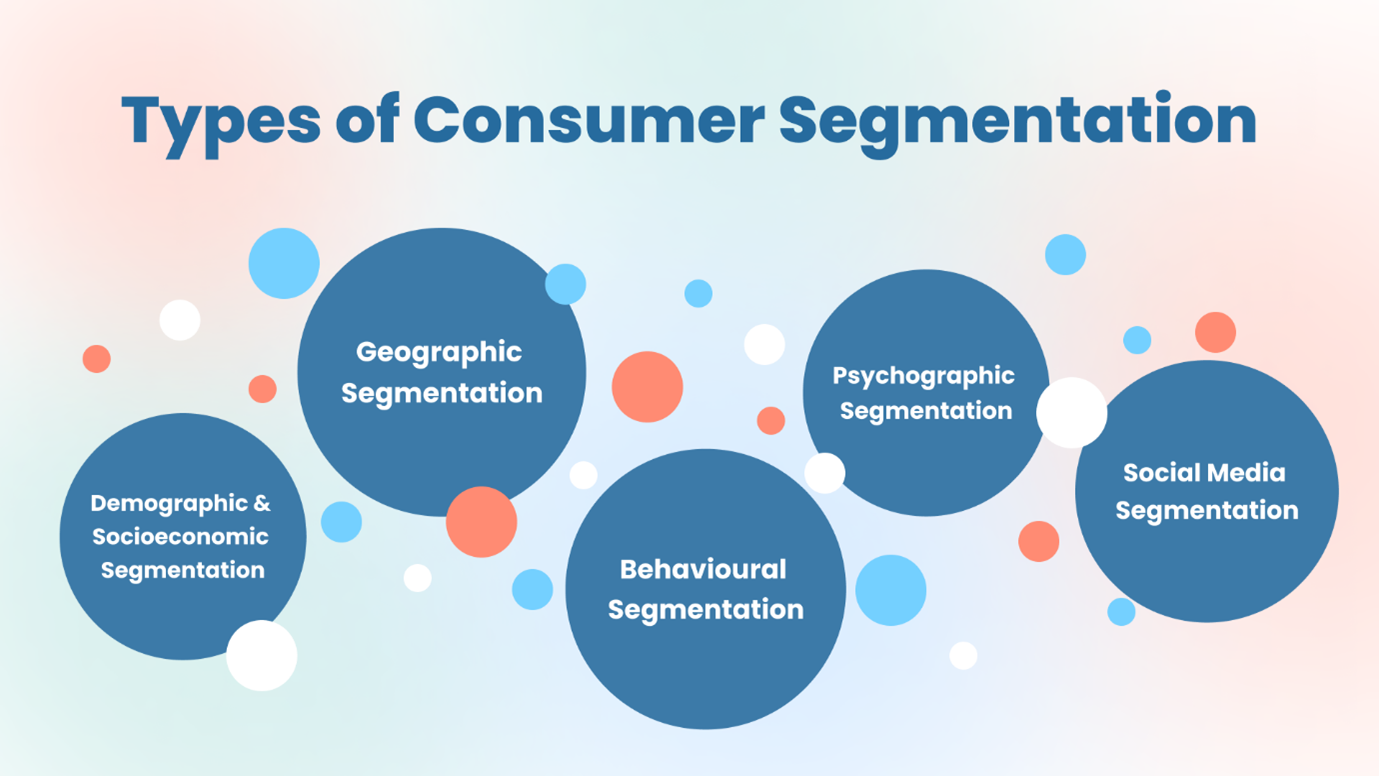
What is customer segmentation analysis?
The method used to find insights that characterize particular client segments is known as customer segmentation analysis. This method is used by marketers and brands to decide which promotions, deals, or items to use when speaking with particular target audiences.
A retail firm might, for instance, construct a segment of prior consumers who haven’t made a purchase or browsed the eCommerce site in the last 30 days in order to figure out how to reactivate lapsed customers. Then, it might examine that group to learn more about the kinds of things these customers have previously purchased, their penchant for discounts, and other factors. The marketing team can use this data to decide which campaign to develop to reactivate these lapsed clients.
Analyzing a segment’s expected Future Value, average order value, loyalty tier distribution, and other factors can help a business assess the value of specific segments.
Why is customer segmentation important?
Marketing professionals may be able to reach each consumer in the most efficient method with the help of customer segmentation. A customer segmentation analysis enables marketers to distinguish distinct groups of customers with a high degree of precision based on demographic, behavioral, and other factors using the vast quantity of data about customers (and potential customers) that is accessible.
It is essential to know in advance how any specific marketing action will affect the client because the marketer’s objective is often to maximize the value (revenue and/or profit) from each customer. Such “activity-centric” consumer segmentation should ideally place more emphasis on the long-term customer lifetime value (CLV) impact of a marketing action than on its immediate worth. As a result, it’s essential to segment or group customers based on their CLV.
CLV-Focused Customer Segmentation
Naturally, it is always simpler to make assumptions and utilize “gut instincts” to set the rules that would categorize customers into logical categories, such as those who purchased a specific product or service, originated from a specific source, or resided in a specific place. These broad classifications, meanwhile, rarely produce the desired outcomes.
It goes without saying that certain clients will spend more money with a business than others. The top clients will spend a lot over a long period of time. Good clients will either spend a lot in a short amount of time or modestly over a lengthy period of time. Others will refrain from making large purchases or from remaining too long.
In order to address each group (or individual) in a way that will most likely maximize that future, or lifetime, worth, the proper way to segment consumers is based on forecasts of their total future value to the business.
Approaches to Segment Customers
You must choose the method you’ll take to establish your client segments after determining the ideal categories and attributes to employ as a foundation. Rule-based segmentation and cluster-based segmentation are the two most used methods for dividing clients into different groups.
Setting thresholds to determine which category a customer belongs to is the main goal of rule-based segmentation. The strategy divides clients into groups based on a set of guidelines. The rule-based segmentation approach is a straightforward method for grouping clients into groups, but it necessitates that you choose the qualities each time. By taking a look at how many clients are in each group, you can more easily keep an eye on trends. The rule-based segmentation strategy involves a lot of work to keep segments updated if consumer behaviors change because it is challenging to add new qualities.
Cluster-based segmentation determines the optimum way to segment clients so that the segments are as equal as feasible rather than dividing them by thresholds. It illustrates the connections between data points so that client segments can be created. These groups are produced via cluster-based segmentation using the K-means method. Using the cluster-based segmentation approach, you can discover new patterns in your data and generate groups you were unaware of. Additionally, it can group clients based on a variety of factors. Cluster-based segmentation offers greater segmentation capabilities with minimal upkeep, but it is challenging to implement without a skilled data scientist.

Chapter 11: Spot Acute Unsolved Problems
Finding a niche is one thing, but you will have a better chance of dominating a particular market if you can identify a niche with unresolved issues. It partly has to do with conducting the right study. Look at the market on which you should concentrate. You can succeed if you identify the markets that need a particular type of solution and the rivals you can outperform. You might find a definite lack of order, for instance, if you look at the healthcare or home care industries.
Particularly when it comes to technology, there is a glaring lack of forward movement in the home care sector. The absence of effective technology may mask a lack of organization. But at this point, anyone running a home care business may use software to boost their competitiveness. Additionally, it is important to consider markets where identical services and goods are already available.
Deciding which market problems to solve for your target market
Identifying market problems
The following step is to identify their common difficulties, commonly referred to as market challenges, after you have conducted interviews with potential customers and examined the results. Although the issues facing your target market may be expressed in a variety of ways, the statistics may show consistent tendencies. Search for recurring themes or characteristics in all of the interviews.
Market issues are issues that your target market has publicly or covertly. This might be used to describe current inefficiencies, cumbersome workflows, or subpar solutions. The secret to identifying a market issue is to pay attention to complaints or “if only” statements that come up during interviews.
Market problems: Example
If you owned a company that sold gardening supplies, you would speak with gardeners to determine any issues that arise at work. Paper yard bags not remaining open during gardening could be a problem.
Even though the interviewees may have stated, “I need a better paper bag,” the issue with the market is that the bag won’t stay open. The most crucial part of this activity is identifying the issue, which is that the paper bag won’t remain open. You can choose to remedy this problem in a variety of ways, such as by using a different material or putting a paper bag ring.

Chapter 12: Profit Potential
In order to boost profits, enter new markets.
If you are unable to expand inside your current market, you may be able to enhance sales and profitability by entering new markets. However, you shouldn’t rush into choosing to expand.
There are risks involved in both expanding into an existing market and releasing a new product. Those hazards must be properly taken into account when estimating market profitability.
What is market profitability?
Market profitability considers the monetary aspects that influence your capacity to generate earnings. These include:
• The level of interest in your product
• The ability of customers, buyers or suppliers in the market to influence your business
• Barriers to entry, such as government restrictions or limited distribution
• The potential of substitute products to affect the demand for your goods
• Competition and rivalry in the market
You might wish to consider other strategies for increasing your margins if your market study reveals weak market profitability. You can utilize a variety of strategic planning methods to aid in your market study.
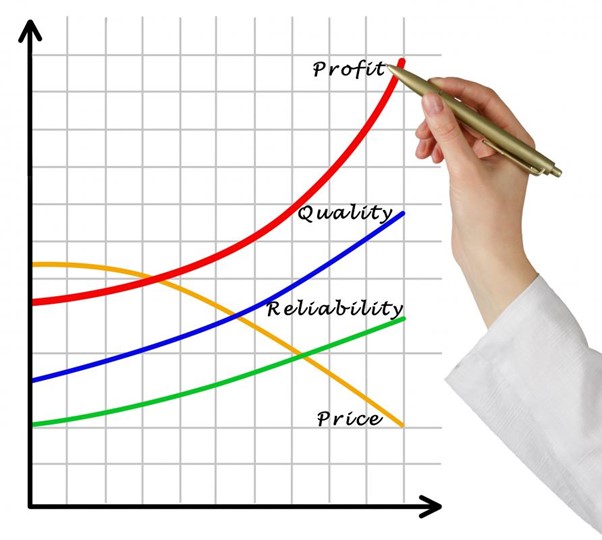
Market research’s importance
Before you begin, it’s crucial to conduct in-depth research on potential opportunities. For new markets, you might be able to customize or adapt current goods or services. This can quickly increase profits while adding new revenue at low cost. Are there any possible uses for the instruments you make for the garden market, for instance, in the construction sector?
You must have a firm grasp of the following when conducting market research:
• Who your potential new customers are
• Why, when and how they will buy the product or service
• How much they will pay for it
Expanding into new territories
You might be able to sell your current goods and services in foreign countries. Exporting can increase your market, increase your revenue, and lessen your dependency on domestic clients. Learn how to export and how to get support for exporting.
New product and service development
You must be certain that it is feasible for you to develop a new good or service for a new market. Think about the following:
• Do you have the skills and expertise internally or will you need to outsource?
• Have you got the commitment and resources available to make the new project work?
• Can you minimise the risk of a new venture?
• Are you sure there’s a demand for the new product or service at a profitable price?
Continuous improvement for better profitability
It takes more than merely putting effort into profitability for a brief period of time before letting it take care of itself. It’s crucial to continually prioritize profitability in every aspect of your company.
Regularly manage your profitability
You must routinely evaluate your profitability, taking into account all the important factors, such as:
• Purchasing
• Sales and marketing strategy
• Production and delivery processes
Wherever it is possible, include these reviews into your regular business operations. Encourage sales teams, for instance, to concentrate on profitability of sales rather than merely turnover. Production personnel could also receive bonuses for coming up with more effective solutions.
You will need to take a step back from your business’ profitability from time to time.
Watch market trends
Market trends should be kept in mind because they will affect your profitability. Market shifts might create fresh business chances. By closely observing them and making the appropriate adjustments, you can profit from market trends and competitive intelligence.
Benchmarking and SWOT analysis can help you develop a profitable plan.
Benchmarking allows you to compare your performance to that of similar companies. Regular benchmarking will provide you fresh insights into your areas for progress.
Your ability to manage your strengths, weaknesses, opportunities, and threats as they change will be aided by routinely using SWOT, PESTLE, and other models for strategic analysis. By doing this, you have the highest opportunity of responding to developments before your rivals do, preserving and boosting your profit.
Curriculum
Growth Strategy – Workshop 2 – Market Opportunity
- Identify Strengths and Weaknesses
- Purchase Situation Analysis
- Direct Competition Analysis
- Indirect Competition Analysis
- Analysis of Complementary Products and Services
- Analysis of other Industries
- Foreign Markets Analysis
- Environmental Analysis
- Listen to your Customers
- Consumer Segmentation
- Spot Acute Unsolved Problems
- Profit Potential
Distance Learning
Introduction
Welcome to Appleton Greene and thank you for enrolling on the Growth Strategy corporate training program. You will be learning through our unique facilitation via distance-learning method, which will enable you to practically implement everything that you learn academically. The methods and materials used in your program have been designed and developed to ensure that you derive the maximum benefits and enjoyment possible. We hope that you find the program challenging and fun to do. However, if you have never been a distance-learner before, you may be experiencing some trepidation at the task before you. So we will get you started by giving you some basic information and guidance on how you can make the best use of the modules, how you should manage the materials and what you should be doing as you work through them. This guide is designed to point you in the right direction and help you to become an effective distance-learner. Take a few hours or so to study this guide and your guide to tutorial support for students, while making notes, before you start to study in earnest.
Study environment
You will need to locate a quiet and private place to study, preferably a room where you can easily be isolated from external disturbances or distractions. Make sure the room is well-lit and incorporates a relaxed, pleasant feel. If you can spoil yourself within your study environment, you will have much more of a chance to ensure that you are always in the right frame of mind when you do devote time to study. For example, a nice fire, the ability to play soft soothing background music, soft but effective lighting, perhaps a nice view if possible and a good size desk with a comfortable chair. Make sure that your family know when you are studying and understand your study rules. Your study environment is very important. The ideal situation, if at all possible, is to have a separate study, which can be devoted to you. If this is not possible then you will need to pay a lot more attention to developing and managing your study schedule, because it will affect other people as well as yourself. The better your study environment, the more productive you will be.
Study tools & rules
Try and make sure that your study tools are sufficient and in good working order. You will need to have access to a computer, scanner and printer, with access to the internet. You will need a very comfortable chair, which supports your lower back, and you will need a good filing system. It can be very frustrating if you are spending valuable study time trying to fix study tools that are unreliable, or unsuitable for the task. Make sure that your study tools are up to date. You will also need to consider some study rules. Some of these rules will apply to you and will be intended to help you to be more disciplined about when and how you study. This distance-learning guide will help you and after you have read it you can put some thought into what your study rules should be. You will also need to negotiate some study rules for your family, friends or anyone who lives with you. They too will need to be disciplined in order to ensure that they can support you while you study. It is important to ensure that your family and friends are an integral part of your study team. Having their support and encouragement can prove to be a crucial contribution to your successful completion of the program. Involve them in as much as you can.
Successful distance-learning
Distance-learners are freed from the necessity of attending regular classes or workshops, since they can study in their own way, at their own pace and for their own purposes. But unlike traditional internal training courses, it is the student’s responsibility, with a distance-learning program, to ensure that they manage their own study contribution. This requires strong self-discipline and self-motivation skills and there must be a clear will to succeed. Those students who are used to managing themselves, are good at managing others and who enjoy working in isolation, are more likely to be good distance-learners. It is also important to be aware of the main reasons why you are studying and of the main objectives that you are hoping to achieve as a result. You will need to remind yourself of these objectives at times when you need to motivate yourself. Never lose sight of your long-term goals and your short-term objectives. There is nobody available here to pamper you, or to look after you, or to spoon-feed you with information, so you will need to find ways to encourage and appreciate yourself while you are studying. Make sure that you chart your study progress, so that you can be sure of your achievements and re-evaluate your goals and objectives regularly.
Self-assessment
Appleton Greene training programs are in all cases post-graduate programs. Consequently, you should already have obtained a business-related degree and be an experienced learner. You should therefore already be aware of your study strengths and weaknesses. For example, which time of the day are you at your most productive? Are you a lark or an owl? What study methods do you respond to the most? Are you a consistent learner? How do you discipline yourself? How do you ensure that you enjoy yourself while studying? It is important to understand yourself as a learner and so some self-assessment early on will be necessary if you are to apply yourself correctly. Perform a SWOT analysis on yourself as a student. List your internal strengths and weaknesses as a student and your external opportunities and threats. This will help you later on when you are creating a study plan. You can then incorporate features within your study plan that can ensure that you are playing to your strengths, while compensating for your weaknesses. You can also ensure that you make the most of your opportunities, while avoiding the potential threats to your success.
Accepting responsibility as a student
Training programs invariably require a significant investment, both in terms of what they cost and in the time that you need to contribute to study and the responsibility for successful completion of training programs rests entirely with the student. This is never more apparent than when a student is learning via distance-learning. Accepting responsibility as a student is an important step towards ensuring that you can successfully complete your training program. It is easy to instantly blame other people or factors when things go wrong. But the fact of the matter is that if a failure is your failure, then you have the power to do something about it, it is entirely in your own hands. If it is always someone else’s failure, then you are powerless to do anything about it. All students study in entirely different ways, this is because we are all individuals and what is right for one student, is not necessarily right for another. In order to succeed, you will have to accept personal responsibility for finding a way to plan, implement and manage a personal study plan that works for you. If you do not succeed, you only have yourself to blame.
Planning
By far the most critical contribution to stress, is the feeling of not being in control. In the absence of planning we tend to be reactive and can stumble from pillar to post in the hope that things will turn out fine in the end. Invariably they don’t! In order to be in control, we need to have firm ideas about how and when we want to do things. We also need to consider as many possible eventualities as we can, so that we are prepared for them when they happen. Prescriptive Change, is far easier to manage and control, than Emergent Change. The same is true with distance-learning. It is much easier and much more enjoyable, if you feel that you are in control and that things are going to plan. Even when things do go wrong, you are prepared for them and can act accordingly without any unnecessary stress. It is important therefore that you do take time to plan your studies properly.
Management
Once you have developed a clear study plan, it is of equal importance to ensure that you manage the implementation of it. Most of us usually enjoy planning, but it is usually during implementation when things go wrong. Targets are not met and we do not understand why. Sometimes we do not even know if targets are being met. It is not enough for us to conclude that the study plan just failed. If it is failing, you will need to understand what you can do about it. Similarly if your study plan is succeeding, it is still important to understand why, so that you can improve upon your success. You therefore need to have guidelines for self-assessment so that you can be consistent with performance improvement throughout the program. If you manage things correctly, then your performance should constantly improve throughout the program.
Study objectives & tasks
The first place to start is developing your program objectives. These should feature your reasons for undertaking the training program in order of priority. Keep them succinct and to the point in order to avoid confusion. Do not just write the first things that come into your head because they are likely to be too similar to each other. Make a list of possible departmental headings, such as: Customer Service; E-business; Finance; Globalization; Human Resources; Technology; Legal; Management; Marketing and Production. Then brainstorm for ideas by listing as many things that you want to achieve under each heading and later re-arrange these things in order of priority. Finally, select the top item from each department heading and choose these as your program objectives. Try and restrict yourself to five because it will enable you to focus clearly. It is likely that the other things that you listed will be achieved if each of the top objectives are achieved. If this does not prove to be the case, then simply work through the process again.
Study forecast
As a guide, the Appleton Greene Growth Strategy corporate training program should take 12-18 months to complete, depending upon your availability and current commitments. The reason why there is such a variance in time estimates is because every student is an individual, with differing productivity levels and different commitments. These differentiations are then exaggerated by the fact that this is a distance-learning program, which incorporates the practical integration of academic theory as an as a part of the training program. Consequently all of the project studies are real, which means that important decisions and compromises need to be made. You will want to get things right and will need to be patient with your expectations in order to ensure that they are. We would always recommend that you are prudent with your own task and time forecasts, but you still need to develop them and have a clear indication of what are realistic expectations in your case. With reference to your time planning: consider the time that you can realistically dedicate towards study with the program every week; calculate how long it should take you to complete the program, using the guidelines featured here; then break the program down into logical modules and allocate a suitable proportion of time to each of them, these will be your milestones; you can create a time plan by using a spreadsheet on your computer, or a personal organizer such as MS Outlook, you could also use a financial forecasting software; break your time forecasts down into manageable chunks of time, the more specific you can be, the more productive and accurate your time management will be; finally, use formulas where possible to do your time calculations for you, because this will help later on when your forecasts need to change in line with actual performance. With reference to your task planning: refer to your list of tasks that need to be undertaken in order to achieve your program objectives; with reference to your time plan, calculate when each task should be implemented; remember that you are not estimating when your objectives will be achieved, but when you will need to focus upon implementing the corresponding tasks; you also need to ensure that each task is implemented in conjunction with the associated training modules which are relevant; then break each single task down into a list of specific to do’s, say approximately ten to do’s for each task and enter these into your study plan; once again you could use MS Outlook to incorporate both your time and task planning and this could constitute your study plan; you could also use a project management software like MS Project. You should now have a clear and realistic forecast detailing when you can expect to be able to do something about undertaking the tasks to achieve your program objectives.
Performance management
It is one thing to develop your study forecast, it is quite another to monitor your progress. Ultimately it is less important whether you achieve your original study forecast and more important that you update it so that it constantly remains realistic in line with your performance. As you begin to work through the program, you will begin to have more of an idea about your own personal performance and productivity levels as a distance-learner. Once you have completed your first study module, you should re-evaluate your study forecast for both time and tasks, so that they reflect your actual performance level achieved. In order to achieve this you must first time yourself while training by using an alarm clock. Set the alarm for hourly intervals and make a note of how far you have come within that time. You can then make a note of your actual performance on your study plan and then compare your performance against your forecast. Then consider the reasons that have contributed towards your performance level, whether they are positive or negative and make a considered adjustment to your future forecasts as a result. Given time, you should start achieving your forecasts regularly.
With reference to time management: time yourself while you are studying and make a note of the actual time taken in your study plan; consider your successes with time-efficiency and the reasons for the success in each case and take this into consideration when reviewing future time planning; consider your failures with time-efficiency and the reasons for the failures in each case and take this into consideration when reviewing future time planning; re-evaluate your study forecast in relation to time planning for the remainder of your training program to ensure that you continue to be realistic about your time expectations. You need to be consistent with your time management, otherwise you will never complete your studies. This will either be because you are not contributing enough time to your studies, or you will become less efficient with the time that you do allocate to your studies. Remember, if you are not in control of your studies, they can just become yet another cause of stress for you.
With reference to your task management: time yourself while you are studying and make a note of the actual tasks that you have undertaken in your study plan; consider your successes with task-efficiency and the reasons for the success in each case; take this into consideration when reviewing future task planning; consider your failures with task-efficiency and the reasons for the failures in each case and take this into consideration when reviewing future task planning; re-evaluate your study forecast in relation to task planning for the remainder of your training program to ensure that you continue to be realistic about your task expectations. You need to be consistent with your task management, otherwise you will never know whether you are achieving your program objectives or not.
Keeping in touch
You will have access to qualified and experienced professors and tutors who are responsible for providing tutorial support for your particular training program. So don’t be shy about letting them know how you are getting on. We keep electronic records of all tutorial support emails so that professors and tutors can review previous correspondence before considering an individual response. It also means that there is a record of all communications between you and your professors and tutors and this helps to avoid any unnecessary duplication, misunderstanding, or misinterpretation. If you have a problem relating to the program, share it with them via email. It is likely that they have come across the same problem before and are usually able to make helpful suggestions and steer you in the right direction. To learn more about when and how to use tutorial support, please refer to the Tutorial Support section of this student information guide. This will help you to ensure that you are making the most of tutorial support that is available to you and will ultimately contribute towards your success and enjoyment with your training program.
Work colleagues and family
You should certainly discuss your program study progress with your colleagues, friends and your family. Appleton Greene training programs are very practical. They require you to seek information from other people, to plan, develop and implement processes with other people and to achieve feedback from other people in relation to viability and productivity. You will therefore have plenty of opportunities to test your ideas and enlist the views of others. People tend to be sympathetic towards distance-learners, so don’t bottle it all up in yourself. Get out there and share it! It is also likely that your family and colleagues are going to benefit from your labors with the program, so they are likely to be much more interested in being involved than you might think. Be bold about delegating work to those who might benefit themselves. This is a great way to achieve understanding and commitment from people who you may later rely upon for process implementation. Share your experiences with your friends and family.
Making it relevant
The key to successful learning is to make it relevant to your own individual circumstances. At all times you should be trying to make bridges between the content of the program and your own situation. Whether you achieve this through quiet reflection or through interactive discussion with your colleagues, client partners or your family, remember that it is the most important and rewarding aspect of translating your studies into real self-improvement. You should be clear about how you want the program to benefit you. This involves setting clear study objectives in relation to the content of the course in terms of understanding, concepts, completing research or reviewing activities and relating the content of the modules to your own situation. Your objectives may understandably change as you work through the program, in which case you should enter the revised objectives on your study plan so that you have a permanent reminder of what you are trying to achieve, when and why.
Distance-learning check-list
Prepare your study environment, your study tools and rules.
Undertake detailed self-assessment in terms of your ability as a learner.
Create a format for your study plan.
Consider your study objectives and tasks.
Create a study forecast.
Assess your study performance.
Re-evaluate your study forecast.
Be consistent when managing your study plan.
Use your Appleton Greene Certified Learning Provider (CLP) for tutorial support.
Make sure you keep in touch with those around you.

Tutorial Support
Programs
Appleton Greene uses standard and bespoke corporate training programs as vessels to transfer business process improvement knowledge into the heart of our clients’ organizations. Each individual program focuses upon the implementation of a specific business process, which enables clients to easily quantify their return on investment. There are hundreds of established Appleton Greene corporate training products now available to clients within customer services, e-business, finance, globalization, human resources, information technology, legal, management, marketing and production. It does not matter whether a client’s employees are located within one office, or an unlimited number of international offices, we can still bring them together to learn and implement specific business processes collectively. Our approach to global localization enables us to provide clients with a truly international service with that all important personal touch. Appleton Greene corporate training programs can be provided virtually or locally and they are all unique in that they individually focus upon a specific business function. They are implemented over a sustainable period of time and professional support is consistently provided by qualified learning providers and specialist consultants.
Support available
You will have a designated Certified Learning Provider (CLP) and an Accredited Consultant and we encourage you to communicate with them as much as possible. In all cases tutorial support is provided online because we can then keep a record of all communications to ensure that tutorial support remains consistent. You would also be forwarding your work to the tutorial support unit for evaluation and assessment. You will receive individual feedback on all of the work that you undertake on a one-to-one basis, together with specific recommendations for anything that may need to be changed in order to achieve a pass with merit or a pass with distinction and you then have as many opportunities as you may need to re-submit project studies until they meet with the required standard. Consequently the only reason that you should really fail (CLP) is if you do not do the work. It makes no difference to us whether a student takes 12 months or 18 months to complete the program, what matters is that in all cases the same quality standard will have been achieved.
Support Process
Please forward all of your future emails to the designated (CLP) Tutorial Support Unit email address that has been provided and please do not duplicate or copy your emails to other AGC email accounts as this will just cause unnecessary administration. Please note that emails are always answered as quickly as possible but you will need to allow a period of up to 20 business days for responses to general tutorial support emails during busy periods, because emails are answered strictly within the order in which they are received. You will also need to allow a period of up to 30 business days for the evaluation and assessment of project studies. This does not include weekends or public holidays. Please therefore kindly allow for this within your time planning. All communications are managed online via email because it enables tutorial service support managers to review other communications which have been received before responding and it ensures that there is a copy of all communications retained on file for future reference. All communications will be stored within your personal (CLP) study file here at Appleton Greene throughout your designated study period. If you need any assistance or clarification at any time, please do not hesitate to contact us by forwarding an email and remember that we are here to help. If you have any questions, please list and number your questions succinctly and you can then be sure of receiving specific answers to each and every query.
Time Management
It takes approximately 1 Year to complete the Growth Strategy corporate training program, incorporating 12 x 6-hour monthly workshops. Each student will also need to contribute approximately 4 hours per week over 1 Year of their personal time. Students can study from home or work at their own pace and are responsible for managing their own study plan. There are no formal examinations and students are evaluated and assessed based upon their project study submissions, together with the quality of their internal analysis and supporting documents. They can contribute more time towards study when they have the time to do so and can contribute less time when they are busy. All students tend to be in full time employment while studying and the Growth Strategy program is purposely designed to accommodate this, so there is plenty of flexibility in terms of time management. It makes no difference to us at Appleton Greene, whether individuals take 12-18 months to complete this program. What matters is that in all cases the same standard of quality will have been achieved with the standard and bespoke programs that have been developed.
Distance Learning Guide
The distance learning guide should be your first port of call when starting your training program. It will help you when you are planning how and when to study, how to create the right environment and how to establish the right frame of mind. If you can lay the foundations properly during the planning stage, then it will contribute to your enjoyment and productivity while training later. The guide helps to change your lifestyle in order to accommodate time for study and to cultivate good study habits. It helps you to chart your progress so that you can measure your performance and achieve your goals. It explains the tools that you will need for study and how to make them work. It also explains how to translate academic theory into practical reality. Spend some time now working through your distance learning guide and make sure that you have firm foundations in place so that you can make the most of your distance learning program. There is no requirement for you to attend training workshops or classes at Appleton Greene offices. The entire program is undertaken online, program course manuals and project studies are administered via the Appleton Greene web site and via email, so you are able to study at your own pace and in the comfort of your own home or office as long as you have a computer and access to the internet.
How To Study
The how to study guide provides students with a clear understanding of the Appleton Greene facilitation via distance learning training methods and enables students to obtain a clear overview of the training program content. It enables students to understand the step-by-step training methods used by Appleton Greene and how course manuals are integrated with project studies. It explains the research and development that is required and the need to provide evidence and references to support your statements. It also enables students to understand precisely what will be required of them in order to achieve a pass with merit and a pass with distinction for individual project studies and provides useful guidance on how to be innovative and creative when developing your Unique Program Proposition (UPP).
Tutorial Support
Tutorial support for the Appleton Greene Growth Strategy corporate training program is provided online either through the Appleton Greene Client Support Portal (CSP), or via email. All tutorial support requests are facilitated by a designated Program Administration Manager (PAM). They are responsible for deciding which professor or tutor is the most appropriate option relating to the support required and then the tutorial support request is forwarded onto them. Once the professor or tutor has completed the tutorial support request and answered any questions that have been asked, this communication is then returned to the student via email by the designated Program Administration Manager (PAM). This enables all tutorial support, between students, professors and tutors, to be facilitated by the designated Program Administration Manager (PAM) efficiently and securely through the email account. You will therefore need to allow a period of up to 20 business days for responses to general support queries and up to 30 business days for the evaluation and assessment of project studies, because all tutorial support requests are answered strictly within the order in which they are received. This does not include weekends or public holidays. Consequently you need to put some thought into the management of your tutorial support procedure in order to ensure that your study plan is feasible and to obtain the maximum possible benefit from tutorial support during your period of study. Please retain copies of your tutorial support emails for future reference. Please ensure that ALL of your tutorial support emails are set out using the format as suggested within your guide to tutorial support. Your tutorial support emails need to be referenced clearly to the specific part of the course manual or project study which you are working on at any given time. You also need to list and number any questions that you would like to ask, up to a maximum of five questions within each tutorial support email. Remember the more specific you can be with your questions the more specific your answers will be too and this will help you to avoid any unnecessary misunderstanding, misinterpretation, or duplication. The guide to tutorial support is intended to help you to understand how and when to use support in order to ensure that you get the most out of your training program. Appleton Greene training programs are designed to enable you to do things for yourself. They provide you with a structure or a framework and we use tutorial support to facilitate students while they practically implement what they learn. In other words, we are enabling students to do things for themselves. The benefits of distance learning via facilitation are considerable and are much more sustainable in the long-term than traditional short-term knowledge sharing programs. Consequently you should learn how and when to use tutorial support so that you can maximize the benefits from your learning experience with Appleton Greene. This guide describes the purpose of each training function and how to use them and how to use tutorial support in relation to each aspect of the training program. It also provides useful tips and guidance with regard to best practice.
Tutorial Support Tips
Students are often unsure about how and when to use tutorial support with Appleton Greene. This Tip List will help you to understand more about how to achieve the most from using tutorial support. Refer to it regularly to ensure that you are continuing to use the service properly. Tutorial support is critical to the success of your training experience, but it is important to understand when and how to use it in order to maximize the benefit that you receive. It is no coincidence that those students who succeed are those that learn how to be positive, proactive and productive when using tutorial support.
Be positive and friendly with your tutorial support emails
Remember that if you forward an email to the tutorial support unit, you are dealing with real people. “Do unto others as you would expect others to do unto you”. If you are positive, complimentary and generally friendly in your emails, you will generate a similar response in return. This will be more enjoyable, productive and rewarding for you in the long-term.
Think about the impression that you want to create
Every time that you communicate, you create an impression, which can be either positive or negative, so put some thought into the impression that you want to create. Remember that copies of all tutorial support emails are stored electronically and tutors will always refer to prior correspondence before responding to any current emails. Over a period of time, a general opinion will be arrived at in relation to your character, attitude and ability. Try to manage your own frustrations, mood swings and temperament professionally, without involving the tutorial support team. Demonstrating frustration or a lack of patience is a weakness and will be interpreted as such. The good thing about communicating in writing, is that you will have the time to consider your content carefully, you can review it and proof-read it before sending your email to Appleton Greene and this should help you to communicate more professionally, consistently and to avoid any unnecessary knee-jerk reactions to individual situations as and when they may arise. Please also remember that the CLP Tutorial Support Unit will not just be responsible for evaluating and assessing the quality of your work, they will also be responsible for providing recommendations to other learning providers and to client contacts within the Appleton Greene global client network, so do be in control of your own emotions and try to create a good impression.
Remember that quality is preferred to quantity
Please remember that when you send an email to the tutorial support team, you are not using Twitter or Text Messaging. Try not to forward an email every time that you have a thought. This will not prove to be productive either for you or for the tutorial support team. Take time to prepare your communications properly, as if you were writing a professional letter to a business colleague and make a list of queries that you are likely to have and then incorporate them within one email, say once every month, so that the tutorial support team can understand more about context, application and your methodology for study. Get yourself into a consistent routine with your tutorial support requests and use the tutorial support template provided with ALL of your emails. The (CLP) Tutorial Support Unit will not spoon-feed you with information. They need to be able to evaluate and assess your tutorial support requests carefully and professionally.
Be specific about your questions in order to receive specific answers
Try not to write essays by thinking as you are writing tutorial support emails. The tutorial support unit can be unclear about what in fact you are asking, or what you are looking to achieve. Be specific about asking questions that you want answers to. Number your questions. You will then receive specific answers to each and every question. This is the main purpose of tutorial support via email.
Keep a record of your tutorial support emails
It is important that you keep a record of all tutorial support emails that are forwarded to you. You can then refer to them when necessary and it avoids any unnecessary duplication, misunderstanding, or misinterpretation.
Individual training workshops or telephone support
Please be advised that Appleton Greene does not provide separate or individual tutorial support meetings, workshops, or provide telephone support for individual students. Appleton Greene is an equal opportunities learning and service provider and we are therefore understandably bound to treat all students equally. We cannot therefore broker special financial or study arrangements with individual students regardless of the circumstances. All tutorial support is provided online and this enables Appleton Greene to keep a record of all communications between students, professors and tutors on file for future reference, in accordance with our quality management procedure and your terms and conditions of enrolment. All tutorial support is provided online via email because it enables us to have time to consider support content carefully, it ensures that you receive a considered and detailed response to your queries. You can number questions that you would like to ask, which relate to things that you do not understand or where clarification may be required. You can then be sure of receiving specific answers to each individual query. You will also then have a record of these communications and of all tutorial support, which has been provided to you. This makes tutorial support administration more productive by avoiding any unnecessary duplication, misunderstanding, or misinterpretation.
Tutorial Support Email Format
You should use this tutorial support format if you need to request clarification or assistance while studying with your training program. Please note that ALL of your tutorial support request emails should use the same format. You should therefore set up a standard email template, which you can then use as and when you need to. Emails that are forwarded to Appleton Greene, which do not use the following format, may be rejected and returned to you by the (CLP) Program Administration Manager. A detailed response will then be forwarded to you via email usually within 20 business days of receipt for general support queries and 30 business days for the evaluation and assessment of project studies. This does not include weekends or public holidays. Your tutorial support request, together with the corresponding TSU reply, will then be saved and stored within your electronic TSU file at Appleton Greene for future reference.
Subject line of your email
Please insert: Appleton Greene (CLP) Tutorial Support Request: (Your Full Name) (Date), within the subject line of your email.
Main body of your email
Please insert:
1. Appleton Greene Certified Learning Provider (CLP) Tutorial Support Request
2. Your Full Name
3. Date of TS request
4. Preferred email address
5. Backup email address
6. Course manual page name or number (reference)
7. Project study page name or number (reference)
Subject of enquiry
Please insert a maximum of 50 words (please be succinct)
Briefly outline the subject matter of your inquiry, or what your questions relate to.
Question 1
Maximum of 50 words (please be succinct)
Maximum of 50 words (please be succinct)
Question 3
Maximum of 50 words (please be succinct)
Question 4
Maximum of 50 words (please be succinct)
Question 5
Maximum of 50 words (please be succinct)
Please note that a maximum of 5 questions is permitted with each individual tutorial support request email.
Procedure
* List the questions that you want to ask first, then re-arrange them in order of priority. Make sure that you reference them, where necessary, to the course manuals or project studies.
* Make sure that you are specific about your questions and number them. Try to plan the content within your emails to make sure that it is relevant.
* Make sure that your tutorial support emails are set out correctly, using the Tutorial Support Email Format provided here.
* Save a copy of your email and incorporate the date sent after the subject title. Keep your tutorial support emails within the same file and in date order for easy reference.
* Allow up to 20 business days for a response to general tutorial support emails and up to 30 business days for the evaluation and assessment of project studies, because detailed individual responses will be made in all cases and tutorial support emails are answered strictly within the order in which they are received.
* Emails can and do get lost. So if you have not received a reply within the appropriate time, forward another copy or a reminder to the tutorial support unit to be sure that it has been received but do not forward reminders unless the appropriate time has elapsed.
* When you receive a reply, save it immediately featuring the date of receipt after the subject heading for easy reference. In most cases the tutorial support unit replies to your questions individually, so you will have a record of the questions that you asked as well as the answers offered. With project studies however, separate emails are usually forwarded by the tutorial support unit, so do keep a record of your own original emails as well.
* Remember to be positive and friendly in your emails. You are dealing with real people who will respond to the same things that you respond to.
* Try not to repeat questions that have already been asked in previous emails. If this happens the tutorial support unit will probably just refer you to the appropriate answers that have already been provided within previous emails.
* If you lose your tutorial support email records you can write to Appleton Greene to receive a copy of your tutorial support file, but a separate administration charge may be levied for this service.

How To Study
Your Certified Learning Provider (CLP) and Accredited Consultant can help you to plan a task list for getting started so that you can be clear about your direction and your priorities in relation to your training program. It is also a good way to introduce yourself to the tutorial support team.
Planning your study environment
Your study conditions are of great importance and will have a direct effect on how much you enjoy your training program. Consider how much space you will have, whether it is comfortable and private and whether you are likely to be disturbed. The study tools and facilities at your disposal are also important to the success of your distance-learning experience. Your tutorial support unit can help with useful tips and guidance, regardless of your starting position. It is important to get this right before you start working on your training program.
Planning your program objectives
It is important that you have a clear list of study objectives, in order of priority, before you start working on your training program. Your tutorial support unit can offer assistance here to ensure that your study objectives have been afforded due consideration and priority.
Planning how and when to study
Distance-learners are freed from the necessity of attending regular classes, since they can study in their own way, at their own pace and for their own purposes. This approach is designed to let you study efficiently away from the traditional classroom environment. It is important however, that you plan how and when to study, so that you are making the most of your natural attributes, strengths and opportunities. Your tutorial support unit can offer assistance and useful tips to ensure that you are playing to your strengths.
Planning your study tasks
You should have a clear understanding of the study tasks that you should be undertaking and the priority associated with each task. These tasks should also be integrated with your program objectives. The distance learning guide and the guide to tutorial support for students should help you here, but if you need any clarification or assistance, please contact your tutorial support unit.
Planning your time
You will need to allocate specific times during your calendar when you intend to study if you are to have a realistic chance of completing your program on time. You are responsible for planning and managing your own study time, so it is important that you are successful with this. Your tutorial support unit can help you with this if your time plan is not working.
Keeping in touch
Consistency is the key here. If you communicate too frequently in short bursts, or too infrequently with no pattern, then your management ability with your studies will be questioned, both by you and by your tutorial support unit. It is obvious when a student is in control and when one is not and this will depend how able you are at sticking with your study plan. Inconsistency invariably leads to in-completion.
Charting your progress
Your tutorial support team can help you to chart your own study progress. Refer to your distance learning guide for further details.
Making it work
To succeed, all that you will need to do is apply yourself to undertaking your training program and interpreting it correctly. Success or failure lies in your hands and your hands alone, so be sure that you have a strategy for making it work. Your Certified Learning Provider (CLP) and Accredited Consultant can guide you through the process of program planning, development and implementation.
Reading methods
Interpretation is often unique to the individual but it can be improved and even quantified by implementing consistent interpretation methods. Interpretation can be affected by outside interference such as family members, TV, or the Internet, or simply by other thoughts which are demanding priority in our minds. One thing that can improve our productivity is using recognized reading methods. This helps us to focus and to be more structured when reading information for reasons of importance, rather than relaxation.
Speed reading
When reading through course manuals for the first time, subconsciously set your reading speed to be just fast enough that you cannot dwell on individual words or tables. With practice, you should be able to read an A4 sheet of paper in one minute. You will not achieve much in the way of a detailed understanding, but your brain will retain a useful overview. This overview will be important later on and will enable you to keep individual issues in perspective with a more generic picture because speed reading appeals to the memory part of the brain. Do not worry about what you do or do not remember at this stage.
Content reading
Once you have speed read everything, you can then start work in earnest. You now need to read a particular section of your course manual thoroughly, by making detailed notes while you read. This process is called Content Reading and it will help to consolidate your understanding and interpretation of the information that has been provided.
Making structured notes on the course manuals
When you are content reading, you should be making detailed notes, which are both structured and informative. Make these notes in a MS Word document on your computer, because you can then amend and update these as and when you deem it to be necessary. List your notes under three headings: 1. Interpretation – 2. Questions – 3. Tasks. The purpose of the 1st section is to clarify your interpretation by writing it down. The purpose of the 2nd section is to list any questions that the issue raises for you. The purpose of the 3rd section is to list any tasks that you should undertake as a result. Anyone who has graduated with a business-related degree should already be familiar with this process.
Organizing structured notes separately
You should then transfer your notes to a separate study notebook, preferably one that enables easy referencing, such as a MS Word Document, a MS Excel Spreadsheet, a MS Access Database, or a personal organizer on your cell phone. Transferring your notes allows you to have the opportunity of cross-checking and verifying them, which assists considerably with understanding and interpretation. You will also find that the better you are at doing this, the more chance you will have of ensuring that you achieve your study objectives.
Question your understanding
Do challenge your understanding. Explain things to yourself in your own words by writing things down.
Clarifying your understanding
If you are at all unsure, forward an email to your tutorial support unit and they will help to clarify your understanding.
Question your interpretation
Do challenge your interpretation. Qualify your interpretation by writing it down.
Clarifying your interpretation
If you are at all unsure, forward an email to your tutorial support unit and they will help to clarify your interpretation.
Qualification Requirements
The student will need to successfully complete the project study and all of the exercises relating to the Growth Strategy corporate training program, achieving a pass with merit or distinction in each case, in order to qualify as an Accredited Growth Strategy Specialist (AGSS). All monthly workshops need to be tried and tested within your company. These project studies can be completed in your own time and at your own pace and in the comfort of your own home or office. There are no formal examinations, assessment is based upon the successful completion of the project studies. They are called project studies because, unlike case studies, these projects are not theoretical, they incorporate real program processes that need to be properly researched and developed. The project studies assist us in measuring your understanding and interpretation of the training program and enable us to assess qualification merits. All of the project studies are based entirely upon the content within the training program and they enable you to integrate what you have learnt into your corporate training practice.
Growth Strategy – Grading Contribution
Project Study – Grading Contribution
Customer Service – 10%
E-business – 05%
Finance – 10%
Globalization – 10%
Human Resources – 10%
Information Technology – 10%
Legal – 05%
Management – 10%
Marketing – 10%
Production – 10%
Education – 05%
Logistics – 05%
TOTAL GRADING – 100%
Qualification grades
A mark of 90% = Pass with Distinction.
A mark of 75% = Pass with Merit.
A mark of less than 75% = Fail.
If you fail to achieve a mark of 75% with a project study, you will receive detailed feedback from the Certified Learning Provider (CLP) and/or Accredited Consultant, together with a list of tasks which you will need to complete, in order to ensure that your project study meets with the minimum quality standard that is required by Appleton Greene. You can then re-submit your project study for further evaluation and assessment. Indeed you can re-submit as many drafts of your project studies as you need to, until such a time as they eventually meet with the required standard by Appleton Greene, so you need not worry about this, it is all part of the learning process.
When marking project studies, Appleton Greene is looking for sufficient evidence of the following:
Pass with merit
A satisfactory level of program understanding
A satisfactory level of program interpretation
A satisfactory level of project study content presentation
A satisfactory level of Unique Program Proposition (UPP) quality
A satisfactory level of the practical integration of academic theory
Pass with distinction
An exceptional level of program understanding
An exceptional level of program interpretation
An exceptional level of project study content presentation
An exceptional level of Unique Program Proposition (UPP) quality
An exceptional level of the practical integration of academic theory
Preliminary Analysis
Online Article
“14 Factors To Research Before Entering A New Business Market
Forbes,
Jan 24, 2022
Launching a new or existing product or service in an untapped marketplace may sound like a power move, but in a fickle global economy—that is up one minute and down the next—a company must carefully strategize before it makes a short- or long-term commitment, local or overseas. There is so much to think about. Is your product or service compatible with the new target market? How quickly do you want to expand in the area and does this opportunity align with your personal value and mission statement?
If you’re excited about the business potential, but wondering if you’ll be making the right decision for your company, below Forbes Business Development Council members provide 14 points that a business developer should not overlook when conducting research and before moving forward.
1. Information Data Sources
It’s important for business leaders to have a specific framework for the type of questions they want the research to answer. In addition, they should map out the sources and data that can best support the questions and bring clarity to their decision-making process. – Serrah Linares, Change Healthcare
2. Personal Values
Ask yourself the question: “Does this align with my own personal values?” It’s very easy to get caught up in the swing of a business opportunity. Oftentimes, most leaders are quick to set business goals and put an action plan in place before researching efficiently. Therefore, they can easily miss spending time to reflect on whether or not this is worthwhile. – Maria Wu, Maud Medical Clinic
3. Small Segments
Establish a small position. Showing a huge serviceable market is one way to receive funding support. However, a big and new market is difficult to access and execute. Leaders should not overlook the process of researching and purposefully identifying a concentrated and small new market where there are clear and common customer needs to target. Gaining this favorable position creates references for rapid expansion. – Chor Meng Tan, Wiley
4. Local Market Demographics
When entering new markets, leaders often transplant existing team members or hire new ones. It’s essential to consider the uniqueness of each market within an industry—this includes buying profiles, demographics, local market insights and data. It’s also paramount to ensure that team members have the experience and background to be able to appropriately represent the market’s demographic. – Quyen Pham, Swoon
5. Political Climate And Legalities
The local political climate, the availability of legal framework and the associated infrastructure that enables new entrants to conduct business transparently and without fear of any random and sudden legal constraints imposed by local authorities are key considerations for leaders. The overall alignment of the market with the company’s purpose and business goals is equally critical. – Sri Srinivasan, Zestl Limited
6. Prospective Customers
Everyone knows that you need to consider the overall potential opportunity in each new market, however, I feel that you must dig deeper than that. You should also identify your buyer’s persona. Think about who your target buyer is, how many prospects do you need to contact, what are they interested in, how do you best reach them and what custom messaging is needed to do so. – Christopher Brunetti, Lumen Technologies
7. Partner Feedback
From the type of people you hire to the marketing, channel management, pricing strategy and product introduction, don’t assume that what works in one market will automatically work in another. As a result, all of the go-to-market and route-to-market items should be considered for that “specific market.” Getting feedback from partners already doing business in that market will give you valuable insight as well. – Rebecca Myrick, Dragos, Inc.
8. Local Intelligence
Local intelligence is exceptionally important. Quite often it’s hard to identify as being legitimate or authentic. This is becoming a bigger issue with more digital businesses and less boots on the ground. Sometimes there are factors you just cannot identify without being in the area in person. One should never be afraid to reach out to the local industry professionals to gain local insight. – Peter Schravemade, BoxBrownie.com
9. Possible Risks
It’s incumbent on organizations to fully understand the risks of doing business in new markets. From culture, infectious diseases and cyberattacks to fiscal crises and onerous regulations, the list of potential threats is long and varied. Quantifying and better understanding the risks that are most likely to present themselves can help companies stay resilient as they explore growth opportunities. – Jeffrey Alpaugh, Marsh McLennan
10. Your Unique Offering
The obvious things leaders look at are the market size, product or service fitment, entry barriers and more. What is important to consider beyond these evaluations, however, is the “right to win.” Why would the target customer segment buy from you? What is unique about your offering? How do you drive value for your customers in this market, and is that aligned to the needs and buying behaviors of the client set you are targeting? – Dipanjan Das, Genpact
11. Resources
A common item that leaders should not overlook is resources. Don’t underestimate the number of resources—for example money and people—that will be needed to venture into a new market. – Scott Brady, Future Point of View
12. Product Compatibility
One important factor that any business leader should not overlook when they are conducting research to enter a new market is market fit. Does your product resonate with the new market? Does it take into account cultural aspects and language opportunities? Is there a strong ROI based on available data on the new market? Are your sales channels the same or will they need to be adapted to fit? – Richard Lindhorn, VivoAquatics Inc.
13. Diverse Purchasing Practices
You’ve got to know how and why people buy in every new market before entering. I’ve seen mistakes made by assuming that the ideal customer persona and sales process are congruent market to market. We’ve seen differences in purchase reasoning, buying cycle and target profile across the world. In some markets—China for example—there can be local nuances when selling to state-owned enterprises, multinational corporations or consumers. – Jordan Novak, C2FO
14. Specialized Sales And Marketing Tactics
On the assumption that market-sizing and product-market fit has been completed, don’t assume that the sales and marketing techniques that were successful in other markets will work in this one. Factor in culture, how companies buy and how people engage vendors. Average order values and average sales cycles will vary considerably from market to market initially and over time. – Dan Swift, Empire Selling”
If you would like to view the original article, please visit: www.forbes.com

Online Article
“How to identify business & market opportunities
Catherine Cote,
05 April 2022,
Harvard Business School
Although many aspiring entrepreneurs start with an idea for a new business, the question remains: Is the idea a business opportunity? In other words, does it fulfill a market need, solve a customer pain point, or improve an existing product?
Perhaps you want to assess whether your business idea is viable, or you like the concept of entrepreneurship and are searching for the right opportunity to jump in. Either way, you need to familiarize yourself with different types of business opportunities and learn to identify them.
Lessons for recognizing and acting on business and market opportunities can be gleaned from Harvard Business School Professor Clayton Christensen, who teaches the online course Disruptive Strategy.
Here are three types of business opportunities to search for, tips to identify them, and how to maintain a disruptive mindset for entrepreneurial success.
Types of business opportunities to search for
1. Jobs to Be Done
At its core, entrepreneurship is the process of using available resources to fill unmet market needs. One way to identify those needs is through Christensen’s jobs to be done theory, which states that people don’t buy a product; they “hire” it to do a job.
One example Christensen outlines in Disruptive Strategy is McDonald’s milkshakes. McDonald’s executives were surprised to find milkshake sales were highest in the morning. By conducting research, they discovered customers were hiring milkshakes to do the job of keeping them occupied and full during their morning commutes.
“It allows you to reach out and grab ahold of the causal mechanism that causes customers to buy your product or service,” Christensen says in Disruptive Strategy. “If we understand the job the customer is trying to do, and then develop a product that nails this job perfectly, the probability that your innovation will be successful is improved in dramatic ways.”
This theory also expands the scope of the competitive landscape and helps you conceptualize how many choices customers have when they want to get a specific job done.
Returning to the milkshake example, customers could have hired quicker snacks like bananas or granola bars to do the same job of keeping them full and occupied during their commutes, even though they wouldn’t be considered direct competitors. In this case, the milkshake beat out competitors because its thick consistency allowed it to be consumed slowly over commutes.
2. Low-End Market Opportunities
The key to identifying market gaps is understanding the theory of disruptive innovation. This theory, also coined by Christensen, explains how companies with fewer resources can enter existing markets and disrupt incumbent businesses that own segments of them. There are two types of disruptive innovation: low-end disruption and new-market disruption.
Low-end disruption occurs when a new market entrant claims the lowest segment with a low-profit business model. Entering at the bottom of the market ensures the incumbent company isn’t financially motivated to fight back; after all, it owns the highest-profit segments.
Over time, the new entrant moves into the next highest market segment. Once again, the incumbent company is financially motivated to pull out of that segment and move into higher-profit ones. This continues until the new entrant has completely driven the incumbent company out of the market.
This method is more effective than trying to directly compete with the incumbent company for top market segments because it’s likely to defend its position.
3. New Market Opportunities
The other type of disruptive innovation is new-market disruption. It provides ample opportunity for entrepreneurial success, so it’s important to know how to identify it.
New-market disruption occurs when a company creates a new segment in an existing market. This new segment can often cater to people overserved by existing offerings, meaning they aren’t willing to pay for the latest features of the incumbent company’s products.
If you identify such an opportunity, make a product that’s less expensive and of “good enough” quality to create and capture a new market segment.
One example of new-market disruption is the transistor radio, which entered the personal entertainment market with the first model by Texas Instruments in 1954. The portable radio catered to young, non-wealthy people who were overserved by other radio offerings at the time, which were large, expensive, and designed to sit in homes like a piece of furniture. By creating a cheap, “good enough” option for listening to music, Texas Instruments paved the way for higher-quality options, such as the Sony Walkman and Apple iPod, which eventually rendered in-home radio consoles obsolete.
By identifying overserved people in any market, you can find and act on opportunities.
3 ways to identify business opportunities
With a foundational understanding of the types of opportunities that exist, you can dive into identifying them. Here are three ways you can do so and examples to learn from.
1. Identify Your Pain Points
When searching for potential market needs, start with yourself. In your everyday life, what processes or tasks bother you? What’s the job to be done that you haven’t quite found the perfect product to fulfill?
Many successful entrepreneurial ventures began with a personal problem in the founder’s life. For instance, after Neil Blumenthal lost his prescription glasses and couldn’t afford to buy new ones, he created an eyewear company that provides inexpensive, stylish glasses: Warby Parker.
Another example is the dating app Bumble, which Whitney Wolfe Herd created after leaving an abusive relationship. The app puts women first, requiring them to make the first move in heterosexual pairings, and advocates for gender equality and sexual harassment prevention.
Starting with personal questions can help determine if others have the same pain point and if opportunities are low-end or new-market disruptions.
2. Conduct Market Research
Another way to prove whether a business idea is viable is by conducting market research. This includes using industry research to define the competitive landscape and determine your target audience, as well as interviewing or surveying people who fit your target demographics.
Observing and gathering feedback from real people enables you to consider their perspectives and gain a deeper understanding of their motivations, frustrations, fears, and desires. This can help you conceptualize whether your product addresses a job to be done and the size of the audience that could benefit from it.
Once an opportunity is identified, you can utilize design thinking to create an innovative product that fits the job to be done you uncovered through research.
3. Question Processes
You can also identify business opportunities by examining the processes and delivery methods of existing product or service offerings. Try to evaluate each process with an open mind and ask questions about how you could improve it, such as:
• Could this process be faster?
• Could this process be executed using a cheaper business model?
• Is there a more sustainable way to execute this process?
• Does this process exclude certain groups of people? If so, is there a way to make the process accessible to all?
You don’t have to reinvent the wheel to break into entrepreneurship—you just need to recognize the potential for innovation that already exists.
Leading with a disruptive lens
When searching for business and market opportunities, lead with a disruptive lens. Using Christensen’s jobs to be done theory, you can identify customer needs that aren’t being fulfilled, then assess them using his theory of disruptive innovation to determine if there’s a low-end or new-market entry point for your product.
Rather than directly challenge companies dominating market segments, you can identify people who are over- or underserved by existing offerings and compete on a disruptive level.
To deepen your knowledge and learn how to craft an end-to-end disruptive strategy, consider taking an online course. Disruptive Strategy uses a “learn, practice, apply” approach: Christensen teaches key concepts and frameworks, then introduces case studies and interviews featuring real business leaders. Christensen also encourages you to put those frameworks on “like a set of lenses” and apply what you’ve learned to your business.”
If you would like to view the original article, please visit: online.hbs.edu

Online Article
“16 Top Tips For Identifying New Market Opportunities During A Downturn
Aug 24, 2020,
Forbes
Entrepreneurs can see market downturns in two ways. Most business owners see it as a sign that they should “batten the hatches” and secure their investment, possibly even taking some losses to ride out the storm. Less risk-averse entrepreneurs, however, see a market downturn as an avenue to new opportunities.
With so many other industries seeing closures, the time is ripe to enter a new market. Even so, not all markets are easy to gain a foothold in. Intelligent business people know that the key to identifying new market opportunities come from weighing the market’s potential. However, in a brand-new industry, it can be challenging to spot the indicators that investing in this field is a good idea. To help, 16 experts from Forbes Business Council offer their expertise to help industry leaders find fertile ground to branch out into during an economic downturn.
1. Remain In Your Core Business
Stay in your core business. In crisis, the gut reaction is to look for new opportunities. A better approach is to move inward toward the core, increase your reserves and be ready to spring forward when the market improves. If that doesn’t work, increase your alcohol consumption. – Andrew Fox, SuperJeweler.com
2. Leverage A Customer-Funded Model
The most creative investment type I find is the customer-funded business model where you ask your customers to pay for an upcoming product or service in return for an exclusive perk. This will make them feel special while helping you get an advanced funding. – Sardor Akhmedov, Jafton.com
3. Study Your Environment Obsessively
In economic downturns, most people contract due to fear. As entrepreneurs, we need to raise our opportunity-seeking radar and commit to believing there are opportunities for you and that you will find them. Study your environment obsessively and keep asking, “What human needs have changed during this climate?” Many successful brands have launched in recessions as there is always a new rise in demand. – Shaz Memon, Digimax Dental
4. Make Smaller Bets And See What Sticks
In this kind of market, I think less about one new opportunity and more about how I can make a few smaller bets and see which ones are catching on. Watch for those pockets of opportunity. Build agility and readiness in your team to move quickly as opportunities arise. – Cheryl Fields Tyler, Blue Beyond Consulting
5. Find The Gaps
The single most important thing an entrepreneur can do to find and commit to new markets or opportunities right now is finding where the unprecedented transitions we are experiencing are creating gaps. A lot has changed in recent months and more quickly than usual. That has undoubtedly created gaps in what consumers want and what they have. Those gaps are opportunities to attack. – Ray Green, RJG and Co.
6. Capitalize On Opportunities
The key idea is capitalizing on opportunity. There is a limited window where you have to allocate the entire focus of your venture to capture the full benefit. Dipping your toes in is not enough when an opportunity comes knocking. It’s all about intensity and commitment. You have to capitalize on it and execute understanding that it might never come again. – Art Malkov, BlockchainDriven
7. Look For Disruptors
Disruption creates opportunity. For example, look at how local businesses react and adapt the way they operate given the current Covid-19 pandemic. Invest in companies or ideas designed to overcome substantial workflow disruptions. Businesses and customers have had to learn new technology and processes overnight. Many entrepreneurs have also had to figure out how to operate virtually. – Brandon Grable, Grable Grimshaw PLLC
8. Try To Predict The Trajectory Of Changes
A smart entrepreneur would have predicted a market downturn and would have prepared accordingly. That being said, many great companies were started during a recession (Microsoft, CNN, Uber and Burger King, to name a few). A market downturn is usually a time of great confusion and change, and entrepreneurs should keep their eyes peeled to predict the trajectory of changes. – Byung Eun Min, Vintorio
9. Focus On Upselling Existing Clients
It is easier to upsell an existing client than to search for a new one. By identifying the pain points of your current clients, you can expand your existing services or add new services to meet their needs while simultaneously increasing revenue. It’s a win-win for both you and the client. – Frank LaRosa, ELITE Consulting Partners
10. Leverage The Power Of LinkedIn
LinkedIn is a wealth of resources when it comes to understanding where your marketplace is heading. Watch what people are talking about, read the comments on the articles and pay close attention to both industry leaders and startups. Make connections and allow yourself to be pitched. Ask questions. The market is constantly moving, and if you don’t swim ahead of the current, you may just drown. – Charmaine de Souza, Business Mobiles
11. Get Active On Online Forums
Get active in forums, such as Reddit, Facebook, Quora, etc. People are literally online complaining about problems they are having all day and this is a good thing. Look for things that people are consistently complaining about, and down the rabbit hole you go. There are always problems to be solved; you just have to stop and listen to what people are saying. – Edmund Lowman, Slumber Hostel Group
12. Think Outside The Box
I was struck by a company in Asia that operates retail stores. While the store was forced to close during the pandemic, they converted their store team members to social media evangelists, as well as chat support specialists, and rapidly converted to having a strong online presence. This kept people employed and opened a new channel by thinking outside of their retail store “box.” – Lee Shapiro, 7wire Ventures
13. Leverage Your Main Skill
Use your main skill to get small shares of high-performance clients. For example, if you are very good at performance marketing, branding, selling on Linkedin, building a great network or whatever, use it! With a great skill, you can get five to 25% of revenue or company shares depending on how much impact your skill has on the revenue. I’ve done this very successfully with more than 10 companies. – Matt Schuldt, TPA Media GmbH
14. Look For Undervalued Companies
My business partner and I generally look for undervalued, but strongly managed companies. It’s a bonus if your investment is also something you’re passionate about, however, becoming too emotional can be a trap. You need to know when it’s time to enter and when it’s time to exit. If you feel like a cheerleader for a losing team for more than a couple of days, you should probably move on. – S.W. Miliano, Terrazel, Inc./The Stone Register
15. Partner With Well-Known Brands
The economic downturn experienced through Covid-19 has significantly impacted the hospitality, tourism and retail sectors. The most obvious investment opportunity from this is to invest in online retail and online business. However, new e-commerce startups will have significant competition to deal with. I’d recommend trying to partner with well-known brands and influencers to help boost credibility. – Nader Luthera, FURM GROUP LIMITED
16. License Legally Protected Property
One way to create a new revenue stream is through licensing legally protected property, such as a brand name or trademark, to another entity so it can apply it to its own products or services. If done right, licensing is a low-risk investment that generates revenue, extends reach and increases relevance, creating multiple touch points to reach more consumers. – Maura Regan, Licensing International”
If you would like to view the original article, please visit: www.forbes.com
Course Manuals 1-12
It can be fun to consider your company’s advantages. After all, knowing which goods or services are in demand and how well you are doing fit in well with the motivations for starting a business. Looking at your flaws, on the other hand, might be equally awful. It’s unsettling to learn that your company, despite your efforts to launch it and get it on the market, has certain weaknesses. To position your company for success and confidently address a market gap, you can learn how to look at your strengths and weaknesses together.
Blind Ambition
Your strengths could even work against you. Don’t let your successes make you overlook the possibility that other aspects of your business could jeopardize your efforts when you assess how strong your sales are, how much market share you hold, and your profit margins. It’s vital to assess your strengths so you can build on them, but it’s also crucial to maintain a critical eye. Instead of bragging about how well it’s going, look for weaknesses in your strong foundation.
Weaknesses and Growth
If you consider your flaws to be indicators of a doomsday scenario, you might be losing out on an opportunity to achieve. You may increase your profitability, efficiency, and industry recognition by addressing your weaknesses. For instance, you may immediately boost company profitability if you find that your shipping department is consuming an excessive amount of your revenue. Consider your flaws as close friends nagging you about how you can improve.
Reviewing Decision-Making
The benefit of examining your talents is that you may consider the choices that resulted in them. Examine the series of decisions you made to arrive at each strength you encounter. For instance, it didn’t just happen on its own if one of your skills is providing exceptional customer service. You made choices about the hiring of customer service representatives and the creation of departmental policies. These decisions paid off because your business is now successful there. Utilize your strengths to evaluate the caliber of your options.
Gaining Focus
Your weaknesses may serve as helpful reminders to concentrate on your strengths. If your business simply performs poorly in a certain area, consider outsourcing that job. For instance, if your production department frequently runs behind schedule and misses deadlines, it would be possible to sell that function to another business, which might then agree to offer you items at a fair price, saving you the hassle of attempting to handle your own production. You can outsource tasks like shipping, marketing, and customer service in a same way. It’s crucial to examine your vulnerabilities because they could reveal ways to streamline your business.
Strengths: Your Competitive Advantage
A SWOT analysis is a tool used to provide a distinctive overall view of your company. You must be honest to produce a reliable analysis. If you have trouble doing this, consider hiring a consultant to offer an objective viewpoint. Asking both customers and staff to respond to the same questions is a less expensive way to find not only strengths but also the other three components of a SWOT analysis (weaknesses, opportunities, and threats).
Top Ten Questions
These are some of the many questions to help you dig deeper in your search for company strengths:
1. What is your specialty?
2. Is your location an advantage (or a weakness)?
3. Are your products or services competitively priced?
4. Does your firm deliver quality products or services?
5. How do your company’s offerings compare to those of your competition?
6. Are you strong financially?
7. Are you and your employees well trained and skilled?
8. Are your key executives and your workforce experienced?
9. Do you have the technology necessary to compete and grow?
10. Does your company have a unique selling proposition, one another company can’t match?
Along with brainstorming, have each partner and employee complete a SWOT analysis. This approach is more likely to produce the truthful results.
If you survey customers or potential customers, think about working with a marketing research company. The list of companies in Greenbook is rather comprehensive.
You might believe your firm has more strengths than it actually does if you’re like many other business owners. Find a consultant through the Association of Management Consulting Firms and the Institute of Management Consultants USA by industry to get a fresh viewpoint.
Using your local Chamber of Commerce as a resource will help you locate a consultancy or survey company that can match your demands. Better still, use the directory of your affinity association to find assistance. Service providers make up many affiliate members.
Pay close attention to the chances presented by your company’s strengths when they coincide with the flaws of rival businesses.
Your marketing strategy should take advantage of your strengths. Make sure to include specific, doable recommendations for enhancing your market presence.

Product Success Story: Afresh
Food wastage is certainly a worldwide problem considering the number of people that die of hunger. Afresh is a product that prevents the wastage of fresh food.
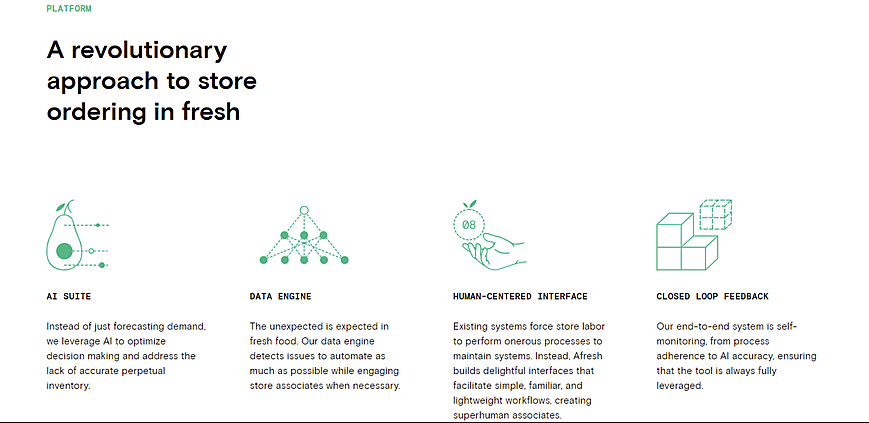
Afresh is a cutting-edge platform that assists retailers in determining the ideal production level by utilizing artificial intelligence and other technologies. Instead of glancing at the shelves, they can use Machine Learning algorithms to manage the inventories. The supply at the store should match the demand rather than exceeding it and wasting goods.
This is a perfect example of how businesspeople in the same sector can develop entirely new concepts. You can identify a genuine problem and create a digital solution to address it if you conduct thorough market research.
You put a lot of effort into starting your business. It now has sound fundamentals and efficient daily operations. The next step is to start the growing process. You want your business to start expanding its market share and revenue.
The best growth is one which is sustainable, produces short-term outcomes, and is in line with your long-term objectives. You don’t want to exceed your capacity or available resources. It’s difficult to figure out how to accomplish that kind of growth. It can be difficult to choose the course of action to assure growth.
You must offer yourself the best chance to pursue the appropriate growth paths. The best approach to achieve that is by fully comprehending the current state of your company. You must assess your advantages and disadvantages. Additionally, you must evaluate your position within the larger corporate context. A SWOT analysis is a tool that can greatly simplify this procedure.
What is a SWOT Analysis?
A common tool for assessment and evaluation is the SWOT analysis. It can be applied to many different fields. SWOT analysis is used by some people as a tool for personal development. It is used most frequently in business. There, it can support managers or boards in making wise choices.
SWOT is an acronym, as you have probably realized. Strengths, Weaknesses, Opportunities, and Threats are what it stands for. These can be analyzed to create a thorough picture of a firm’s current status.
Understanding the state of their company and where they fit within the industry is helpful for CEOs or other decision-makers. They benefit in numerous ways from that kind of comprehension. It aids them in:
• Determine issues with company processes or day-to-day operations
• Identify areas of strength that aren’t being fully leveraged
• Find and address organisational issues
• Evaluate the current workforce and what may be needed moving forward
• Locate areas of potential improvement
• Realise opportunities that can be grasped
A company must do all of those things to guarantee rapid yet sustained growth. Map out a path for sustainable growth by conducting a balanced assessment of your strengths, weaknesses, opportunities, and risks. This is why a lot of prosperous businesses use SWOT analysis to plan their expansion.
Performing a SWOT analysis
A SWOT analysis has two key components. The first step is to evaluate your company internally (the strengths and weaknesses). The second is to evaluate outside elements that might have an impact on your firm in the future (opportunities and threats). When creating a corporate plan, it’s critical to consider both internal and external elements.
It’s helpful to just analyze your own strengths and limitations. However, it won’t always offer the best route for progress. Not if factors outside of your control obstruct that specific route. Reviewing the internal elements should be the first step in your SWOT analysis.

Internal Focusses – Strengths & Weaknesses
You must first comprehend where you are in order to determine where your company needs to go. Finding out what your company’s strengths are is the first step toward gaining this understanding. What factors have contributed to your greatest triumphs to date? What distinguishes you favorably from your rivals?
It can occasionally be challenging to determine these strengths objectively. Here are a few typical examples to help you decide where to start:
• Positive and growing cash flow
• Superior customer services
• Skilled, dedicated and efficient workforce
• Effective branding and marketing
• Low employee turnover (this can be compared against the average for your sector)
• Strong and long-lasting relationships with clients
The greater number of these advantages you can pinpoint, the better. Not merely because it hints to the health of your company. Additionally, it provides you with more information to add to your SWOT analysis.
After making a list of your company’s key strengths, it’s time to move on to the flaws. These are simple for some managers and boards to identify. Others find them more challenging to pinpoint than corporate strengths.
Regardless of whatever side you belong to, it’s an important aspect of the analysis. When evaluating your flaws, you must be thorough and truthful. You may encounter various typical instances of vulnerabilities, such as:
• Low or falling profitability
• Limited staff resources
• A high number of negative customer comments or reviews, suggesting poor customer service
• Lack of expertise in a particular area (often related to a technological aspect of your operations)
• Low brand recognition or ineffective marketing
• Inflexibility of day-to-day operations or business processes
You need to shift your attention externally after identifying your strengths and limitations. The next phase of your SWOT analysis is that.
External Factors: Threats and Opportunities
You must analyze external issues as part of your SWOT analysis in addition to your internal condition and procedures. These are the factors that will affect your company going future. They could be favorable or unfavorable.
It is frequently more challenging to identify external influences than internal strengths and limitations. They can sometimes manifest as outside variables that you were not planning on. Unexpected events cannot be taken into account in a SWOT analysis.
However, you ought to be able to recognize a variety of chances. You’ll have access to them thanks to things that happen outside of your company. Some instances include:
• A new market related to that which you currently serve, which you could move into (this is where approaches like Blue Ocean Strategy can be useful)
• A new way of promoting your product or service, or a new marketing channel
• New technology which you could leverage to improve production or other operations
• Changes in legislation or regulations. These might ease a business process or open new markets
• A seasonal uptick in demand for your product or service
Identifying threats is a similar story. You won’t always be able to see such risks to your firm before they come up. A good understanding of your field will help, however. It should allow you to generate a fair list of prospective threats.
Some possibilities that may apply to your firm, depending on your niche, are:
• The establishment or growth of a competitor
• A new law or regulation which impacts your business operations or limits who you can sell to
• Falling demand for a product or service
• Negative media coverage of your industry or your firm
Practical Tips
When conducting a SWOT analysis, those are the major things you want to pinpoint. But how can you be sure your list is complete and accurate? A detailed list of opportunities, threats, and true strengths and weaknesses? Thankfully, it’s not too challenging.
The key is to involve the appropriate individuals and allow them the freedom to express themselves. The participation of corporate boards and decision-makers is essential. Their overarching strategy and plans will be shaped by a SWOT analysis. But it shouldn’t only be them who are asked for their opinions. You want a variety of viewpoints about your company.
This necessitates including a wide range of individuals in the process. Employees from various divisions, ages, and levels within the company should be included. Consider asking your suppliers, clients, or consumers what they think as well.
Before starting the analysis, each participant should try to come up with some of their own thoughts. These can then be combined in a group brainstorming exercise. That might encourage new ideas. Additionally, it will show what has been said the most frequently.
With these findings in hand, you may start evaluating the status of your company and formulating a strategy. Visualizing the strengths, weaknesses, opportunities, and dangers as a 2 × 2 matrix is a useful method for achieving this. That makes analyzing and comparing the points you’ve noted simple. From there, you can use them to create a growth strategy.

Evaluating & Planning For Growth
It’s time to turn the knowledge you’ve gained from your initial SWOT analysis into a practical growth strategy. The easiest way to approach this is as a cross-referencing process. You must consider how your opportunities, threats, opportunities, and weaknesses are related to one another. Additionally, you should consider how you may use the information from one category to address the issues from another.
The easiest method to do this is to ask yourself the following questions:
• Can we use a strength to maximise an opportunity?
• Can one of our strengths mitigate a threat?
• Is a weakness preventing us from seizing an opportunity?
• Does a weakness make us more vulnerable to a potential threat?
• Can we leverage an external opportunity to fix one of our weaknesses?
Your future plan will be based on the responses to these questions. They will show you where in your company you need to make improvements. They’ll demonstrate to you the chances you should try to seize. Most importantly, they’ll help you pinpoint actions that will promote growth.
When creating your plan, the objective is to rank these opportunities based on how they will affect your company and how long it would take to implement them. These can be broadly divided into short-term solutions that boost profits and long-term ones that need a lot of resources or take time to implement.
The next step is to prioritize these opportunities depending on the financial and human resources that are available after a well defined set of options are available. Of course, a compromise will be required. Everything cannot be done at once. The tricky component of the SWOT analysis is this.

Product Success Story: Funnel
In 2020, the SaaS product industry was dominated by the emerging tech startup Funnel. You must be familiar with the sales funnel and moving prospects through it if you work in marketing. This funnel served as the inspiration for the software-as-a-service firm called “Funnel” that organizes advertising and marketing data. It assists you in gathering, sorting, and transforming the gathered data and integrates with more than 500 data sources. This cutting-edge solution delivers accurate data to any destination for data.
Entrepreneurs can draw ideas from this product to capitalize on opportunities in the digital age and develop a solution that addresses any specific needs. In 2021, data will be more abundant than ever, and this startup capitalizes on that. This product can serve as an example for entrepreneurs looking for products that heavily emphasize the newest technology.

Exercise 2.1: SWOT – Strengths, Weaknesses, Opportunities, Threats

Course Manual 2: Purchase Situation Analysis
How to Perform a Situation Analysis for Strategic Planning
Successful companies understand how to locate and seize market share. But can every firm take advantage of opportunities that may arise? A situation analysis will assist a business in determining its advantages and disadvantages and how it can compete in the market.
What is a situation analysis?
An in-depth investigation of a company’s market presence based on both internal and external factors is known as a scenario analysis. It looks at a company’s existing and potential customers and how they react to its goods and services. An analysis of the present business environment and a company’s capabilities are also included.
Based on the choices made, an analysis can predict the outcomes a business can expect, allowing it to modify its tactics in order to achieve its objectives. Many significant facts about a company can be discovered by a situational analysis, including:
• The opinions and experiences of customers and stakeholders
• A business’s strength and weakness(es)
• How a company is capitalizing on market trends
• How it measures up to competitors
• What’s holding a business back from its desired goal(s)
• The current strategies in place to overcome the weakness(es)
A company should do situational analyses on a regular basis because the market is constantly changing due to shifting consumer wants and preferences. A routine situation analysis gives a business the knowledge it needs to develop a strategy for achieving its objectives.

Components of a situation analysis
If your plan isn’t producing the desired outcomes, analysis can help you adjust and make course corrections. Analysis can show how your firm is working. Several elements make up a situational analysis:
The company
A smart place to start is to evaluate a company’s vision, strategy, and goals—and whether or not they are being met. Examining the company’s performance by looking at sales, market share, and customer retention offers an insightful snapshot that shows whether the organization is succeeding in its objectives. You can use it to assess your competitors’ strengths and market share.
Product and services
A critical part of a situation analysis is analyzing present products and services as well as upcoming product launches. To ascertain how viable a new product or service will be, market research is required.
The target market can be identified and ways to enhance a company’s offers can be determined through a market analysis done with prospective customers who provide feedback or thoughts about the product, service, or pricing. Examine products and services independently to determine which ones best satisfy the demands of your customers and which ones require adjustment.
Distribution
The market study identifies the target market and the level of interest in a company’s goods or services. The competitive analysis contrasts your company with others that are like it. Important details about your company’s distribution routes can be learned from analyzing both.
The distribution section of a scenario analysis examines your product marketing strategy and compares it to that of your rivals to identify the most effective distribution channels for your company.
Opportunities
Market opportunities are represented by unmet or underserved needs. The success of a corporation depends on its ability to take that market share. But a company must first be aware of its advantages and disadvantages in order to successfully pursue an underserved market. How well your company can take advantage of opportunities can be determined using a SWOT analysis, which considers your strengths, weaknesses, opportunities, and threats.
A SWOT analysis often displays a list of data and is rather easy to generate.
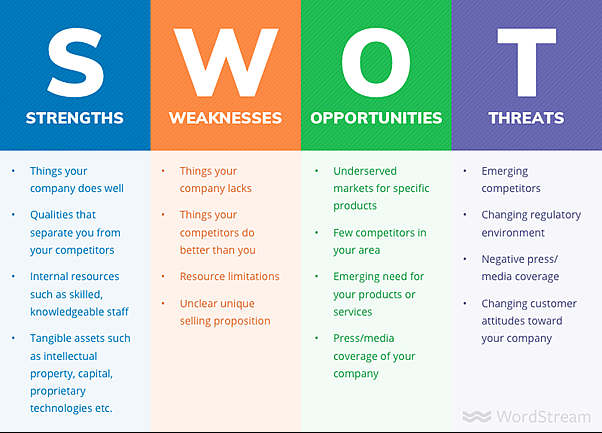
• Create four categories: strengths, weaknesses, opportunities, and threats.
• The strengths category should include internal systems and processes that are successful, competitive advantages, and assets such as technology, patents, expertise, and cash.
• Weaknesses include internal factors that keep your business from being more competitive, such as gaps in hiring or lack of funding.
• Opportunities are external factors that can aid your company such as regulation changes, upcoming press, and special events.
• Threats are external factors your company has no control over.
• List the appropriate information in each category box. Brainstorming is excellent for getting ideas and information onto paper. Save the ideas from the brainstorming sessions in each applicable box, and create an overall insight for each category. Once complete, pull together all the insights and summarize them.
• When performing a SWOT analysis, strengths and weaknesses are derived from an internal evaluation of your business, while opportunities and threats involve an external review.
Customer analysis
To understand your customers, conduct in-depth research. Gather information about the demographics, locations, interests, and difficulties of your customers. Once you have a solid understanding of your current clientele, you may pinpoint other potential clients as your target market and develop an efficient marketing strategy. Knowing your target market’s needs, tastes, and behaviors will help you choose the best approaches to addressing them.
Competitors
You can evaluate how well your company is doing by looking at your top rivals. Your organization can adjust to compete more successfully by identifying and contrasting the competitive advantages of various companies.
You can modify your company’s strategy to get an advantage by investigating the goods or services, sales, and marketing tactics of competitors. Your competition study should include information on a competitor’s market share as well as its advantages and disadvantages. You can use the SBA’s list of business statistics in your analysis.
Collaborators
Many company operations depend heavily on partnerships and collaborations. They consist of your company’s raw material suppliers, business partners, and distributors who might oversee your company’s manufacturing processes, vendor relationships, and supply chain.
Examine partnerships in order to determine their sturdiness and longevity. A corporation can gain insight into the dependability of these partnerships by reviewing contracts and examining whether goods and services have historically been supplied as promised.
Current business environment
A situational analysis should look at both the internal and external factors affecting a company’s success. The economy, rivals, governmental policies, and regulations are examples of external variables. A company’s internal aspects include its culture, workforce, financial management, and resources.
PESTLE analyses focus at the political, economic, social, technological, legal, and environmental aspects of a company’s external environment. A closer look at each category can reveal information about the broader business market. Take a closer look at each PESTLE analysis category:
• Political factors: the impact of government policies or elections
• Economic factors: how fiscal trends, current import and export trade ratios, and taxes affect a business
• Social factors: the effect of customer lifestyles and demographics
• Technological factors: how technology and innovation impact a business
• Legal factors: the impact of safety regulations and employment laws
• Environmental factors: how environmental regulations or climate change affect a company
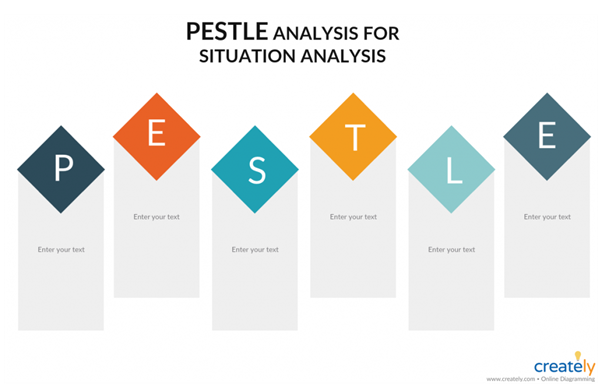
5C situation analysis example
The 5C approach may be the simplest way to conduct a situational analysis that takes into account both internal and external elements that have an impact on a firm. The 5Cs stand for company, customers, competitors, collaborators, and climate.
The firm component of a 5C study comprises information about the company’s mission and goals, as well as its market position, distribution, opportunities, and goods. Key data on prospective clients, the target market, and the opportunities a business should follow through a marketing plan are provided by the consumers.

The section on competitors indicates a company’s strengths and areas for improvement based on those of its rivals. Partnerships between collaborators enable the production of goods and their distribution. Climate encompasses elements including governmental initiatives and the state of the economy, as well as forecasts for the 2020 election.
To flourish in the market, you can detect the state of your firm as it changes by periodically doing a situational analysis.
More Resources
An organization’s growth and performance can be examined by using the strategic management technique known as STEEPLE analysis. It is an adaptation of the well-known PESTLE analysis.
Porter’s Five Forces
The competitive environment is analyzed using Porter’s five forces method. It examines the following elements that could impact an organization’s ability to compete:
• Supplier power
• Buyer power
• Competitive rivalry
• The threat of substitution
• The threat of new entry
Understanding the influence of competition in the market and industry, as well as how profitable it is to compete there, may be done by analyzing these variables.

VRIO Analysis

Another tool for assessing a company’s resources, including its financial, human, and other resources, is the VRIO analysis. It Stands for Value, Rareness, Imitability, Organization.

Examples of when people found a gap in the market: Video Doorbell
Jamie Siminoff’s video doorbell, the DoorBot, which captures activities outside the front door, was featured on the television program Shark Tank in 2013. He started it on his own even though the jury—er, sharks—didn’t make him an offer that was advantageous to him. The rest is innovation history as he changed the company to Ring and sold it to Amazon in 2018 for more than $1 billion.
Although we had security cameras and doorbells previously, this technology merged the two in a way that was accessible to most homes. According to Mike Falahee, president, and CEO of Marygrove Awning Co., “With just about everyone receiving packages, doorstep thieves have become a major problem,” The video doorbell is a widely used security measure to deter and capture thieves.” One of the safest smart doorbells for your house is the Ring.

Exercise 2.2: Photo Finish

Course Manual 3: Direct Competition Analysis
Growth requires competition, but only when a company accurately assesses its rivals and improves itself to stay up. Even in marketing, examining the competition is healthy and can motivate you to pick up new skills and change the way your company operates to better serve customers. Understanding direct and indirect competition and how each can affect your job is one method to achieve this. Knowing the variations will help you discover and assess your direct and indirect competitors in the best way possible.
What is direct competition?
Your immediate competitors come to mind when you consider a marketing competitor. Direct rivals are companies who operate in the same market as you and provide the same services for the same clients’ demands.
Let’s assume that your marketing company predominantly serves eateries in the western United States. You would have direct competition from other businesses that specialize in restaurant marketing in the western United States.
Direct competition will exist in even the smallest markets, which is crucial to preventing monopolies.
Direct Competition Examples
Direct competition is prevalent in many situations. Burger King, Wendy’s, and McDonald’s are all direct rivals. In a similar vein, recall the famed fast-food chicken sandwich wars, during which time prominent restaurant chains including Popeyes, KFC, Wendy’s, Zaxby’s, and others all introduced chicken sandwiches in an effort to target the same customer base across the United States.
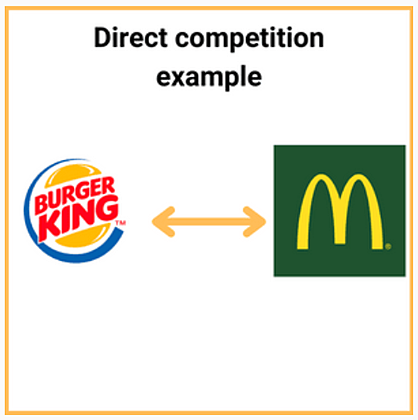
Not just big, national or worldwide brands are subject to competition. Direct rivals in a small, rural town are two women’s clothing businesses.
Direct rivalry is another issue for digital businesses. For instance, their target audiences can use services like direct messaging and disappearing stories on both Instagram and Snapchat.
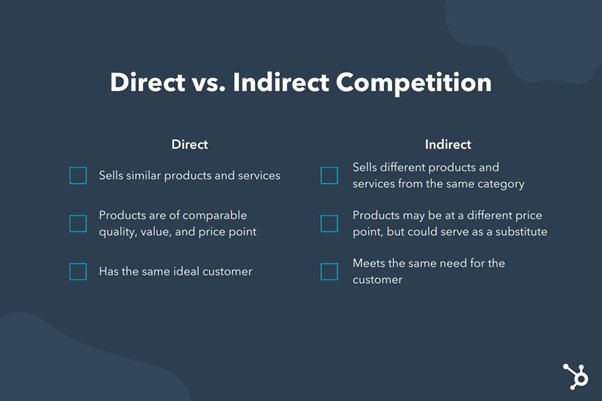
A company that serves the same target market as you and provides the same good or service is said to be your direct competition. It is important to initially identify your competitors before learning the critical details about their brand, product or service, sales and marketing tactics, customer experience, and other factors. The ultimate goal is to evaluate their advantages and disadvantages and capitalize on any areas where you stand out, or to identify aspects of their strategy that you can riff off and incorporate into your own. This process might start before you even establish your firm, but it should actually be ongoing as more competitors appear on the market and as businesses expand.
Why it’s important
If you want to stand out in the market, you need to be aware of where you are right now, who you are competing with, and what might be on the horizon. Competitor analysis can help you gauge your own growth. You can locate market gaps and pitch yourself to clients as a solution to those same problems by recognizing the vulnerabilities of your rivals. You may make sure you’re keeping up with how your industry is evolving and maintaining your competitiveness by focusing on their strengths. There is nothing wrong with drawing inspiration from others, even while you shouldn’t openly duplicate someone; it can assist shape your product, strategy, marketing, or other aspects of your business.
CB Insights, a business analyst, claims that the main cause of failure for 19% of startups is being outcompeted. You can’t afford to ignore this, especially in light of a recent study from market intelligence platform Crayon that claims 60% of small firms witnessed an increase in revenue as a result of investing in competition intelligence.
Things to note
Present it as “jobs-to-be-done” for your clients. The “jobs-to-be-done” hypothesis, which holds that customers select solutions to tasks they must complete or requirements they wish to satisfy rather than actual goods or services, is a valuable lens through which to view direct competition. Therefore, a company that performs the same function as you in a similar manner qualifies as a direct rival. Think about the various tasks that you and your competitors jointly complete. Pay attention to how quickly, precisely, and affordably you complete these tasks and how this is made obvious in your marketing materials.
Do it regularly. Businesses, sectors, and consumer needs all undergo change. Once your company is created, you’ll need to conduct research to determine how competitive the industry you’re in is (or how probable it is to cause your company to fail). This will probably occur quarterly or annually. Similar to when you’re making large decisions, like inventing new products or services or starting marketing campaigns, competition analysis is helpful.
Avoid being too fixated. Don’t stress over it, but, at the same time. Still, the value of your offering and the demands it satisfies should come first. Instead of serving as the sole deciding element in your choices, this study should be considered. If you spend all of your time worrying about what other people are doing, you’ll lose the essence of your company. Even if you just try to copy them, it’s unlikely that your imitation will ever be as good as the original, aside from the obvious legal issues.

How to research your direct competitors
1. Get organized. Determine at the outset how specific you need to be. Create the system you’ll use to accomplish these aims after establishing some end goals for the study process (such as being sure your product won’t be priced out). A spreadsheet with the proper columns might be used for this.
2. Understand your own profile. Understanding your company to the letter with a straightforward SWOT (strengths, weaknesses, opportunities, and threats) analysis will help you discover your competitors and emphasize the relevant information. Ask yourself the same questions you would ask your rivals.
3. Identify your competition. While some of this will seem intuitive, don’t just trust your gut. Ask your clients what other options they considered before choosing you. Look for keywords that describe what you do online and on social media. Browse media outlets that cover your sector. Make a list of five to ten rivals, depending on how saturated your market is.
4. Look for the company basics. Get a firm grasp on the structural foundations, such as the company’s history, the identities of its founders, the number of employees and their various positions, the nature of its funding (if applicable), and its culture. Some of this data can be used to benchmark your growth, while other data can help you find investment opportunities and learn how to hire the best candidates.
5. Look into their product or service. Now that you know how businesses operate, look at what they are putting out there. Look closely at their line of products or services, taking note of things like target market, pricing strategy, manufacturing details, and product attributes. Think about the advantages and disadvantages of their product.
6. Look into how they market their brand. Go beyond the goods and consider their external brand presence. That might begin with any current print or online advertising campaigns, their general media presence, or a thorough investigation of their social media presence. Think about the kind of content that social media platforms post, the level of engagement they receive, and the demographics of their audience. You can track all of your competitors on websites like Hootesuite and use tools like BuzzSumo to analyze what content is performing well.
7. Think about customer perspective. Test the user experience of your competition by acting like a client. Consider the customer journey, starting with an internet search for the company and ending with the actual purchase (but don’t do it). If it’s a physical location, visit it as a consumer to get a feel for it. Check the opinions of their clients outside of your own experience by visiting the pertinent review sites and looking for recurring themes in comments on their social media channels.
8. Review strengths and weaknesses. It’s time to examine your results. Make a list of each of your competitors’ specific strengths, flaws, and points of differentiation. You want to understand what you provide that your competitors don’t, as well as anything substantial they are doing that you aren’t. Your opportunities and dangers should become more clear in light of this information. Keep in mind that you are trying to determine your company’s unique selling proposition (USP). If one doesn’t emerge from this process, you’ll need to act swiftly and make calculated decisions based on your research to ensure that it does.
Key takeaways
• The main steps in conducting direct competition research include selecting the appropriate companies, conducting systematic research on them, and analyzing your results.
• The goal is to leave with a clear understanding of the landscape and of what your own USP is.
• Competitive analysis shouldn’t define your company’s identity, but it can highlight internal weaknesses and market gaps.

Examples of when people found a gap in the market: Adidas
Adidas’ Adi Dassler
No one exemplifies the humble beginnings of some of today’s greatest brands more than Adidas founder Adolf “Adi” Dassler.
In a little German town called Bavaria, Dassler’s shoemaking career had its start in his mother’s bathroom. It was there that Dassler started creating and tinkering with shoes and made the decision that he wanted to create the best sports shoe for athletes.
Despite the fact that there were many shoe manufacturers at the time, Dassler was committed to differentiating his products by asking athletes for their opinions on the features they wanted in a shoe, any problems that needed to be fixed, and their impressions of his prototypes.
When Dassler registered “Adi Dassler Adidas Sportschuhfabrik” in 1949 at the age of 49, it provided him respectability and enabled him to create an athletic shoe that was highly loved by his consumers. The first pair of shoes with the soon-to-be-iconic Adidas three stripes were registered in that same year.
In 1954, the German national football team defeated the Hungarians in the World Cup final wearing the brand-new Adidas cleats, demonstrating Dassler’s aim to design the ideal shoe for sportsmen.
“Their unbelievable victory would be heard around the world for decades to come,” Adidas states on its website, “and it made Adidas and its founder a household name on football pitches everywhere.”
Since then, Adidas has developed into a global brand recognized for its premium athletic apparel. The narrative of Dassler emphasizes the value of hearing the goals, requirements, and problems of target clients.
According to Adidas’ website,“Adi Dassler’s secret to success had an additional personal ingredient: He met with athletes, listened carefully to what they said, and constantly observed what can be improved or even invented to support their needs,” “The best of the best trusted Adidas and its founder from the beginning.”

Exercise 2.3: Human Knot

Course Manual 4: Indirect Competition Analysis
What is an indirect competitor?
While providing distinct goods or services, an indirect rival meets the same client needs as another business does. For instance, a food vendor selling chicken tenders has an indirect rival from one selling baked bread. Despite selling various goods, they both cater to clients who desire meals.
Here, a company’s clients could have to decide between your solution and one from a rival. The cost of transferring from one good or service to an indirect rival is typically considered by the customer. As a result, elements like flavor and price have an impact on a consumer’s purchase decision.
Indirect vs. direct competitors
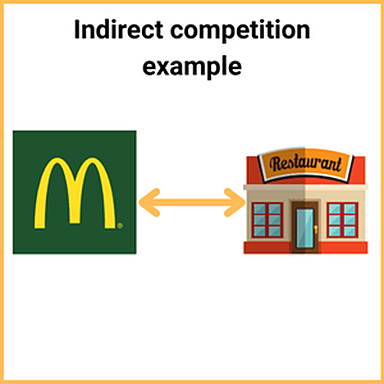
Despite the fact that both direct and indirect competitors could have an impact on a firm, there are several distinctions between them:
Effects on businesses
Since they serve the same market and provide comparable goods and services, direct competitors frequently foster a more intense competitive environment. In contrast, although they have an impact on a company’s market share, indirect competitors don’t pose the same threat to a customer base as direct rivals. They cater to the same general need while offering various products.
Product similarity
Direct rivals provide products that are very comparable to those of the target company, but with a different brand name and identity. For instance, two distinct brands that sell footwear to customers in the same area are in direct rivalry with one another. In contrast, indirect competitors provide different items than a specific company yet can meet all market demands. For instance, because they both provide beverages to customers, albeit different ones, a coffee shop and a juice bar are indirect competitors.
Price determination
Analyzing your immediate competitors can be useful in deciding the pricing of your goods or services since they can provide insight into the market worth of goods and services. Because the prices of these competitors’ goods or services do not affect the prices of your goods or services, their pricing is typically different from yours. Instead, price decisions take into account the cost of production, raw materials, and other such criteria.
Relationship with customers
Customers may choose to purchase cheaper products from a direct competitor if you raise the price of your offerings. Therefore, customers are more powerful in the market than businesses that compete directly with them. However, some consumers may not respond to price rises in indirect competition because they are more focused on personal preference and the satisfaction they receive from using a good or service.
Market conditions
Direct competitors share the same market circumstances, advantages, disadvantages, threats, and opportunities. Direct competitors don’t always have the same difficulties as one another. They might just be vying for the same group of customers.
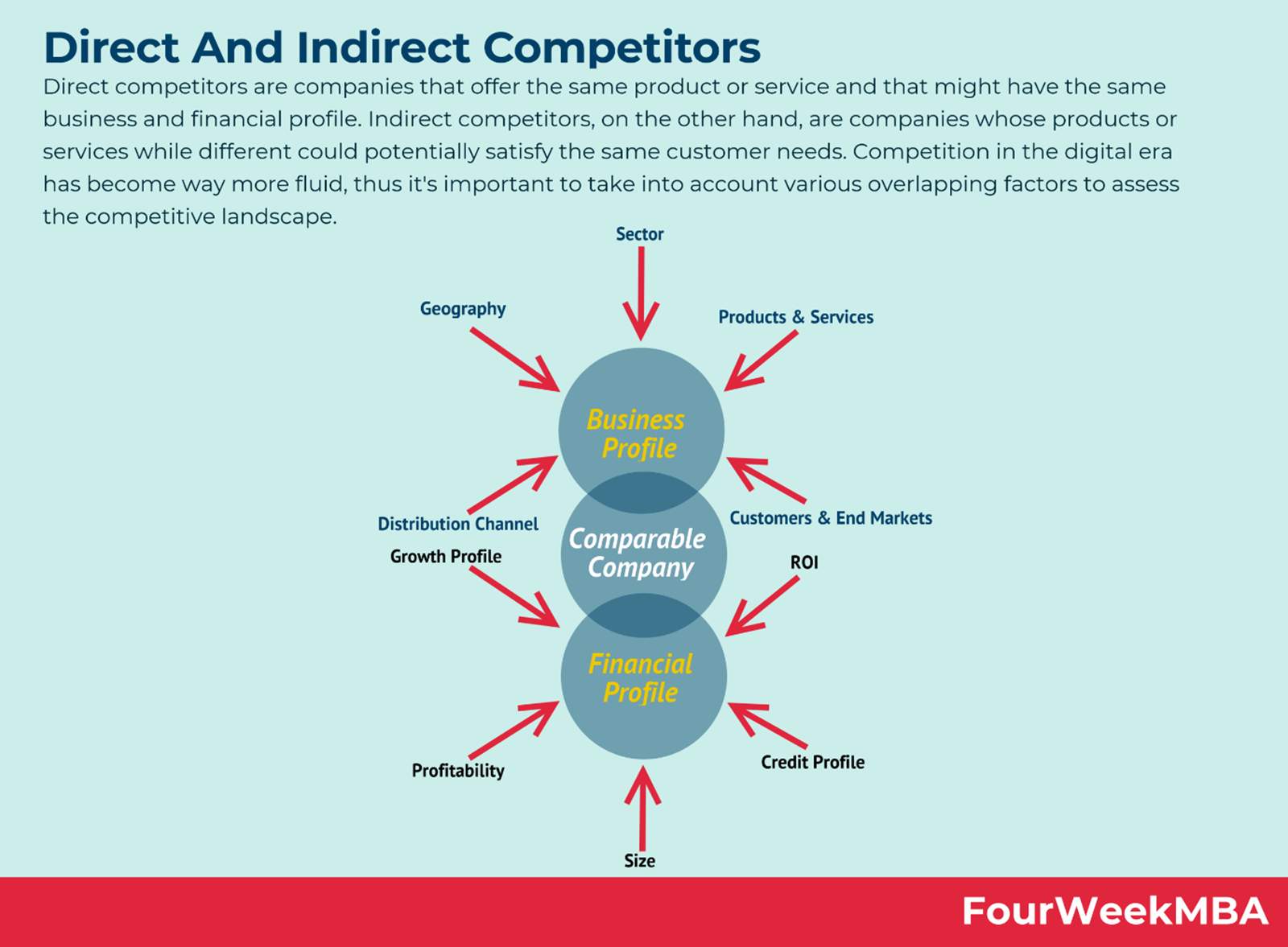
Examples of indirect competitors
Some examples of indirect competitors include:
Example 1
A company called Crispy makes chocolate, whereas Berry makes cookies. Despite not being the same products, both are snacks for people. Sometimes people could favor chocolate, while other times they might prefer cookies. Additionally, Berry’s sales don’t abruptly increase as the price of chocolate does.
Example 2
Unlike Light, which makes pasta, Brave is a rice-producing enterprise. Pasta and rice are distinct foods that cannot be substituted for one another. Despite not directly competing for the same market, these two businesses are in conflict since they both produce food products.
Example 3
While Stonewalls is an amusement park, Lead is a theater. Consumers who want to unwind and have fun can think about going to a movie or touring an amusement park. Since they fulfill the same consumer need while doing business in various ways, this makes them indirect competitors.

What to include in a competitor analysis
To create a comprehensive analysis, include the following information:
Competitor identification
Create profiles for each of your brand’s competitors before you do a competition analysis. Include any businesses that operate in the same market and provide the same goods and services. Your largest rivals, possible rivals who might enter your market, and pertinent start-up businesses expected to appear in the upcoming year are all included in a competition study. You may assess the strength and investment required for your marketing tactics by having a clear understanding of the level of business rivalry.
Competitor information
Once you are aware of who your rivals are, gather data that will enable you to carry out a complete analysis. Ensure that you have the following details for each of your rivals:
Products and services: List each competitor’s advantages and disadvantages for each of their offerings. You may produce goods and services that are of higher quality and customer satisfaction by having a deeper understanding of both.
Pricing: This is the cost of the goods and services offered by your rivals. For instance, if they price $50 for a product, you would think about charging $45 for a comparable item. You could be able to increase your profit margin as a result of additional customers wanting to benefit from the lower pricing.
Finances: Be sure you get the share prices and earnings reports of your rivals. You can evaluate their financial situation thanks to this.
Customer experience: Recognize the level of customer service offered by rivals. You can then decide how you can get better.
Check for any intellectual property rights, such as patents, trademarks, or copyrights. Knowing this can help you anticipate any upcoming items they haven’t yet made public and can also tell you if they own the rights to a product, which can assist you avoid any potential legal problems.
Marketing initiatives: Learn about the occasions, promotions, social media pages, and advertising campaigns of your rivals. Think about how you may modify your marketing initiatives to more successfully complement their strategies.
Find out how much of your target market is aware of your competitor’s brand. If you notice that your rival’s brand is easier to recognize, you might come up with tactics to raise brand recognition.
Locate the main office of the competitor and the locations where they distribute their goods. Determine if it is worthwhile to reach out to these places as well by taking into account the territories or nations they cover.
Objectives: Recognize your rival’s objectives to better anticipate their future behavior. Consider investigating their organizational structure, risk tolerance, and managerial motivations. You can tell which functions they value the most by looking at their organizational structure, in particular.
Resources and abilities: These terms refer to what your rival is doing or is capable of. Think about how quickly they respond to challenges like changing market conditions or client demands. To achieve this, consider both their advantages and disadvantages.
Strategy evaluation
Your analysis of a competitor’s tactics is part of the competitor analysis. Determine each one’s benefits and strengths as well as any potential threats. Identify their flaws as well. For instance, think on what they’re doing incorrectly so that you can improve. Predict their behavior and make well-informed decisions based on the knowledge you have collected to support the brand.

Examples of when people found a gap in the market: Whitney Wolfe Herd of Bumble
After leaving the violent relationship she was in using the dating app Tinder in 2014, Whitney Wolfe Herd was motivated to design a positive dating environment for women.
“For all the advances women had been making in workplaces and corridors of power, the gender dynamics of dating and romance still seemed so outdated,” Wolfe Herd writes on Bumble’s website. “I thought, ‘What if I could flip that on its head? What if women made the first move and sent the first message?’”
Wolfe Herd, along with dating app Badoo co-founder Andrey Andreev and former Tinder employees Chris Gulzcynski and Sarah Mick, designed a dating app that requires women to make the first move in heterosexual matches.
The brand took off—largely on college campuses—and the app reached 100,000 downloads in its first month.
As its user base expands, Wolfe Herd continues to be a major supporter of gender equality and the elimination of sexual harassment by developing in-app technologies that suppress offensive photos and suppress hate speech. Additionally, Wolfe Herd and her group pushed the Texas legislature to enact a law that forbade the transmission of unsolicited indecent images, which was successful in 2019.
“I’m more dedicated than ever to helping advance gender equality—and putting an end to the misogyny that still plagues society,” Wolfe Herd writes in a letter to Bumble users. She later adds, “I want nothing more than for your connections to be both meaningful and healthy.”
Wolfe Herd’s tale serves as a reminder to draw inspiration from your personal experiences when starting a business and to leverage a cause that matters to you to set your goods and brand apart in a crowded market.

Exercise 2.4: Human Snakes

Course Manual 5: Analysis of Complementary Products and Services
An item that is purchased along with the primary product is referred to as a complimentary product. Complementary items, including gasoline, SIM cards, and baking powder, frequently offer little value or cannot be utilized independently because these products are used in tandem.
We’ll discuss the benefits of complements for brands, how they vary from alternative products, and give some instances in this course manual.
Why do brands use complementary products?
Retailers frequently raise the price of a complimentary product while raising the price of a basic one to stimulate sales. Such a package appears advantageous to customers. Retailers position these bundles next to one another after analyzing consumer demand. Ravers and blades, flour and baking soda, laundry detergents, and fabric softeners are all sold in stores in this way. In this approach, businesses can boost their sales volume and revenue.
However, the cross elasticity of demand for complementary goods is negative. Because the complementary item frequently adds little value on its own, consumer demand for it declines as the price of the primary item rises. As a result, sales volume for businesses declines sharply, forcing retailers to lower the price of the main item to cover costs.
Let’s establish the distinction between complementary and substitute products since they can occasionally be confused.
Complementary Products vs. Substitute Goods
The core product and complementary items are closely related. They are frequently difficult to swallow alone. As a result, demand for the complementary product is created by demand for the primary product. Marketers either offer them jointly or advertise a related product after they sell the first item. In this approach, they can boost sales.
The characteristics and problem-solving capabilities of substitute products are identical to those of the original product. As a result, they are interchangeable. Customers can purchase Xbox instead of Play Station, Samsung Galaxy in place of an iPhone, and margarine in place of butter. When a product they want becomes more expensive, consumers start looking for alternatives, which lowers the demand for that product.
You can now clearly distinguish between complimentary and substitute products and understand how they are related economically. Time to look at some illustrations.
Examples of Complementary Products
Several illustrations of complementary goods have already been provided. These are products that cannot be used without the primary products; for instance, a SIM card cannot be used without a mobile phone, fuel cannot be used without a car, and baking powder cannot be used without flour. We’ll now give some examples of complements that are advertised alongside their main offering:
• Mobile device accessories (cases);
• Boot polish;
• Tennis rackets and a ball;
• Game consoles and games;
• Hair straighteners and heat protection;
• Laptop bags;
• Cartridges for a printer;
• Spices for meat and fish;
• Laces for sneakers;
• DVDs for DVD players;
• Bullets for guns;
• Brushes for eyeshadows.
Complementary Goods Graph
According to the graph below, there is a direct correlation between the price of an iPhone and the demand for iPhone cases. This is due to the fact that when more people purchase iPhones at reduced rates, there is an increase in demand for them. The desire from the same customers for iPhone cases leads to increased sales.

How do businesses use the concept of complementary goods?
• Hook and Reel: Some businesses decide to offer a product for a low cost, but then charge more for accessories. Typically, the more expensive item is the one that is “consumable.” For instance, razors are frequently marketed for cheap, but razor blades cost more. As a result, they are able to sell the consumable blades repeatedly and make a steady income. Strong complementary commodities work very well with this tactic.
• Bundled Packages: A restaurant may not sell drinks to patrons. But beverages actually have a very high margin of profit. Restaurants are now able to sell more drinks and pocket the profits by pairing drinks with the main course for a “special price.” Typically, weak complementary products are involved.
• Subliminal Messaging: To boost sales of both products, supermarkets will put complimentary food items next to one another, such as chips and soda. These complimentary products can be powerful or weak.

How To Turn Complementary Products Into A Marketing Tool?
Consider yourself the manager of a store that has an excess of hot dogs. You choose to make a “outside barbeque” display to increase sales by stacking a variety of accessories (such as condiments, buns, napkins, plastic forks, and beer) on top of the case containing the hot dogs.
Would such a tactic be effective at luring customers to the hot dogs? If so, how should the complementary display be set up to draw in the most customers?
The Salient Power Of Complementary Product
Strategies for in-store marketing are crucial for promoting goods in a retail environment. This is mostly a result of the fact that consumers make many unplanned decisions.
Utilizing complimentary “other products” as a marketing tactic to boost sales of a primary product is one in-store strategy. Products that complement a focal point can increase their value.
For instance, a customer may be primed to create meal ideas after seeing the barbecue display, increasing their likelihood of purchasing hot dogs.
But how do complementary product displays (CPD) work to draw customers’ attention to a focus product that’s linked with them and make them more likely to choose that product?
The Role Of Visual Complexity
The human brain has a finite capacity for visual attention, according to theories of selective attention and cognitive load in neuromarketing. As a result, individuals filter sensory information based on specific physical traits of visual stimuli. Understanding the characteristics of visual stimuli that are most likely to draw selective attention has been the subject of a rich literature. For example, studies have shown that design elements like shape and contrast can rule the first stage of the search.
The visual Complexity of any in-store display of complementary goods is a distinctive feature. “the amount of variety or diversity in a stimulus pattern.” is how it is defined.
The variety of complementing products’ colors, sizes, and shapes in the selection is one element that may affect how complex a CPD is. While high-complexity CPDs offer customers a wide range of options that complement or enhance the focal or main product, low-complexity CPDs can make consumers’ decision-making processes simpler.
High-complexity Because they contain a variety of products that differ on one or more dimensions, CPDs are excellent at attracting customers’ attention. These displays should stand out from the background and contrast with it to attract attention.
This claim is supported by studies that demonstrates how attention can be attracted to and maintained by stimuli with high “design complexity,” or complexity based on variation in shapes, objects, and arrangements. It is also in line with research on choice overload, which shows that although consumers were less likely to choose from high-complexity assortments in the end, they were initially more drawn to and engaged with them.
These ideas are helpful in identifying attention capture, but they appear to be less helpful in outlining an attention transfer mechanism. This then introduces us to a different intriguing notion.
How Attention Is Transferred
According to the Guided Search Theory, attention is guided during a multi-step search by a combination of “bottom-up” (stimulus-driven) and “top-down” (goal-driven) search processes.
According to the Guided Search Theory, using complementary products can start a “bottom-up” search process that could then result in a “top-down” search and focus consumers’ attention on the primary or focal product.
For instance, a customer may focus on a brightly colored box in a retail display at first (bottom-up), but shift their focus to the items in that display that best meet their needs right now (top-down).
Bottom-up process stimuli may have correlations with top-down search that are relevant.

How High Complexity CPDs Influence Consumers Decision-Making
According to Guided Search Theory, associations with the complementary product category lead to top-down search goals that focus consumers’ attention on the focused product after they have already paid attention to the CPD.
For instance, seeing a variety of condiments that are frequently used with hot dogs may inspire a desire to hunt for the hot dogs themselves. Longer consumer attention to the CPD should therefore lead to more consideration and a higher possibility that the customer will select the focal product.
Therefore, having a high-complexity CPD will make it more likely for customers to select a related focal product.
Even while research has shown that visual complexity can have an impact on attention, systematic variety in shapes, colors, and sizes has been shown to improve attention to stimuli because it makes them more fascinating, likable, and engaging. Furthermore, research has shown that customers are more attentive to shelf configurations with aesthetically appealing features, such as vivid colors.
According to research, a CPD will be able to draw in more consumer attention the more visually sophisticated it is. Additionally, the more customer attention the CPD manages to garner, the more attention the focused product will manage to garner.
The likelihood that the focal product will be chosen should rise with increased visual attention. For instance, a simple exposure effect can cause a preference for an alternative to increase with longer gaze durations. This is due to the connection between capturing attention and ultimately choosing a product.
This implies that buyers are more likely to select the focal product if it receives more attention.
Therefore, the focus shifting from the CPD to the focal product will mitigate the impact of CPD complexity on the focal product selection. This is due to the fact that drawing more attention to the main product should make buyers more likely to select it.
Implications For Brand Managers
Brand managers need to be aware of the numerous obstacles they face. Items today fight for consumers’ attention not only with other products, but also with their cell phones, friends, and other distractions.
The fact that humans are typically creatures of habit just fuels the fire. Regular clients who are accustomed to the store’s layout and display cases frequently follow their “usual route” and fail to see anything besides the items they are looking for.
Planning in-store marketing strategy has never required “upping our game,” but it must now. One excellent strategy is to place displays of complementary products strategically close to focal products, since research demonstrates that doing so can boost sales of an associated focal product.
However, it’s crucial that you are conscious of how striking the CPDs they position are aesthetically. Although visual complexity has received a lot of attention as a characteristic that boosts a CPD’s salience, you could also wish to apply other techniques, such increasing the CPD’s size.
Additionally, it can be a particularly successful method of selling goods that are not shown in front of customers (freezers, meat, lower shelves, etc.).
Therefore, managers may wish to utilize CPDs to draw attention to products that are stacked somewhere, either because they are not at eye level or because they are housed in some form of container, rather than marketing focus products that already occupy premium shelf space.
There is so much possibility.
This strategy can also be used to market surplus products much more quickly. In that situation, the item with a high supply becomes the main focus.
The most crucial step is to continue trying until you find the ideal mixture.
Take-Home Points:
• Customers are more likely to notice shelf configurations with visually appealing features.
• Extensive-choice displays are more appealing to customers than limited-choice displays (even though they are less likely to choose from these displays).

Challenges of Complementary Goods
Nowadays, the majority of large businesses invest a lot of time and resources on identifying and creating the best methods for increasing product sales.
This frequently uses the “peanut butter and jelly” sales technique of partnering with other products on the market that are extremely compatible—or complementary. Cross-selling, a long-standing brick-and-mortar retail tactic, has now developed into a highly successful online strategy.
Naturally, since every business is different, choosing where to display objects AND which products to put with them may be a challenging process. To make matters worse, it may be practically impossible to review, analyze, and strategically use each of the vast array of retail touchpoints available today.
Complementary matching may be a challenging and dynamic process depending on audience goals, geographical quirks, consumer expectations, competitive strategies, and market evolution. Brand managers must consistently analyze trends and statistics because the world is changing at a rapid pace.
How to overcome those Challenges?
While there are many digital tools available to help businesses cross-sell, the majority are unable to consider all the important factors before making a final decision. The monitoring features of PriceSpider are useful in this situation.
Thanks to the simplicity of a beautifully designed dashboard, digital marketers and brand managers now have a 360-degree view of their product pages across the websites of their retail partners.
Using tools like Where to Buy, businesses can track clients all the way to the transaction and see precisely what they bought after they left your website, even if they didn’t purchase your products.
This might help not just in designing a more attractive digital display overall, but it might also help determine which complementary products have the best chances of succeeding.
The value of the primary product is increased by complementary goods. They give managers the ability to base investment choices for the creation of a new product on variations in the price and demand of replacement products.

Examples of when people found a gap in the market: Melanie Perkins of Canva
While attending school in Perth, Australia, Melanie Perkins worked a part-time job instructing students how to utilize desktop design software. Perkins inquired, “Is there a way this could be simpler and less expensive? The program was pricey, sophisticated, and required a semester’s worth of instruction to understand how to operate.”
Over 100 funders initially rejected Perkins’ plan to provide an affordable, straightforward, online design tool; it took three years of pitching before Canva obtained its first financing.
Perkins attributes this investment to a change in her presentation technique, where she started out by introducing the relatable problem that Canva is trying to tackle.
“A lot of people can relate to going into something like Photoshop and being completely overwhelmed,” Perkins said in an interview for Inc. “It’s important to tell the story, because if your audience doesn’t understand the problem, they won’t understand the solution.”
Canva is now used by 60 million users to generate designs in 190 nations.
The success of entrepreneurs is dependent on their ability to persuade others of the value of their company ideas, and Perkins’ experience illustrates this point.

Exercise 2.5: Blind Drawing

Course Manual 6: Analysis of other Industries
Businesses and analysts use industry analysis as a tool for market analysis to comprehend an industry’s competitive dynamics. It aids in their understanding of the state of an industry, including statistics on demand and supply, level of industry competition, industry’s competitiveness with other emerging industries, industry’s future prospects in light of technological advancements, its credit system, and the impact of outside factors.
An entrepreneur or business can use industry analysis as a tool to better understand where their company stands in relation to other industry players. It gives them a clear understanding of the current and future state of the sector and assists them in identifying both opportunities and risks that may affect them. Understanding and utilizing the contrasts between yourself and your industry competitors can help you survive in this always shifting business environment.
Types of industry analysis
There are three crucial and widely utilized approaches for conducting industry analysis. These three approaches are:
1. Competitive Forces Model (Porter’s 5 Forces)
2. Broad Factors Analysis (PEST Analysis)
3. SWOT Analysis
1. Competitive Forces Model (Porter’s 5 Forces)
In his 1980 book “Competitive Strategy: Techniques for Analyzing Industries and Competitors,” Michael Porter established one of the most well-known models ever created for industry analysis, popularly known as Porter’s 5 Forces.
Porter claims that a study of the five factors provides a reliable picture of the market and facilitates analysis. These five forces as well as a sixth force, the strength of complementary good and service suppliers, are covered in our course on corporate and business strategy.
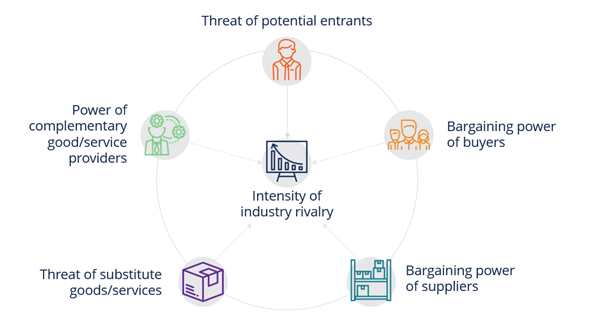
The portion of the Corporate & Business Strategy Course at CFI that produced the image above.
Intensity of industry rivalry
An immediate indicator of an industry’s competitiveness is the number of participants and their respective market shares. All of the aforementioned elements have an immediate impact on these. Lack of product differentiation usually makes the rivalry more fierce. The rivals have to work a little bit harder to win the struggle due to high exit costs such costly fixed assets, limitations from the government, labor unions, etc.
Threat of potential entrants
This shows how simple it is for new businesses to enter the market of a specific sector. Businesses constantly run the danger of new competitors if an industry is open to entry. If entry is challenging, the firm with the smallest competitive advantage benefits for a longer length of time. Additionally, businesses that enter a market under challenging conditions face a steady stream of rivals.
Bargaining power of suppliers
This is speaking of the suppliers’ negotiating position. If there are only a few suppliers in the business, they have a lot of negotiating leverage. Because it directly affects the end product’s quality and cost, small firms are particularly vulnerable.
Bargaining power of buyers
When customers have more bargaining power, the exact opposite occurs. Market power gives consumers/buyers the ability to bargain for cheaper costs, greater quality, extra services, and discounts. This is true in a market where there are numerous rivals but where a single customer accounts for a sizable portion of sales.
Threat of substitute goods/services
The industry is constantly in competition with another industry that makes a comparable replacement product. All businesses within an industry therefore have potential rivals from other industries. Because they are unable to charge outrageous pricing, this has an impact on their profitability. Products having the same function or quality but a lower price can be substitutes, as can products with the same price but higher quality or more utility.

2. Broad Factors Analysis (PEST Analysis)
PEST, or Political, Economic, Social, and Technological, analysis is another name for the broad factors analysis. A relevant framework for examining the external environment is PEST analysis.
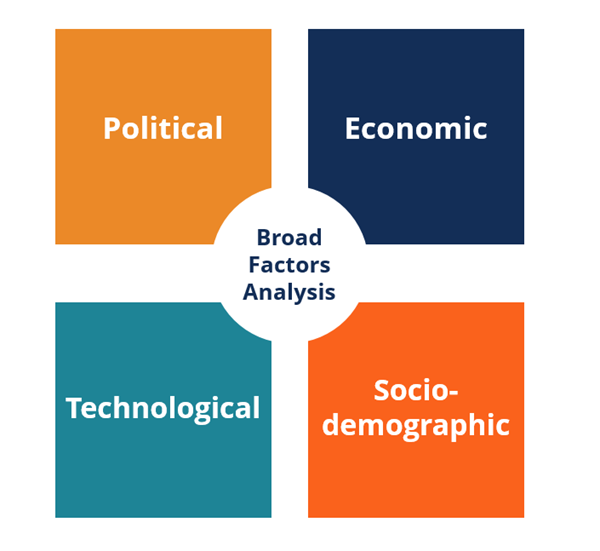
The portion of the Corporate & Business Strategy Course at CFI that produced the image above.
In order to employ PEST as a method of industry analysis, an analyst must examine each of the model’s 4 elements. These elements consist of:
Political
Political variables that affect an industry include specific tax, trade, environmental, labor, and political stability policies and regulations, as well as policies and regulations relating to ease of doing business and political stability generally.
Economic
Inflation, foreign exchange (FX), interest rates, GDP growth rates, market conditions (access to capital), and other economic factors are among those that have an effect.
Social
The social influence on an industry relates to societal trends, which might include population growth, demographics (age, gender, etc.), and behavioural trends like those in fashion, health, and social movements.
Technological
The technological component of PEST analysis takes into account elements like innovations and advances that alter how a firm functions and how individuals live their lives (e.g., the advent of the internet).

3. SWOT Analysis
Strengths, Weaknesses, Opportunities, and Threats is often known as a SWOT analysis. It can be a terrific technique to summarize different industry factors and ascertain what they mean for the particular business.
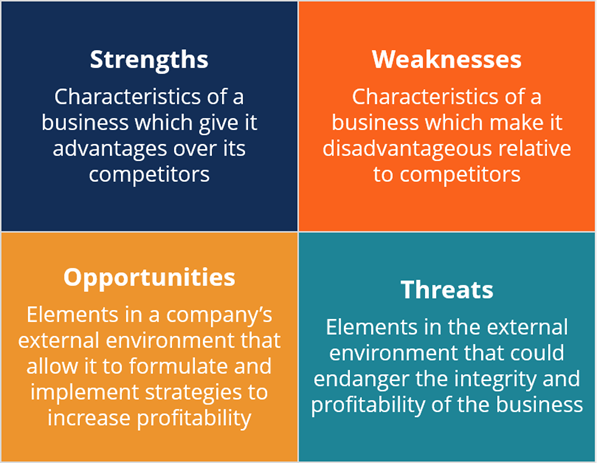
The portion of the Corporate & Business Strategy Course at CFI that produced the image above. To find out more about conducting a SWOT analysis, check it out.
Internal
internal elements that already exist, have influenced the situation, and might do so in the future.
External
External influences are typically contingent occurrences. Based on their chance to occur and potential effects on the company, determine their relevance. Also take into account whether management has the desire and capability to seize the chance or avert the threat.

Importance of Industry Analysis
Because it enables a corporation to comprehend market circumstances, industry analysis, as a sort of market assessment, is essential. It aids in the forecasting of supply and demand, and therefore, the financial results of the firm. It shows the level of industry competition and the expenses of entering and leaving the market. It is crucial while preparing for a small business. An industry’s present stage can be determined by analysis, including whether it is still expanding and has room for growth or whether it has hit its saturation point.
Entrepreneurs can have a firm grasp on the industry’s processes and possibly find untapped prospects by conducting a very thorough research of the sector. It’s also critical to realize that industry analysis is not always accurate and does not ensure success. Entrepreneurs may make poor decisions or follow the wrong route if data is interpreted incorrectly. It is crucial to carefully gather data as a result.
What Are Some Effective Industry Analysis Tactics?
Industry analysis will require time and effort to complete. This type of examination takes a lot of time and is fairly difficult. If you overlook any of the crucial information, your analysis will be flawed. However, there are some actions you may take to increase its efficacy and likelihood that it will be accurate:
Look at What Has Already Been Documented
There are probably already a ton of reports from the industry that apply to your analysis. Take your time and read them all. Investigate these reports further to see if it makes more sense. Some of these materials will be so comprehensive that you won’t even need to do any industry research. This is not to say that you should just rely on reports that have been written in the past.
Keep in mind that every industry is undergoing ongoing change, and that some are more volatile than others. Choose the most recent report you can to get the most up-to-date picture of the situation.
Be Choosy About the Industry You Analyze
There are numerous sub-industries in each industry. Organic chemicals, insecticides, and so forth will be categorized as chemicals. Choose the sector that is most pertinent to you when choosing an industry, and concentrate on it.
Study the Supply and Demand of the Industry
The main elements that govern a market are the interactions between supply and demand. You should consider the likelihood of these elements for a particular product, do a trend analysis based on prior trends, and use the findings of that research to make future predictions.
Study Your Competitors
You must consider your rivals and what you may anticipate from them. The Porter Five Forces Model is the most appropriate one to apply in this case.
Study Recent Developments in the Industry
Take a macro perspective on the elements affecting the sector. New developments, comparisons with related industries around the world, and other elements are among these.

Examples of when people found a gap in the market: Neil Blumenthal, Dave Gilboa, Andy Hunt, and Jeff Raider of Warby Parker
Entrepreneurship Essentials uses Warby Parker as an innovative example of an internet eyewear company. Blumenthal, a Wharton MBA student, misplaced his prescription spectacles in 2008. Because they were so pricey, he was hesitant to get a new pair. Additionally, he had no desire to go shopping for glasses.
He instantly emailed Gilboa, Hunt, and Raider after having the thought in the middle of the night: Why not start an online company to sell prescription glasses at an affordable price?
As soon as the four founders had their MBA degrees in the spring of 2010, they got to work, and Warby Parker was ready to debut. That is, until GQ contacted Blumenthal about writing a piece that would be published on February 15 of that year. The Warby Parker website was up the same day the article was published because the entrepreneurs accelerated their workflow.
The article referred to Warby Parker as “the Netflix of eyewear,” which attracted a lot of eager visitors to the brand-new website. The founders’ one error was failing to include a “sold out” feature in the website. Warby Parker’s eyewear waitlist increased to 20,000 customers, and the business reached its first-year sales goal in just three weeks.
According to Blumenthal in an interview with Inc., “It was this moment of panic but also a great opportunity for us to provide awesome customer service and write personalized emails to apologize and explain,” That really set the standard for how we would do customer service, in my opinion.
At the time, Warby Parker stood out from the eyewear industry for the following reasons:
• Its online model: A new way of delivering the product helped it break into a stagnant industry
• Its affordable prices: A pair of Warby Parker frames with prescription lenses cost $95—much less expensive than other brands at the time
• Its home try-on program: This enabled customers to try on five pairs of glasses and send back the pairs they didn’t want to purchase.
• Its commitment to giving back: For every pair of glasses purchased, Warby Parker donated a pair to someone in need
As an example of innovation in an established business, Warby Parker gave one million pairs of spectacles in 2019.

Exercise 2.6: Sneak A Peek Game

Course Manual 7: Foreign Markets Analysis
Steps in Conducting a Foreign Market Analysis
The primary objectives of international enterprises are to increase their market share, profitability, and sales. They frequently succeed in achieving these objectives by breaking into new markets or launching new items in existing ones. The success of a corporation in doing this depends on its ability to thoroughly comprehend a specific geographic or product market. Businesses typically need to follow these three phases in order to successfully gain market share, revenue, and profits:
1. Assess alternative markets
2. Evaluate the respective costs, benefits, and risks of entering each, and
3. Select those that hold the most potential for entry or expansion.
1. Assessing Alternative Foreign Markets
A firm must evaluate a range of aspects while evaluating potential overseas markets, including as the markets’ current and future sizes, the rivalry the firm will encounter, the countries’ legal and political systems, and any potential sociocultural influences on the firm’s operations and performance. Some of this information is accessible and comparatively objective.
• Market potential: Assessing the market potential is the first step in choosing a foreign market. Numerous publications, including those mentioned in “Building Global Skills,” offer information on population, GDP, per capita GDP, public infrastructure, and ownership of items like cars and televisions. The conclusions a company derives from this data frequently depend on how its products are positioned in relation to those of its rivals. A company that sells expensive products of excellent quality will find wealthy markets appealing, but it may be more difficult to enter a lesser market. On the other hand, a company that specializes in low-cost, inferior goods may discover that the poorer market is much more profitable than the richer market.
• Level of competition: A company must take into account the level of rivalry in the market, both at the present time and in the foreseeable future. The number and sizes of companies that are already in the market, their relative market shares, their pricing and distribution tactics, and their relative strengths and weaknesses, both individually and collectively, should all be noted in order to evaluate the competitive environment. Then, it must balance these considerations with the current state of the market and its own position in the market.
• Legal and political environment: A company thinking about entering a certain market must also be aware of the host nation’s trade policies as well as its overall legal and political climate. A company might decide against exporting its goods to a nation with high tariffs and other trade restrictions in favor of one with fewer or less substantial restrictions. Assessing the international market involves taking into account the stability of the government.
• Socio-cultural influences: Managers evaluating international markets must also take socio-cultural factors into account. However, due to their subjective character, these influences are frequently challenging to measure. Businesses frequently concentrate their first internationalization efforts in nations with similar cultures to their home markets in order to lessen the uncertainty caused by these factors.

2. Evaluating Costs, Benefits and Risks
The detailed examination of the costs, advantages, and dangers connected with conducting business in a certain foreign market is the next phase in the foreign market assessment process.
• Costs: At this point, direct and opportunity costs are both important. When a company enters a new overseas market, direct expenditures are incurred. These costs include those related to establishing a business operation, moving managers to oversee it, and transporting goods and equipment. Due to its limited resources, the company also bears opportunity costs since joining one market may prevent or delay entry into another.
• Benefits: The anticipated sales and profits from the markets are among the most evident possible benefits. Other factors include lower manufacturing and acquisition costs, the ability to close markets to rivals, a competitive edge, access to new technology, and the chance to work in harmony with other operations.
• Risks: It goes without saying that most advantages involve some level of risk. A company that enters a new market typically runs the risk of exchange rate fluctuations, increased operational complexity, and direct financial losses as a result of a poor evaluation of the market’s potential. In extreme circumstances, it also runs the risk of suffering a loss owing to a government property seizure, a conflict, or acts of terrorism.

3. Most Potentiality for Entry or Expansion
The largest entry or expansion potential for a firm lies in the ownership advantages, geographical benefits, and internationalization advantages. The firm’s desire for control, the accessibility of resources, and the firm’s worldwide strategy are further aspects to take into account.
Importance of international marketing research for growth
Many entrepreneurs believe that marketing is the art of drawing in customers. There is much more to it than just this, albeit it is a crucial component. Excellent marketers are able to view situations from various angles. They are able to put themselves in the client’s position and comprehend their requirements.
The marketer needs familiarity with their target demographic as well as industry-specific information to do this. So far, things have been fairly simple.
However, when opting to travel abroad, things can become extremely complicated. There are numerous new factors you will need to take into account, ranging from incorrect assumptions to a lack of comprehension. When Starbucks tried to enter Australia, they learned about this.
It is the main goal of international marketing research to establish cross-cultural communication. After all, every culture has unique values, problems, and requirements. It’s possible that your future clients will operate entirely differently from how you do things. Research is the only way to determine whether two people will mesh culturally.
International market research vs marketing research
It’s crucial to make a clarification before we get into more detail. Market research and international marketing research are frequently confused. Although they may overlap, the two are fundamentally distinct:
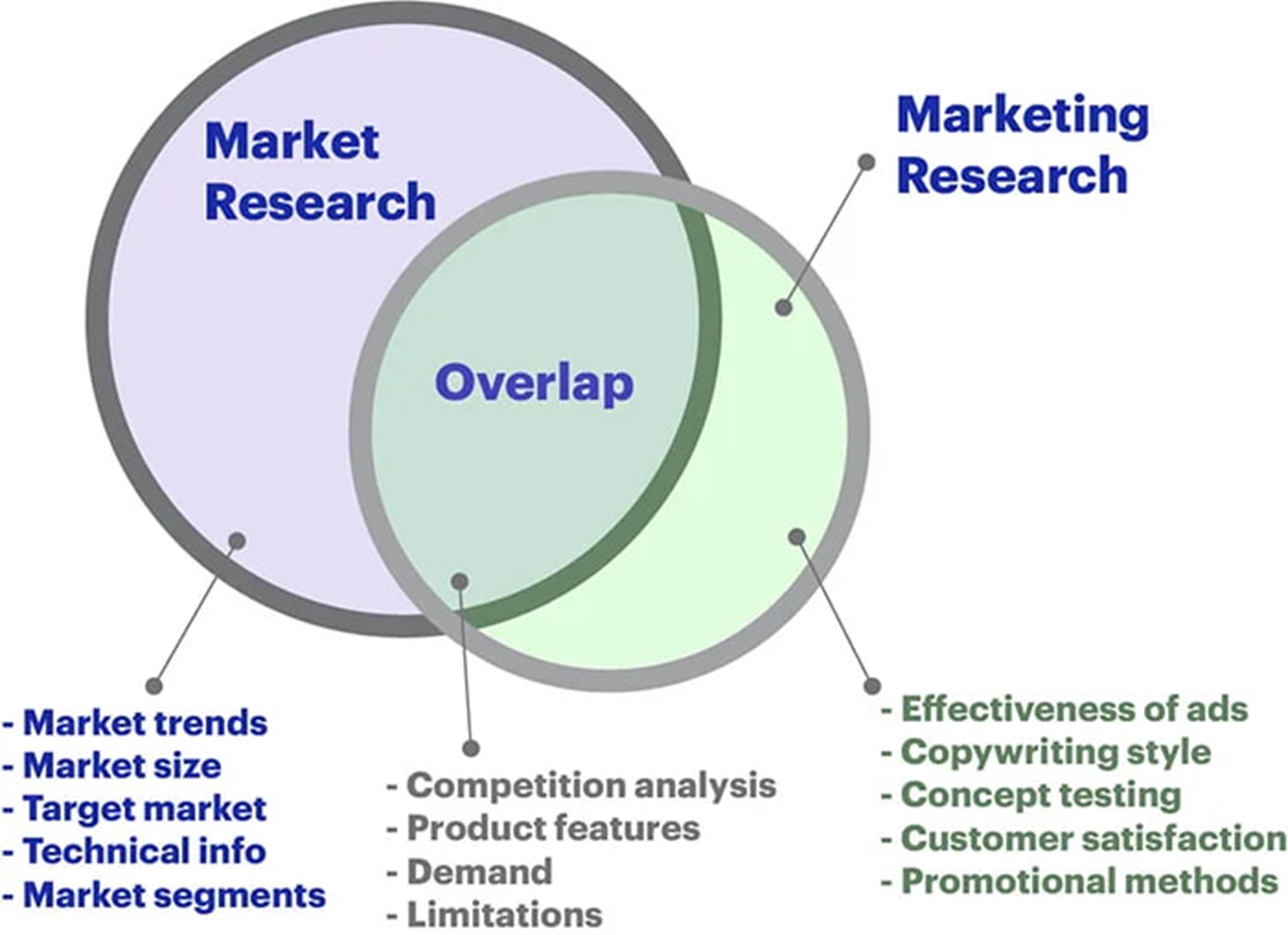
International marketing research
International market research offers a broad overview of the market. We have previously written a guide on how to perform market potential analysis, so this would be a good place to start. Market research is an important backbone of marketing research and will need to be included in your report.
International marketing research can be seen as a subcomponent or derivative of market research. It focuses on the potential marketing-related opportunities and challenges, related to the findings of the market research and overlapping activities.
Preliminary types of international marketing research
When structuring a marketing research proposal, you will first need to understand the market you wish to enter. There are certain types of preliminary research that will help you do this on an international level. You can add these in the background of your research report:
1. Competitor market share and influence
The first thing you should explore is the existing market leaders in the country (or continent) you want to expand to. Understanding their market share in the competitive landscape is an important part of international marketing research.
How does this help?
You can observe the volatility and growth of your competitor’s market share to determine their level of influence in the market you are trying to enter.
If a competitor maintains a stable market share in a growing industry, he is growing his revenue at the same pace as the market’s growth. This is a good indication of up-and-comers, as well as identifying top competitors.
If a competitor’s growth in terms of market share exceeds the growth of the industry, it’s best to compare them with other industry-related market leaders. By doing so, you can determine how the competitive field will look like in the future.
How to get started:
To start the process, you will need to identify:
The timeframe you want to explore
The competitor(s) you want to look into
Your competitors’ revenue data*
Industry’s total revenue
*Revenue data can be retrieved from various independent sources, depending on the country and industry. This includes trade groups, regulatory bodies, or publicly available information that can be obtained from the company itself.
Once all the information is in place you can calculate the market share. Here is how the formula looks like:
COMPETITOR’S MARKET SHARE = COMPETITOR’S REVENUE / INDUSTRY’S REVENUE
For example, if the industry had $100 million in sales over the past fiscal year, and your top competitor made $30 million in the same timeframe, their market share is 30%.

2. Competitor marketing analysis
Once you identify your biggest competitors, it’s time to explore their marketing strategies.
How does this help?
Exploring how your competitors promote their products will help you better understand the audience you are trying to attract. It will also help you discover market gaps / untapped marketing opportunities that you can use to elevate your offer.
How to get started:
There are no set guidelines to do this; the simplest and easiest way to get started is to follow all their digital channels (blog, social media, newsletters, etc.). Here are some questions to ask yourself while scrolling through their content:
How do they position the product? Is it in any way different than the way you present your product at the moment?
How do they communicate with their audience through emails, blog posts, and SM platforms?
What is the tone of voice that the company uses to communicate with the audience? Why do they choose to do this?
Are there any channels where engagement is higher than usual? Why does this happen?
Which are the channels where the competitor is running ads and where do these ads lead in terms of the sales funnel (top, middle, bottom).
How does the competitor attract new customers, retain existing ones, and reactivate inactive ones?
Before you start exploring the marketing tactics of your competitor, it is important to develop a cultural filter. For this, you might need to consult a marketing expert that resides in the area you wish to explore.

3. Limitations related to culture, religion, and legal frameworks
When exploring competitors on an international level, you don’t need to limit yourself to an exact-product match, but rather a niche-match. For example, if you’re selling protein bars for mountain climbers, you could research all competitors that sell health and fitness supplements for mountain climbers. By doing so you can get more insights.
However, the product you wish to sell may also have cultural, religious, and legal limitations.
As we saw earlier, the Australian culture sees coffee as an experience instead of a product. This culture mismatch led to the closure of 60+ Starbucks locations on the continent.
A country’s health regulations may affect the ingredient mix, promotion, or labeling of your fitness supplement.
Certain countries have high internet censorship, which could play a big role in your promotional efforts as well.
There are endless possibilities, and you will need to discover the ones that are relevant to your product.
How does this help?
Understanding the background of a country will help you understand the potential limitations when it comes to marketing and communication.
How to get started:
Consult a native marketing professional to understand how culture and religion may affect the product-market fit.
Consult a native lawyer with experience in your industry and try to understand how legal frameworks could affect your offer.
International marketing research process – The proposal
Now that you have a good understanding of how to structure the background information, it’s time to create a proposal. This is a rather short document that states the following:
• Background information (results of preliminary research, competitor analysis, etc.)
• Problem identification (what is the challenge?)
• Purpose statement (why are we doing this?)
• Choosing models (what models will be used to structure and analyze the data?)
• Choosing Research methods (What research methods will be used?)
• Hypothesis (What do we expect to see from the results?)
• Conclusion (Short summary of key points)
Even if you are the final decision-maker, it’s good to have a proposal before starting the actual research. The document can guide you through the process, keep you organized, and act as an SOP for the participating team members.
The final report
Once you start the execution process, you will eventually end up with a much larger report that contains all the findings of the analyzed data. The structure will look similar to the one above, with the addition of 3 chapters:
• An abstract (short summary of the research process, findings, and advice)
• Background information (results of preliminary research, competitor analysis, etc.)
• Problem identification (what is the challenge?)
• Purpose statement (why are we doing this?)
• Choosing models (what models will be used to structure and analyze the data?)
• Choosing Research methods (What research methods will be used?)
• Results (Summarize the key findings of analyzed data and list the limitations)
• Recommendations (Add your advice based on the findings)
Remember that this is a research study and not a report on marketing. This implies that at this stage, you won’t be developing any methods. You will instead carry out a marketing opportunity analysis. You can find market opportunities as a result, which will offer your marketing plan additional direction.
Returning to our Starbucks example, it is clear that the well-known company undervalued the market and failed to make an effort to comprehend its new target market. It presumably would have adopted a different strategy if it had known how crucial global marketing research is.
Do it yourself vs outsourcing
Like most startup-related services, you can either choose to perform the task in-house or hire external partners to take over the process. But, when it comes to this particular type of research, what is best?
Performing research in-house
This is best done if your company has talent that is capable enough to produce reliable results.
In-house research is a budget-friendly solution, as the only external help you will need will be in the form of consultations.
It might not be the best idea for a team that is already busy with other tasks, as it takes a lot of time to set up and execute the process.
It is definitely not a good idea to hand this kind of task over to someone with little to no experience, e.g. an internee.
Outsourcing to agencies or research firms
Giving this responsibility to a third party could be problematic. Large corporations with the resources but lacking the expertise to do global marketing research should work with an external research team.
If you decide to outsource, be sure your partner has knowledge of the nation you want to grow to and at least some experience in your business.
Don’t think about the cost of conducting this kind of research, and pick the best partner you can. It is a long-term investment that can spare you from making costly errors.
Work with a research company rather than a marketing company.
Conclusion
By quickly outlining the procedures you should take to get started, we have explained the value of conducting international marketing research for startups in this course manual. Prior to scaling your firm, you will need to conduct other types of “investigation,” but marketing research is the one that will give you insight into how to position your products.
Here is a list of our main points that you should keep in mind:
Make careful to research the market share of your competitors as well as any potential (cultural, religious, legal, etc.) restrictions before diving into the details of marketing.
Before starting the process, structure a proposal to receive better direction and have an orderly approach.
Ensure that the final recommendations are supported by the research study’s findings while composing the final report.

Examples of when people found a gap in the market: Apple iPad
It’s hard to think that Apple iPads have just been available since 2010 given their widespread use, particularly when it comes to children in restaurants. This tablet computer combines the functionality of a laptop with a smartphone, offering a larger touchscreen interface.
Mike Satter, interim president at OceanTech and president of WipeOS, tells Reader’s Digest that this technological advancement “without a doubt revolutionized our lives during this decade.” “The iPad completely transformed our lives by fusing the ability to utilize a portable device for leisurely activities with a powerful gadget that virtually replaced the business workhorse laptop computer. Those that depend on their iPads to get through the day include children, employees, acquaintances, relatives, and/or strangers sitting next to you on a plane.

Exercise 2.7: The Perfect Square

Course Manual 8: Environmental Analysis
Organizations can uncover internal and external factors that may have a negative or positive impact on their business by conducting an environmental study. Businesses can foresee prospective opportunities and challenges by taking into consideration variables like the economy and technology. You may create a successful marketing plan for your company by learning how to do an environmental study.
In this course manual, we examine what an environmental analysis is, discuss when to use one, and lay out the procedure for doing one.
What is an environmental analysis?
You can use a strategic tool called an environmental analysis or environmental scanning to uncover all internal and external factors that might have an impact on an organization’s performance. While external components highlight possibilities and challenges external to the organization, internal components highlight the business’s strengths and limitations.
An environment study takes into account trends and major variables, such as interest rates, and how they may affect a company’s operations. These evaluations can assist businesses in determining the market’s attractiveness and developing more effective future strategies.
What is the purpose of an environmental analysis?
Environmental evaluations assist companies in identifying prospective effects that could present a chance or a hazard to them. They can better plan for environmental changes as a result. Utilizing an environmental analysis has several advantages, such as:
• Forecasting the future
• Identifying threats and allowing them to develop a strategy for response
• Helping achieve business objectives
• Forming effective strategies and marketing programs for a business
• Improving organizational performance
The following are reasons why environmental scanning is important and necessary:
1. Identification of strength: A company’s ability to outperform its rivals is a sign of strength. Analysis of the company’s internal business environment aids in determining its areas of strength. After determining its strengths, the company must work to maximize or consolidate those strengths by further development of its current plans, policies, and resources. After determining its strengths, the company must work to maximize or consolidate those strengths by further development of its current plans, policies, and resources.
2. Identification of weakness: A firm’s weaknesses are its constraints. Monitoring the internal environment aids in determining the firm’s strengths and weaknesses. A company could excel in some areas while faltering in others. The weak points should be located and fixed as soon as feasible to allow for further growth and expansion.
3. Identification of opportunities: Environmental analyses aid in the market’s opportunity identification. The business should do everything in its power to seize opportunities as they arise.
4. Identification of threat: Numerous variables, including rivals, pose a threat to business. They can identify threats from the outside environment with the aid of environmental assessments. Early danger detection is always advantageous because it aids in threat reduction.
5. Optimum use of resources: Accurate environmental assessment contributes to the best use of limited natural, financial, and human resources. The firm can eliminate waste and use its resources more effectively by conducting systematic studies of the business environment. Without an understanding of the internal and external environment, resources cannot be used effectively.
6. Survival and growth: Systematic studies of the business environment assist the company in maximizing its strengths, minimizing its weaknesses, seizing opportunities, and neutralizing threats. This helps the company thrive in the cutthroat commercial environment.
7. To plan long-term business strategy: An organization in business has both short- and long-term goals. The company firm can create plans and procedures that could make achieving those organizational objectives simple by properly analyzing environmental elements. Without conducting environmental scanning, the company is unable to create a successful business plan.
8. Environmental scanning aids decision-making: Making decisions involves choosing the best option from a range of available options. An environmental analysis is a crucial tool for comprehension and decision-making in every aspect of company. The firm’s ability to make precise decisions is essential to its success. The corporation can choose the best course of action for the development and expansion of the business by studying environmental evaluations.

What is the environmental analysis process?
The environmental analysis process consists of the following steps:
1. Identify environmental factors
To conduct an environmental analysis, start by selecting environmental factors to evaluate. This depends on your type of industry. For instance, if you work for a healthcare facility, you may want to consider legal factors, such as health and safety regulations. When selecting factors, choose ones that have the potential to impact how you do business.
2. Gather information
Once you decide which factors to evaluate, collect information related to your selected environmental factors. Here you may observe your factors and do some research. There are two main types of information to collect: verbal and written information.
Individuals obtain verbal information through hearing, such as listening to a radio broadcast, whereas they obtain written information by reading sources, such as a newspaper or magazine. Using the above example, this would involve researching online and in medical magazines to see if there were any changes to health and safety regulations that may impact your health facility.
3. Evaluate your competitors
To determine if there are any threats from your competitors, you may want to collect information about them. You can do this using a technique called spying, where you collect information in a nontraditional way. Using the same scenario, you may spy on a nearby health facility to learn about their recent activities, such as a new branch opening.
4. Forecast the impact
Forecasting allows you to predict how certain environmental factors may impact your business. This allows you to anticipate potential threats or opportunities. When forecasting, there are a variety of methods to use, such as brainstorming and surveying. Continuing with the same example, the health facility may forecast that the new branch opening at their competitor’s facility may take away some of their patients.
5. Assess your strategies
Finally, assess your current and potential strategies to determine how the projected environmental changes may affect your organization. This helps you resolve potential challenges that may have resulted from the factors. For instance, the health facility may want to create a new strategy for how they plan to address the decrease in clients due to their competitor’s new branch.

Environmental Analysis Techniques
Environmental analysis techniques can be used by a corporation in a variety of ways. But some are more frequent. The PESTLE study is the most widely used tool for doing a complete environmental analysis of a business or even an industry.
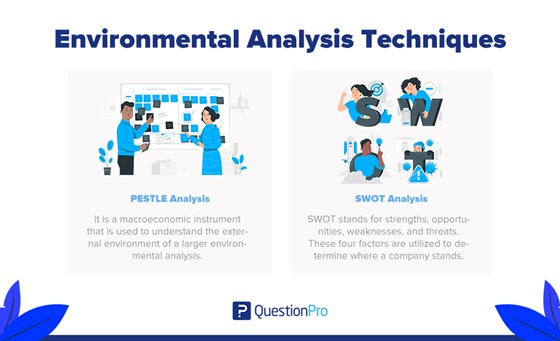
• PESTLE Analysis
This is essentially a bird’s-eye view of corporate activity, as was previously mentioned. This study is utilized by managers and strategists to ascertain the current state of their market since it takes a broad look at key macro problems that significantly affect the health of a specific organization or sector. It aids in assessing the company’s status going forward.
The PESTLE analysis takes into account a number of variables that affect the business environment. It is a macroeconomic tool that helps with a more thorough environmental study by helping to comprehend the external environment. The acronym’s letters stand for various elements. Any industry or organization may be impacted by these elements directly or indirectly.
• SWOT Analysis
SWOT stands for strengths, opportunities, weaknesses, and threats, as you are probably already aware. These four elements are used to assess a company’s strategic position.
There are two groupings made up of these four components. To understand how they can help us carry out an environmental study, we must quickly discuss them once more.
• Internal Factors
Strengths and weaknesses are internal factors in this kind of environmental analysis. They are referred regarded as internal analysis since the organization can influence and even control them. if a company has a distinctive brand name.
This is a strength since the organization’s effective utilization of resources made it possible. As a result, this is a self-generated component that emphasizes one of the factors contributing to the company’s success.
• External Factors
Threats and opportunities are among the external factors taken into account in this kind of environmental evaluation. In contrast to the aforementioned aspects, they are completely out of the company’s control. In actuality, these situations frequently develop on their own.
Since it is hard to completely remove competition, it is a worry for all firms. Therefore, external factors operate in this way.
Your environmental research can incorporate your findings. By seizing opportunities when they present themselves, vulnerabilities can be strengthened, threats can be reduced, and threats can be removed.

Limitations of Environmental Analysis
1: Does Not Warn Against Unforeseen Events
Businesses are not forewarned against unforeseen or unfavorable events by the environmental analysis. It does assist firms in predicting upcoming trends. It does not, however, help to remove the doubt. Businesses cannot prevent unforeseen occurrences from happening during analysis by using this analysis. However, it does lessen how frequently these shocks happen.
2: Does Not Follow a Strategic Approach
Based on environmental study, businesses can develop their plans. The analysis itself, however, does not adopt a calculated risk-taking strategy. This indicates that it has no rigid plan and encourages enterprises to act cautiously.
3: Not Independently Reliable
Although the environmental analysis offers businesses options, it is not completely trustworthy. This implies that in order to validate solutions, firms must to do additional analyses. It may or may not benefit the company if an analyst bases all of his or her decisions only on environmental analysis. However, the outcomes are more trustworthy when an environmental study is supplemented with other strategic methodologies and assessments.
4: Does Not Guarantee Effectiveness
To enhance corporate efficiency and operations, environmental analysis is done. It does not, however, ensure the same. The strategy to create an output uses the analysis as an input. Therefore, it is not recommended to base organizational effectiveness critically on a single study. To guarantee the best results, the verifiability and accuracy of the data must be validated. Inaccurate, unverified, and unreliable data could influence corporate decisions in the wrong ways.
5: Creates Confusion
The environmental analysis concentrates on too many pieces of business data simultaneously. It takes into account a business’s benefits and drawbacks. Analysts may become perplexed as a result of this. The more data available, the harder it is to come up with a solution. Therefore, the availability of knowledge makes it more difficult to solve problems.
Conclusion
In-depth analyses of revenue, profitability, and business success are all conducted. The finest decisions for your business can be made with the aid of an environmental study. The kind of environmental scanning that you ought to conduct depends on the kind of your company.

Examples of when people found a gap in the market: The Snoo
Despite the recent decade’s abundance of high-tech parenting products, the Snoo Smart Sleeper has been one of the most significant since it hit the market in 2016. This sensitive bassinet, which mimics the sounds and movements of a womb, lessens fussing and naturally settles a baby to sleep. It was developed by pediatrician and co-founder of Happiest Baby Harvey Karp, MD, Yves Béhar, an industrial designer, and Deb Roy, PhD, the head of the MIT Media Lab’s Laboratory for Social Machines. It is not only the first smart bassinet in the world but also the first bed to stop infants from unintentionally rolling over. Additionally, a baby that sleeps better gets more sleep for the parents. However, you might look back and regret adding these baby items to your registry.

Exercise 2.8: Group birthday line up

Course Manual 9: Listen to your Customers
How to Use Customer Feedback to find gaps in the market
Product life cycle (PLC) is one of the most fundamental, important, and time-tested business ideas. It describes in broad strokes the phases of customer acquisition and retention that most products go through.
It forces you to step back at each level and consider the big picture: How can you reach more clients with this product and ensure that it remains relevant to them over the long term?
Throughout the PLC, your product, consumers’ usage of it, and customer acquisition strategy might all vary significantly. Nevertheless, success depends on how much value clients get from your product, regardless of where you are in the PLC.
Asking customers directly and incorporating their feedback into your product development cycle is one of the finest methods to find out.
This course manual will discuss the value of customer input throughout the product cycle and how to use that feedback to generate actionable insights for new product development.
Therefore, without further ado, let’s continue.
Why Gather Customer Feedback?
Every level of the product development cycle benefits from customer feedback to help match customer expectations with the features of the product. To make sure your product appeals to the target market, feedback collection is essential from the time the product idea is conceived through its debut and after.
You should include client feedback during product development and beyond for the following reasons:
1. Identify the Right Product-Market Fit
When the value proposition of your product matches the needs of the target market, you have a “product-market fit.” It entails creating the ideal product for the appropriate market.
Obtaining product/market fit should be your first concern when you first start out. If your goods doesn’t meet a demand in the market, you won’t be able to attract buyers.
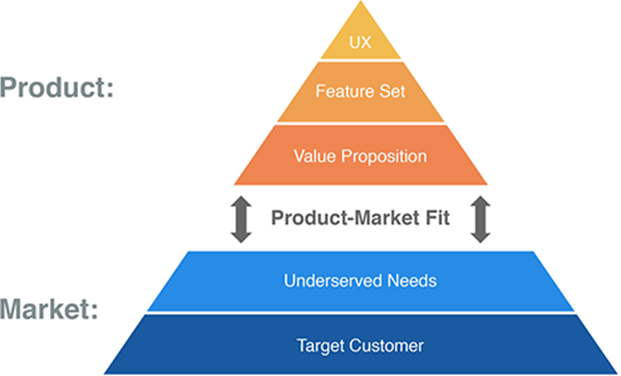
But how can you tell who and what your customers want?
By collecting regular feedback.
Analyzing the product’s demand will help you create a value proposition that fits the market. The individuals that operate your business, i.e., your customers, should be able to provide the answers you require.
The product-market fit can be affected by a number of factors, including;
• Price
• Ease of use
• Quality
• Performance
You may create items that appeal to your target market by finding the ideal balance between these aspects with the help of insightful information about your target audience.

Case Study: How Netflix achieved its product-market fit
By observing current and upcoming trends, Netflix has consistently discovered its ideal market match. It began as a DVD rental company to give customers more affordable options than brick and mortar stores.
As part of its subscription package, it used to deliver movie DVDs to clients, allowing them to keep the discs with them for as long as they desired without being concerned about late fees.
As internet bandwidth increased, Netflix switched from selling DVDs to offering online streaming in an effort to compete as the least expensive option to whatever the entertainment market had to offer.
Netflix is currently one of the greatest streaming services in the world thanks to years of tweaking their product to suit the market.
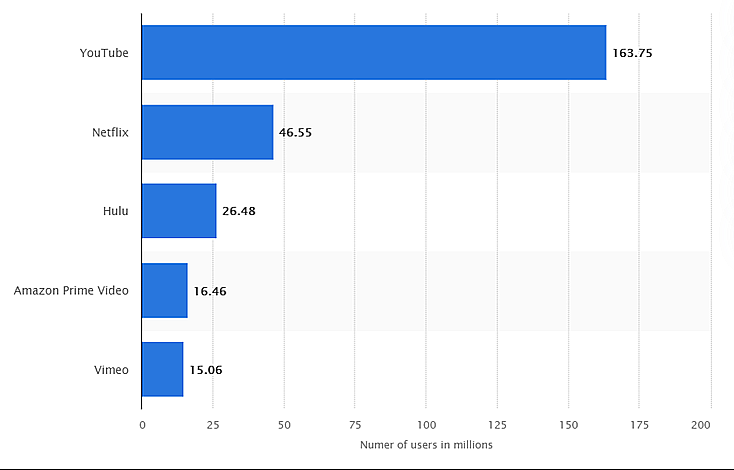
Source: https://statista.com/
2. Test New Ideas & Product Concepts
It’s not just about building a product but finding the next best thing for your customers.
A Harvard Business Review study found that goods with user input performed 20% better.
That’s one more reason to crowdsource product ideas.
Knowing potential clients through and out is essential to developing items that resonate with them. Because digital and SaaS goods sometimes serve extremely specialized objectives and are therefore marketed to similarly niche consumer groupings, this is an even more crucial consideration.
• What sort of solutions is your target audience seeking?
• Is the present product providing the most efficient solution to their issues?
• Does your existing concept resonate with your intended audience?
Another factor to consider is competition.
• Does a similar product exist in the market?
• Does more than one option exist to satisfy the purpose (or similar) that your product aims to fulfill?
• If yes, then what will set your product apart – the Unique Selling Proposition, the famous “USP”?
Customer input can aid in exploring solutions to these issues and testing novel concepts during the pre-development phase, allowing you to make early adjustments before committing to developing a prototype:
It enhances the likelihood that the product will be well-accepted by users when you include the lessons from your potential clients early on in the product development process.

Case Study: Udemy drives continuous product growth with user feedback
An online learning company called Udemy segments its audience using contextual surveys according to several criteria including language and geography. In order to generate fresh concepts and optimize product strategies, it is helpful to understand the problems and preferences for each market category.
For instance, they discovered through customer feedback that many customers outside of English-speaking nations preferred courses offered in English. In order to make their courses accessible to a wider range of students globally, they developed a new function called automated captioning to their course videos.
They requested user feedback on how well the automated captions were done in order to further improve it.
In order to assess the success of marketing initiatives and improve budget allocation, they often conduct user research surveys to learn more about the sources of visitors.
Watch: 3 Ways Udemy Learns From Their Students
3. Innovate
Customer feedback must be incorporated into your product cycle at all stages, including pre-development and post-launch.
It enables you to investigate fresh suggestions for improving your goods. Even seasoned businesspeople occasionally struggle to come up with ideas that have a good chance of succeeding.
Customer feedback can inspire innovation like nothing else during these creative slumps.
People in general can astound product creators with their original viewpoints because they are not under any obligation to come up with ideas.
By utilizing their supposedly “out-of-the-box” creativity through one-on-one interactions, the product’s future can be mapped out. The remainder of the product creation and development process is very streamlined after the product’s purpose is understood.
How to Innovate by Using Feedback in R&D
Utilizing the voice of the customer in product R&D has become crucial due to the growing importance of client feedback. By taking client feedback into account during the design process itself, you can virtually eliminate guesswork. Additionally, your hypotheses and assumptions are confirmed!
Typical techniques for getting client feedback include:
• Interactive workshops
• Usability testing
• Social media monitoring
• Simple direct surveys that can be run inside your product or on-site.
Long-term user feedback from the community is a key factor in new product development.
The Lego Ideas portal, which enables the entire Lego community to submit their original product ideas, take part in Lego building competitions, vote for the fresh ideas submitted by others, and engage with others in the global community, is a great illustration of this tactic.
You can gain the most knowledge possible about the attitude of your target user by putting in place a customer feedback system. Additionally, it may present potential for customer growth, target market expansion, and the targeting of new client groups that are quite likely to be enthusiastic about your final product.
4. Install a Continuous Delivery System
Product designers and marketers are frequently too close to it to recognize (or even admit) its flaws. They lose sight of the defects.
Customer feedback is an excellent instrument for changing this risky way of thinking. It pinpoints consumer issues that perhaps weren’t immediately evident to individuals who were directly involved in the product’s design, development, or promotion.
Effective feedback systems enable organizations to adapt agile product development to quickly respond to such changes, lowering risks, in light of the ongoing changes in market trends and customer preferences.
Unbiased consumers should test innovative items even in the prototype stage. Even when brand-new customers decide to test a product out for the first time, the fact that they have no past experience with the type of product you are evaluating gives you insight into how well the product works (or doesn’t, and why).

Case Study: KingsPoint discovered a problem to save $60000
KingsPoint used customer insights to collect and incorporate customer feedback in their conversion rate optimization process. The team deployed surveys on product pages, resource pages, and checkout pages.
The feedback data helped them uncover major javascript issues with the Safari browser that prevented the customers from completing their orders. The team immediately started to work on the fix to resolve the issue quickly.
This is what Steven Macdonald, advisor at KingsPoint, had to say about the impact of customer feedback on their product cycle – “Without customer surveys, we would still be unaware of the problem. Based on conversion rates for both Firefox (12%) and Internet Explorer (9%), if we can convert just as many users with Safari, then fixing this problem could be worth approximately $60,000 this year.”

4 Steps to Incorporate Customer Feedback Into Your Product Cycle
Implementing customer feedback into your products requires planning and strategizing to build a robust cycle so you can continuously turn data into insights with a planned approach. It will not only help to improve products but other aspects of your business.
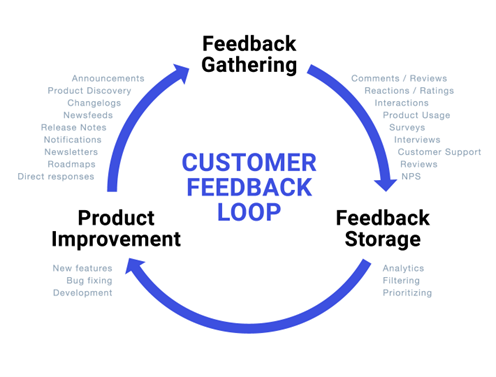
Here are a few steps to establish the feedback loop in your business:
Step 1: Set up a Customer Feedback System
Selecting a platform for your company’s customer research and analysis should be your first step. It should accomplish the following:
• Make it possible to collect feedback
• Consolidate it in one place
• Help to analyze it
As we are all aware, there are numerous ways to gather input. Depending on how much detail you need for your product, you could need more than one method to gather client feedback.
Step 2: Ask for Feedback
It’s time to get product insights now that everything is set up.
A. Choose the Correct Audience
The reliability of the feedback data will be determined by the appropriate individuals.
Step 3: Analyze Data to Make Sense of It by Categorizing It
Customer feedback analysis comes next after gathering feedback using any of the methods outlined above. Actions ought to be guided by analysis of the feedback.
Choosing the categories into which you wish to group feedback data is the first task.
Do you want to separate positive and negative reviews?
Do you believe that categorizing it by the kind of product feedback it is—for example, feature requests, major/minor bug reports, crash data, system logs, etc.—will be more beneficial?
Here are some pointers for choosing the appropriate target audience:
• When the project is in the concept or pre-development stage, select individuals who are not connected to it. Choosing friends or relatives may seem sensible, but their product reviews may contain emotional bias against you. The same is true for teammates who are familiar with the product; they might be too close to it to assess it from the viewpoint of the user.
• In the development stage: Set up a cross-team feedback system to evaluate process flows and product design.
You might also pick a mixture of individuals who have and have not worked with a comparable product or concept. By asking consumers who have used the product to identify any features that are lacking, it will be possible to determine how simple it is for new users to comprehend the product.
During the post-launch phase, you can leverage your user base to choose your target market, which may include new users, prospective customers, verified customers, churned customers, etc. Surveys are one of the quickest and best ways to gather input at this point.
B. Choose the Right Questions
It’s time to start working on the questions when you’ve determined who the audience is. The questions you ask will impact how accurate the product feedback is, whether you are conducting a personal interview, usability test, or survey.
C. Choose the Right Channel and Medium
The appropriate channel or channels might help you locate your target market and increase response rates.
You can gather consumer feedback using the following various channels:
• One-on-one interviews:
Suitable for gathering detailed feedback during the pre-development stage, but it takes more time, resources, and work than other formats.
• Usability testing:
Perfect for testing design flows and product concepts at every stage of the product cycle. However, to assess user actions and behavior, specialized tools like UserTesting with methods like screen recording, video recording, voice recording, eye-tracking, or heatmaps are needed.
• Email surveys:
Best for obtaining customer experience feedback when they interact with your business, such as making a purchase or contacting customer support, and for recruiting people for usability testing.
• On-site or in-app surveys:
Best for simultaneously addressing several audience segments with various survey kinds. Based on visitor behavior and activities like exit-intent, after the checkout, and after clicking the CTA button, they enable advanced targeting.
• Social media:
It’s best to crowdsource concepts and gauge how your brand is perceived by consumers. To gather highly targeted feedback, you can add surveys or polls to your product page or company account.
• Feedback boards:
Another effective way to get input, ideas, and suggestions from your online user community. Include comment sections on your website or app where users may publish ideas, vote for others’ ideas, and leave feedback. Select the suggestions with the most votes for your product development and roadmaps.
• SMS surveys:
The most effective way to conduct pulse surveys at different times in the customer journey. Short surveys allow you to ask one or two simple questions, such as NPS or CSAT.
• IVR surveys:
mostly used to gather customer satisfaction scores following contact with the support services. To respond to the survey, the client presses the relevant key on the keypad.

Step 3: Analyze – Categorize Data to Make Sense of It
Customer feedback analysis comes next after gathering feedback using any of the methods outlined above. Actions ought to be guided by analysis of the feedback.
Choosing the categories into which you wish to group feedback data is the first task.
Do you wish to distinguish between positive and bad comments?
Do you believe that categorizing it by the kind of product feedback it is—for example, feature requests, major/minor bug reports, crash data, system logs, etc.—will be more beneficial?
Once the feedback has been sorted, the capabilities of artificial intelligence and machine learning may be used to analyze it more quickly. These findings are the ideal starting point for a plan of action to enhance your product in the way(s) customers desire.
Step 4: Act – Have a Specific Product Evolution Plan
It is not practical to consider all the various customer input kinds when determining the best course of action for extending and improving the product lifecycle.
The analysis should highlight the key problems or elements that need to be addressed as well as any difficulties users may have when utilizing your product. To maximize user adoption, product management and customer input should work closely together.
User adoption can be increased by incorporating consumer feedback into your product’s life cycle at each step (introduction, growth, maturity, and decline).
Include all of the product’s stakeholders, including early-stage designers, programmers, developers, alpha/beta testers, UI/UX designers, and sales and marketing. Give them the feedback relevant to their stage of the product life cycle and ask them to improve the product in light of it.

Exercise 2.9: The Absent-Minded Listener

Course Manual 10: Consumer Segmentation
Customer segmentation is the technique of grouping customers based on characteristics useful to marketing, such as age, gender, interests, and purchasing patterns.
Because each client is unique, businesses that use customer segmentation believe that their marketing efforts will be more successful if they focus on smaller, more focused groups and deliver appropriate messages to those audiences that would encourage them to make a purchase. Additionally, businesses want to understand their customers’ preferences and wants better in order to determine what each market segment values the most and more effectively target that market segment with marketing materials.
Finding important distinctions that separate customers into targetable groups is the foundation of customer segmentation. Customers’ demographics (age, race, religion, gender, family size, ethnicity, income, and level of education), psychographic (social class, lifestyle, and personality traits), behavioral (spending, consumption, usage, and desired benefits) and geographic (where they live and work) factors are all taken into consideration when determining customer segmentation practices.

Consumer Segmentation success story: Disney
Disney is the best at comprehending consumer behavior and customer segmentation. In the early 20th century, Disney began by selecting target groups using simple demographic segmentation.
In order to comprehend the personality features, preferences, decisions, motives, and lifestyles of its current and potential clients, it has also adopted psychographic segmentation. The next step is unique neuromarketing, which aims to comprehend how clients respond to emotional stimuli and how they might be divided into segments based on this. In reality, Disney had a hidden lab in Austin long before others to better understand consumer emotions and the factors that influence a customer’s decision to buy a product. This has aided Disney in identifying the appropriate markets, developing marketing strategies tailored to the micro market groups, and developing products that have, in one way or another, delighted a broader audience. Disney is currently more successful than all of its rivals.
Customer segmentation procedures
Customer segmentation, also called consumer segmentation or client segmentation, procedures include:
• Deciding what data will be collected and how it will be gathered
• Collecting data and integrating data from various sources
• Developing methods of data analysis for segmentation
• Establishing effective communication among relevant business units (such as marketing and customer service) about the segmentation
• Implementing applications to effectively deal with the data and respond to the information it provides

Types of Consumer Segmentation
Demographic & Socioeconomic Segmentation
One of the most popular and straightforward methods of consumer segmentation is demographic segmentation. At its most fundamental level, demographic segmentation examines age and gender, although socioeconomic elements like household income, marital status, occupation or industry, and education (such as if they have a degree level of education) all fall under this segment.
When creating your target segmentation, in addition to the categories mentioned above, you should also have a look at interests and bio keywords (the most popular phrases people use to describe themselves).
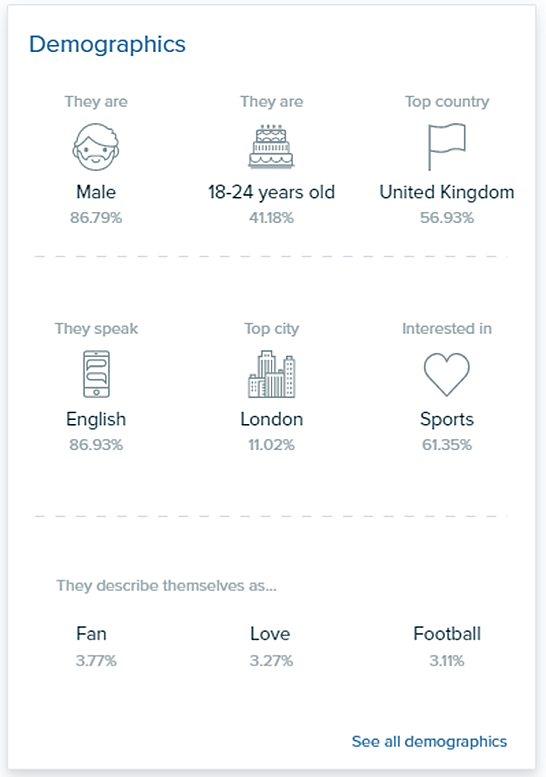
Geographic Segmentation
Geographic segmentation, which groups audiences based on their geographic location, typically at the country and city level, is another popular method of consumer segmentation.
Consumer requirements and preferences can differ greatly from city to city, particularly in bigger countries with notably different topography or economic regions, like the US. For multinational businesses, geographic segmentation is very helpful in defining the subtle differences in consumer wants across different countries and in identifying any cultural traits that may be included in their targeting approach.
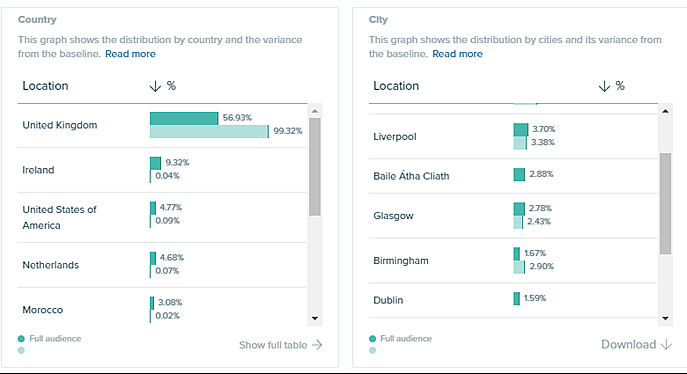
Behavioural Segmentation
As the name implies, behavioral segmentation divides audiences based on their habits and behaviors. This covers purchasing patterns and online behavior, as well as the selection of platforms and technological tools and peak online usage times.
This kind of consumer segmentation can assist your company in customizing your marketing initiatives to provide the best results, such as timing organic social media posts or email campaigns for when your audience is online the most.
The most successful channel mix for your audience can be determined by considering characteristics that drive purchases. Knowing if your audience is more impacted by online ads or by those around them, for instance, can help you decide whether influencer, sponsored social, or television campaigns are most likely to be successful.

Psychographic Segmentation
Want to understand what motivates your audience? In this situation, psychographic segmentation is useful. Similar to behavioral segmentation in that it aims to comprehend an audience at a level beyond demographics, this sort of consumer segmentation is distinct in that it places more emphasis on the personality, beliefs, and interests of the audience members than on a measure of their past behavior.

Consumer Segmentation success story: Marvel
Within Disney, Marvel is just another phenomenal success story of customer behavior. Before Disney bought Marvel, it was a dying company with no one interested in seeing its movies and a waning market for comic books. The rival DC featured much larger superheroes and had greater client loyalty. Marvel was successful because of the effective product distribution made possible by hybrid consumer segmentation and understanding of customer cognitive behavior. The fact that the opposition did not adopt the same strategy also helped.

Social Media Segmentation
By grouping your various audiences by platform in social media, you can determine where they are most engaged. This is a helpful insight because it can guide you in choosing the optimal locations for your advertisements or content amplification.
According to the figure below, which was obtained from an example report, this audience is almost 2.5 times as likely to use Spotify and 7 times as likely to use Snapchat as the baseline, suggesting that they are the most advantageous platforms to employ.

Benefits of customer segmentation
A customer segmentation model enables businesses to target particular client groups, allowing for the efficient allocation of marketing resources and the optimization of cross- and up-selling opportunities. Companies find it simpler to send clients unique offers intended to persuade them to purchase more goods when they deliver individualized messages as part of a marketing mix that is tailored to meet their demands. Customer segmentation can boost customer satisfaction, support client loyalty, and increase customer retention. In contrast to impersonal brand message that doesn’t acknowledge purchase history or any form of customer relationship, marketing materials sent out via customer segmentation tend to be more valued and appreciated by the customer who receives them as a result of their individualized nature.
Keeping a step ahead of rivals in some market segments, recognizing new items that current or potential customers might be interested in, or enhancing products to suit customer expectations are further advantages of customer segmentation.
How do you get access to this experience data?
You can gather experience data in a variety of ways, which are divided into direct and indirect streams. See the complete list below. Typically, direct might include customer surveys and a direct response. Indirect insights come from data that wasn’t gathered directly but can still identify significant trends that can help analyze any correlation in customer behavior.
Direct
• Relationship surveys
• After-store visit surveys
• Post-purchase survey
• Product satisfaction survey
• Brand Tracking
Indirect
• Voice IQ
• ORM/Social Listening
• Frontline Feedback
Qualtrics is also useful. Utilize CustomerXM to comprehend important patterns and behavioral influences.
Your brand positioning, message, and go-to-market strategy should be based on them once you have identified the correlations and developed your client segments. Because you are aware of who to target and how to do so in a way that will boost your bottom line, these client segments provide you with invaluable insight into how to successfully fulfill your business objectives.
A greater comprehension of how various segments behave will enable you to design journeys that cater to various segments and make it as simple as possible for consumers to finish the journey. Customers complete the customer journey in a variety of ways.
Your consumer segments’ level of specificity will be determined by how well they correspond with your aims. For instance, a large company like eBay that introduces a new service that is aimed at everyone will have a totally different consumer segment than a company that only targets tiny, independent firms.
When segmenting your consumer base and matching those segments to your goals, consider the following:
• Is it a competitive reaction?
• Is it a new product offering?
• Do we want to expand the market?
These will aid in figuring out how precise your segmentation has to be.

Importance of customer segmentation
Companies work to categorize their consumers into quantifiable groups based on their demands, actions, or demographics. They also try to assess the profitability of each group by examining the revenue and cost implications. Value-based segmentation rates various client groups according to the amount of money they bring in and how much it costs to build and maintain connections with them. Additionally, it aids businesses in identifying the most and least profitable categories so they may modify their marketing budgets accordingly.
By splitting customers into groups with comparable demands, a firm may promote to each group differently and concentrate on what each type of client wants at any given time, which can have a significant impact on customer management. Depending on the resources or demands of the business, niche consumer segments can be targeted on a large or small scale.
Companies are concerned with the job titles of decision-makers, the industrial sector, whether the business is public or private, its size, location, buying habits, and the technology at their disposal, for example, in B2B marketing.
Businesses are concerned with specific customers’ profiles, attitudes, and lifestyles when engaging in B2C marketing. Businesses that sell to consumers could also be worried about location. B2C enterprises can customize offers based on local events and preferences by segmenting customers according to their geographic area. B2C businesses can also alter their offers in accordance with the regional languages that are most commonly spoken.
A vertical or horizontal alignment is one method for B2B customer segmentation. Companies that use vertical segmentation choose specific markets or job roles that they believe would find their products appealing and then concentrate their marketing efforts on those groups. Companies can offer services that are tailored to specific industries thanks to vertical segmentation. In contrast to the healthcare sector, the financial services sector has various needs. Adoption and satisfaction may rise if services tailored to each segment’s sector are made available.
Companies only concentrate on one job title in a wide range of industries and organizations when using horizontal segmentation. A stronger concentration on the requirements of certain job titles or job functions is one advantage of horizontal segmentation. For instance, by concentrating on Chief Financial Officers (CFO), product material, website content, and email newsletters can be created that are especially suited to that position.
Customer segmentation vs. market segmentation
Companies can define and develop customer segments using marketing automation tools. Demographic information, psychographic information, and activity-based information, such as user behaviors on a website, can all be used to create client segments. Companies configure, plan, and carry out campaigns for specific consumer segments with marketing automation software.
Market segmentation and customer segmentation are two different things. Grouping clients based on the goods or services they buy is an illustration of market segmentation. A business may divide the market depending on various business lines, such as software, professional services, and training. The business can then divide its resources among the many market segments and carry out unique marketing and advertising campaigns for each.

Case Study: What we can learn from HP’s failure
Ever questioned why a fantastic product with fantastic features and affordable cost fails? Why does one product have huge success while another, equally capable product, fails to capture the market’s attention?
Use customer behavior as an excuse. The saying “Customer is king” is still very much relevant today. Only if clients are purchasing and enjoying your goods will you consider it a success.
Why They Failed?
HP Touchpad: A fantastic starting point is HP’s attempt to mimic the Apple iPad with a touchpad. When it was first introduced in 2011, it was hailed as the only device that could compete with Apple, however after a significant failure and $1.5 billion down the drain, the product was withdrawn from the market. It caused repercussions throughout HP and weakened its position in the global PC industry. Even while HP’s WebOS touchpad had several shortcomings, its sales of 50k units compared to 15M for the ipad clearly weren’t due to any design defects. In markets that are much more competitive, the worst products have sold more. What then caused the failure?
One of the main causes was HP’s choice to build anticipation much earlier and then unveil it after months. The other was an erroneous segmentation of the consumer base. While the product should have been targeted to a certain segmentation, HP continued to compete head-on with Apple. Another great example of a marketing campaign that led to inflated expectations and perceptions of the product is this one. HP hadn’t properly done its research into client segmentation.
HSBC Tagline Horror: Another incident concerns HSBC’s efforts to spread the word about their 2009 US motto, “Assume nothing.” There was nothing wrong with that other than the fact that it was pronounced “Do Nothing” in several nations. This was a mistake that could have been avoided, and fixing it would have cost millions of dollars. This failure was caused by a lack of dialect, language, and geographic understanding.

Exercise 2.10: Blindfolded Obstacle Course

Course Manual 11: Spot Acute Unsolved Problems
Because we are attempting to comprehend the complexity of their environment, aspirations, and situational context, evaluating market challenges more frequently entails qualitative efforts.
Additionally, this important activity gives shape to how we will communicate with clients and develop a passion for their issue in order to develop a solution.
Furthermore, this effort must be quantifiable. We won’t ever be able to persuade other members of the organization to act on our findings if we can’t take this qualitative experience and somehow apply some data-driven variables to it.
This is what makes it difficult to identify and comprehend market issues. People enjoy speaking with consumers, and we pursue something of the highest quality. This technique allows us to gather unstructured, experiential information.
But how can I turn this into a narrative that persuades decision-makers to take initiative and provide funds?

Product Success Story: ChargedUp
The ChargedUp story is just another fantastic product tale that may motivate every entrepreneur. This product story is intriguing since it aimed to address a daily issue that virtually everyone encounters. It capitalizes on people’s addiction to smartphones and the fact that mobile phone batteries quickly drain from frequent use.
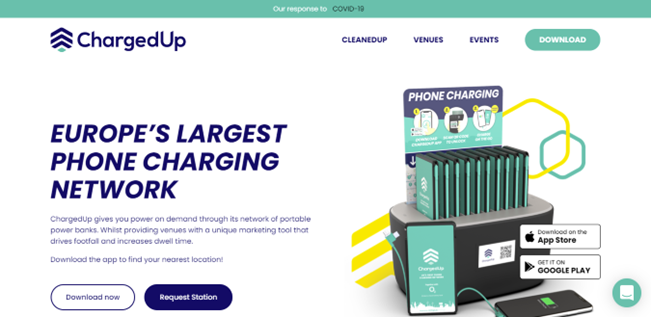
A device called ChargedUp functions similarly to rental bicycles. After downloading the app, a user may quickly scan a code to pick up a power bank from the closest location and drop it off at the next. With just a few taps on the app’s “Scan to Rent” and “Unlock Battery” buttons, one may power their phone with renewable energy.
The nicest thing about this product story is that it not only addressed a societal issue while providing a solution to a problem that plagues the mobile generation. Your phone is powered by renewable resources like the sun and wind.
Common Mistakes Made in Market Research
Before we dive into how to validate market problems, let’s first explore some common areas where these projects fall off track.
If you’re the person doing the work, when you encounter these problems, they can create uncomfortable and difficult situations.
• Focus on near-term revenue
Your efforts will be very challenging if this program, especially if it comes from leadership, aims to address short-term income issues. You should make the case that this is an unreasonable expectation in this circumstance.
• Spending excessive time with existing customers
You are not undertaking market discovery when you do this. In fact, you’re working on the upcoming release, which might be a fruitful endeavor for preserving present revenue and fostering loyalty. However, it won’t assist in identifying a fresh opportunity or creating a rival market segment.
• Investing efforts chasing competitors
It is realistic that we might need to counteract rivals who have features before us in the market. But rather of engaging in this long-term strategic activity as a defensive measure in this situation, you should seek to a different section of the Framework to address that issue.
• A response to a new innovation agenda
Innovation is a component of market research, but it shouldn’t be in charge of it. Customers, non-customers, and potential customers make up the context of this work. We’re not trying to use technology to fix something. We are trying to identify an issue and a workable solution.

The Journey of Finding Market Problems
Market issues are a reflection of the difficulties, annoyances, and unmet wants that the entire consumer base has expressed (the market). The issues must be visible and quantifiable.
Marketing issues are suggested rather than explicitly addressed. Customers, whether new or returning, don’t describe what they want; instead, they describe what they don’t like about what they are doing at the moment. It’s our responsibility to use further in-depth inquiries to ascertain what that genuinely entails.
Then, ask, “is there emotion attached?”
People are likely to find inherent value in addressing a problem if it bothers them.
After identifying the issue, you must then quantify it. You quantify it for that particular person in a concrete sense rather than in financial terms for your organization.
Finally, you must consider alternative solutions while analyzing market issues. In this last stage of the trip, most product professionals overlook the fact that doing nothing is also a feasible choice.
Although there may be a number of different products on the market, both successful and unsuccessful, sometimes your biggest rival is choosing not to find a solution. Therefore, any issue you uncover must be widespread enough for customers to be willing to pay for a fix.
Using Personas Add Precision
We employ personas because we want to comprehend our clients. We shouldn’t focus on market issues only to make something cool.
We can concentrate on understanding where our clients are and where they want to go by using personas. We should lead them there with the solutions we create. To put it simply, we want to change the conversation from us, the vendor, to the buyer and consumer.
Engaging in Market Discovery

Market discovery is an ongoing qualitative research process that looks for opportunities in the market by observing how the entire customer base interacts. Focus groups, in-depth interviews, and other methods are used to achieve this.
It’s crucial to keep in mind that the initial feedback is primarily noise. In general, it is not the solution to the issue, despite the fact that it may be convincing information from an attractive source. This is why it’s important to get data from several sources.
These exchanges do not constitute transactions. We are attempting to establish connections that will influence how we construct our solutions.
Additionally, since they are relationships, we can make additional visits to help clarify our presumptions.
Finally, we must organize these inputs into a narrative that will appeal to your organization.
Avoiding a Crowded Market with Validation
The combined qualitative and quantitative process of determining if a problem identified during market discovery is worthwhile is known as market validation.
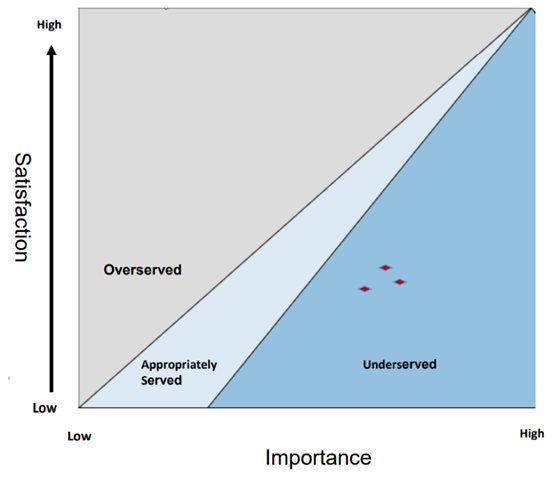
In this step, we want to stay away from “me-too” offers. We want to avoid making the error of developing an already well-known feature if we are counting on a fresh opportunity to produce big outcomes.
Maintaining our offering’s competitiveness makes up a significant piece of the work we perform as product experts, but that is a distinct exercise from what we hope to do when confirming a market issue. Even so, we might employ some of the same methods.
Instead, We’re Looking for Uncharted Territory
Opportunities with a high importance and low satisfaction rate are sought after by market validation.
Market Problem Success Triad

What are the three signs that a market issue is one that merits attention?
First, you should always assess a market issue in light of its significance and degree of satisfaction. It all comes down to listening to the prospective buyer with those two components.
Second, we should consider feasibility.
Technical viability, or whether engineers could actually construct the solution, is obviously important.
Additionally, there is market viability. At this point, you should evaluate the suggested solution in light of the organizational structure, business objectives, personnel, and communication procedures. In essence, is it feasible for your company to market and successfully sell this solution?
The easiest way to use this diagram is to layer in feasibility after starting with satisfaction and importance. Many good ideas will be rejected if you start with viability when they really merit more thought.

How to evaluate market problems
Ask (and provide answers to) the following questions to assess the market issues that have been discovered.
1. Is the market problem urgent?
Make sure that present and potential customers are interested in the issue once you’ve found one that affects the market. Is the apparent issue truly urgent? Customers may not care if the issue is not resolved. Do they have a different approach to resolving this issue?
2. Is the market problem pervasive?
See if a sizable portion of your target market is affected by the identified market issue. Utilize quantitative research to gather the information. Surveys, census information, and other primary market research techniques are used to obtain data. Without devoting a lot of resources, this is possible. To get a significant amount of quantitative data, use free survey tools (like SurveyMonkey) and your personal network (depending on the target market).
3. Will your buyers pay to have this problem solved?
Customers are likely to agree to pay for a solution if the issue is gravely urgent and ubiquitous. Finding out how much they would be willing to pay for a solution to this issue would be the next step. You can do this by interviewing members of your target market again or conducting surveys of them.
Note: You have found an issue that is worth tackling if you responded “Yes” to all of the questions above. To ensure that you have a competitive advantage in your market, make sure to find out if your rivals have previously addressed this issue.

Product Success Story: Zivame
In a developing nation like India, purchasing lingerie from a store carries a social shame. Women are less carefree when shopping for the same items and often get side-eyed when they try to suggest alternatives. Richa Kar, co-founder and CEO of Zivame, recognized this problem and made the decision to offer a workable solution.

She created a straightforward website and mobile application to assist ladies in discovering the ideal lingerie for their bodies from a wide selection of items from various companies. With the help of this program, women were empowered and encouraged to discover the ideal bra and underwear for themselves.
Similar problems continue to plague society to this day. Entrepreneurs can easily identify these social problems that oppress others and attempt to introduce a solution that empowers them. It can be a terrific attempt to empower others through a product, and everyone will undoubtedly appreciate it.

Exercise 2.11: Tallest Tower

Course Manual 12: Profit Potential
In the world of business and economics, the term “profit potential” or “income potential” refers to the potential for a product or plan to generate revenue. Profit potential is a prospective sign of what the expected return on investment might be rather than a guarantee of earnings. The term is frequently employed in business and financial literature—sometimes as a marketing gimmick—because of the concept’s suppleness.
It depends on a number of criteria to calculate profit potential. This calculation is occasionally referred to as a risk vs reward analysis. In essence, the evaluation records the expenses and dangers related to the manufacturing and marketing of a good or service. It then compares these recurring costs against the anticipated sales income to determine whether the product will earn any profit at all and, if so, whether the profit will be sufficient to make the product cost-effective.
When calculating the risks associated with a product, factors including production and service costs, administrative expenses, insurance premiums, local licensing fees, and promotional costs are taken into account. In addition to these costs, raw material costs and product transportation must be taken into consideration. Possible costs like returned goods, taxes, or legal services should also be factored into the assessment for a complete appraisal of the risks.
Calculating the profit component of the equation is significantly easier. The expected sale price of the product is multiplied by a realistic estimate of consumer demand to determine potential revenue. These figures provide a ballpark estimate of how much money can be made from the sale of every particular product. If the sale of byproducts is taken into consideration, the computation can be made even more exact. A meat-packing facility that sells scraps to a company that makes pet food is an example of a byproduct sale.
The potential for profit can be calculated once the statistics for both predicted expenses and revenue have been calculated. Risky investments are those that are close to the break-even threshold, where risks and potential profits are equal, or that skew more toward expenses. The investment is typically seen as a safe investment, meaning the investor is not likely to lose money, if the predicted revenue exceeds the projected expense. The profit potential of the product becomes a more enticing proposition to potential investors when expected earnings are noticeably higher.

Product Success Story: UMZU
It’s wonderful how one personal experience can inspire you to launch something that can change the lives of everyone around you. His journey of battling a brain tumor as a kid made his dream to create the biggest and most trusted natural products company. He had suffered several side effects of chemicals in drugs during his treatment and wanted to ensure others don’t suffer that. He had said,
“Healing my brain tumor naturally was was very challenging for me at the time, but it set the scene for much of who I’ve become today, and how I can uniquely help people with the insight I got. I learned, foremost, the power of my own mind. I learned that I can solve any problem.”
Christopher was just 19 when he was diagnosed and was motivated to heal himself without scary surgeries and dangerous drugs. He became 100% symptom-free from a brain tumor in 18 months without any drugs or surgery. He adjusted his lifestyle, improved his nutrition, exercised at home, and took some strategic supplementation.
He wanted others also to heal naturally without the fear of side effects from the chemical drugs or surgeries and so started UMZU. His journey wasn’t easy but he made UMZU one of the leading names in the healthcare e-commerce industry. Now, the company is expanding its reach and launching newer ranges of products. What lesson can you learn from here? That you can start a global business regardless of your location. You just need to be smart with finding your partners. For example, catering to a growing market in California would mean partnering with a fulfillment center in California.
Many innovative, developing, and expanding businesses think about going global as a marketing and growth plan each year. Developing organizations and their consultants must constantly take into account the possible profit of the project and evaluate this against the potential hazards before starting the effort to design a strategy plan to commence worldwide company expansion. When dealing with an expansion whose profitability can vary greatly depending on several circumstances, calculating the profit potential helps to make the larger picture clear. The ability to generate revenue that, after costs, results in net income—a estimate, not a promise—is the measure of a product’s profit potential. The straightforward profit potential is, for instance:
100 units in inventory x (sale price of $5 per unit – expenses of $3 per unit) = $200 profit potential
Put another way: I x (P-E) = PP, where: I = inventory or potential demand, in units, P = sale price per unit, E = expenses per unit and PP = profit potential. Note potential demand multiplied by sale price per unit equates to expected, not guaranteed revenue. Expected revenue less expenses, therefore, equals profit potential.
Let’s explore this idea a little more by using the hypothetical aircraft corporation ABC Industries as an example (ABC). ABC manufactures helicopters and aircraft for both the military and commercial use. Unfortunately, ABC Industries only creates a standard version of each product for the government market. Each product’s costs are tracked individually by ABC Industries. Let’s go cautiously.
Step 1: Estimate Future Revenue
Start by calculating the profits—or revenue—you anticipate in the new market. Begin by determining the size of the market. In particular, research figures of equivalent products, if any, and estimate the number of prospective customers deciding on the portion of the market niche you seek to net. You may be lucky enough to claim the entire market share, but don’t overestimate your initial success. ABC Industries will want to multiply its estimate by a price the market can tolerate, taking into consideration the prospect of domestic and international competitors, landed cost, respectable profit and converting this price into its own currency.
ABC Industries anticipates the following pricing and demand for its products (see Figure 1):
• Fighter Aircraft: Sale price of $350,000 per plane; projected demand of 100 units this year
• Commercial Aircraft: Sale price of $200,000 per box car; projected demand of 50 units this year.
• Helicopters: Sale price of $15,000 per car; projected demand of 1,000 units this year.
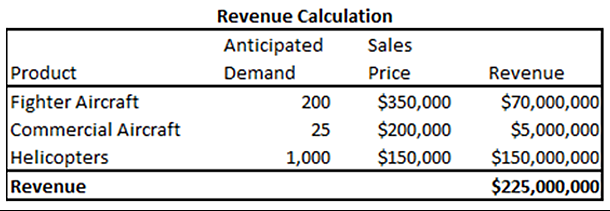
Figure 1
Step 2: Estimate Your Variable Costs
Variable Costs are those monthly costs to you of the goods or services you’ll sell as part of achieving your sales estimate. They’re called variable, or sometimes incremental, because they go up or down depending on the volume of products or services you produce or sell (see Figure 2). They commonly include:
• Direct materials – charges to expense when the associated products are sold.
• Sales Commissions – charges an international representative earns when sales transactions are completed.
• Billable labor – charges to expense when the associated sales transactions are completed.
• Labor – costs incurred for employee labor based on the number of units produced.
• Tariffs – costs charged by a foreign government applied to imported goods
• Packing – costs incurred to ensure delivery arrives in tact for customer use.
• Shipping – depending on the Incoterms of sale you negotiate with your customer for costs incurred by freight forwarders and actual transportation expense incurred in delivering the product.
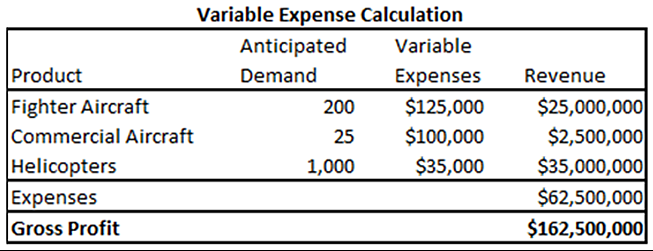
Figure 2
Step 3: Estimate Your Fixed Costs
Fixed costs are expenses that apply to your firm regardless of the quality of the products and services you provide. Initial operating costs separate local from foreign markets. If you don’t outsource market research, staff time will be spent researching the market. Research expenses cover the price of learning about cultural norms, legal and regulatory difficulties, translation, and locating any local support you might need, including counsel. You must estimate and incorporate the cost of the assets and their operation if you decide to produce the product domestically (see Figure 3).
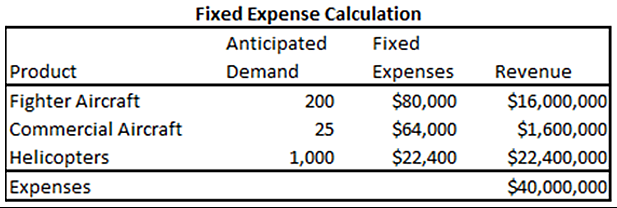
Figure 3
These you will subtract from your price as well (see Figure 4).
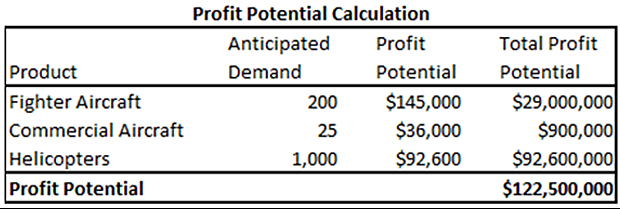
Figure 4
Step 4: Calculate Your Gross Profit Margin
It’s also useful to know your gross profit margin. Gross profit margin measures the difference between the costs of producing a product or providing a service and what you’re selling it for. In short, it lets you know how profitable your products and services are.
To get your profit margin, divide your estimated average monthly gross profit by your estimated monthly sales. Generating this calculation is beyond the scope of this illustration. What’s a good profit margin? The answer varies across industries and your own requirements. Without looking at the costs of a company’s overhead, such as marketing and administration, profit margins don’t give the whole picture of a company’s profitability. So it is worth examining this aspect of profitability as well.
Of course, the above figures are fictitious, but they do depict the type of analysis you and your firm need to thoroughly conduct before launching into foreign markets. Given the above, one might question whether or not your firm should expand to international markets. Realize expanding into international markets can mean positive growth for your company and a hedge against economic downturns in your home marketplace, providing your market research warrants the effort and expense involved in taking that step.

Product Success Story: Too Good To Go
The idea of an app to donate surplus food has inspired a lot of startup app ideas, but TooGoodToGo is one that has already been put into practice. They have made food waste a global problem by branding their app as the “anti-food waste app.” The foundation of the app’s operation is to match clients with eateries that have any leftover food. People can purchase this extra food at significantly lower prices and use it for a variety of things.

Their entire objective of minimizing food waste is built upon four pillars. In order to reduce the millions of tons of food that are wasted each year, they seek to collaborate with 50 million families, 75,000 enterprises, and 500 schools. The software also seeks to raise awareness about food waste in addition to preventing it. They hope to influence the political agendas of at least five nations this year with their insightful content and content pieces.
Entrepreneurs can start their product development and build their brand quickly by committing to a social cause.
Startups and business owners can reduce costs and accelerate product launch by outsourcing their product development. They can begin by creating an MVP and then develop the product in response to customer feedback.

Exercise 2.12: Team Survival
Project Studies
Project Study (Part 1) – Customer Service
The Head of this Department is to provide a detailed report relating to the Market Opportunity process that has been implemented within their department, together with all key stakeholders, as a result of conducting this workshop, incorporating process: planning; development; implementation; management; and review. Your process should feature the following 12 parts:
01. Identify Strengths and Weaknesses
02. Purchase Situation Analysis
03. Direct Competition Analysis
04. Indirect Competition Analysis
05. Analysis of Complementary Products and Services
06. Analysis of other Industries
07. Foreign Markets Analysis
08. Environmental Analysis
09. Listen to your Customers
10. Consumer Segmentation
11. Spot Acute Unsolved Problems
12. Profit Potential
Please include the results of the initial evaluation and assessment.
Project Study (Part 2) – E-Business
The Head of this Department is to provide a detailed report relating to the Market Opportunity process that has been implemented within their department, together with all key stakeholders, as a result of conducting this workshop, incorporating process: planning; development; implementation; management; and review. Your process should feature the following 12 parts:
01. Identify Strengths and Weaknesses
02. Purchase Situation Analysis
03. Direct Competition Analysis
04. Indirect Competition Analysis
05. Analysis of Complementary Products and Services
06. Analysis of other Industries
07. Foreign Markets Analysis
08. Environmental Analysis
09. Listen to your Customers
10. Consumer Segmentation
11. Spot Acute Unsolved Problems
12. Profit Potential
Please include the results of the initial evaluation and assessment.
Project Study (Part 3) – Finance
The Head of this Department is to provide a detailed report relating to the Market Opportunity process that has been implemented within their department, together with all key stakeholders, as a result of conducting this workshop, incorporating process: planning; development; implementation; management; and review. Your process should feature the following 12 parts:
01. Identify Strengths and Weaknesses
02. Purchase Situation Analysis
03. Direct Competition Analysis
04. Indirect Competition Analysis
05. Analysis of Complementary Products and Services
06. Analysis of other Industries
07. Foreign Markets Analysis
08. Environmental Analysis
09. Listen to your Customers
10. Consumer Segmentation
11. Spot Acute Unsolved Problems
12. Profit Potential
Please include the results of the initial evaluation and assessment.
Project Study (Part 4) – Globalization
The Head of this Department is to provide a detailed report relating to the Market Opportunity process that has been implemented within their department, together with all key stakeholders, as a result of conducting this workshop, incorporating process: planning; development; implementation; management; and review. Your process should feature the following 12 parts:
01. Identify Strengths and Weaknesses
02. Purchase Situation Analysis
03. Direct Competition Analysis
04. Indirect Competition Analysis
05. Analysis of Complementary Products and Services
06. Analysis of other Industries
07. Foreign Markets Analysis
08. Environmental Analysis
09. Listen to your Customers
10. Consumer Segmentation
11. Spot Acute Unsolved Problems
12. Profit Potential
Please include the results of the initial evaluation and assessment.
Project Study (Part 5) – Human Resources
The Head of this Department is to provide a detailed report relating to the Market Opportunity process that has been implemented within their department, together with all key stakeholders, as a result of conducting this workshop, incorporating process: planning; development; implementation; management; and review. Your process should feature the following 12 parts:
01. Identify Strengths and Weaknesses
02. Purchase Situation Analysis
03. Direct Competition Analysis
04. Indirect Competition Analysis
05. Analysis of Complementary Products and Services
06. Analysis of other Industries
07. Foreign Markets Analysis
08. Environmental Analysis
09. Listen to your Customers
10. Consumer Segmentation
11. Spot Acute Unsolved Problems
12. Profit Potential
Please include the results of the initial evaluation and assessment.
Project Study (Part 6) – Information Technology
The Head of this Department is to provide a detailed report relating to the Market Opportunity process that has been implemented within their department, together with all key stakeholders, as a result of conducting this workshop, incorporating process: planning; development; implementation; management; and review. Your process should feature the following 12 parts:
01. Identify Strengths and Weaknesses
02. Purchase Situation Analysis
03. Direct Competition Analysis
04. Indirect Competition Analysis
05. Analysis of Complementary Products and Services
06. Analysis of other Industries
07. Foreign Markets Analysis
08. Environmental Analysis
09. Listen to your Customers
10. Consumer Segmentation
11. Spot Acute Unsolved Problems
12. Profit Potential
Please include the results of the initial evaluation and assessment.
Project Study (Part 7) – Legal
The Head of this Department is to provide a detailed report relating to the Market Opportunity process that has been implemented within their department, together with all key stakeholders, as a result of conducting this workshop, incorporating process: planning; development; implementation; management; and review. Your process should feature the following 12 parts:
01. Identify Strengths and Weaknesses
02. Purchase Situation Analysis
03. Direct Competition Analysis
04. Indirect Competition Analysis
05. Analysis of Complementary Products and Services
06. Analysis of other Industries
07. Foreign Markets Analysis
08. Environmental Analysis
09. Listen to your Customers
10. Consumer Segmentation
11. Spot Acute Unsolved Problems
12. Profit Potential
Please include the results of the initial evaluation and assessment.
Project Study (Part 8) – Management
The Head of this Department is to provide a detailed report relating to the Market Opportunity process that has been implemented within their department, together with all key stakeholders, as a result of conducting this workshop, incorporating process: planning; development; implementation; management; and review. Your process should feature the following 12 parts:
01. Identify Strengths and Weaknesses
02. Purchase Situation Analysis
03. Direct Competition Analysis
04. Indirect Competition Analysis
05. Analysis of Complementary Products and Services
06. Analysis of other Industries
07. Foreign Markets Analysis
08. Environmental Analysis
09. Listen to your Customers
10. Consumer Segmentation
11. Spot Acute Unsolved Problems
12. Profit Potential
Please include the results of the initial evaluation and assessment.

Project Study (Part 9) – Marketing
The Head of this Department is to provide a detailed report relating to the Market Opportunity process that has been implemented within their department, together with all key stakeholders, as a result of conducting this workshop, incorporating process: planning; development; implementation; management; and review. Your process should feature the following 12 parts:
01. Identify Strengths and Weaknesses
02. Purchase Situation Analysis
03. Direct Competition Analysis
04. Indirect Competition Analysis
05. Analysis of Complementary Products and Services
06. Analysis of other Industries
07. Foreign Markets Analysis
08. Environmental Analysis
09. Listen to your Customers
10. Consumer Segmentation
11. Spot Acute Unsolved Problems
12. Profit Potential
Please include the results of the initial evaluation and assessment.

Project Study (Part 10) – Production
The Head of this Department is to provide a detailed report relating to the Market Opportunity process that has been implemented within their department, together with all key stakeholders, as a result of conducting this workshop, incorporating process: planning; development; implementation; management; and review. Your process should feature the following 12 parts:
01. Identify Strengths and Weaknesses
02. Purchase Situation Analysis
03. Direct Competition Analysis
04. Indirect Competition Analysis
05. Analysis of Complementary Products and Services
06. Analysis of other Industries
07. Foreign Markets Analysis
08. Environmental Analysis
09. Listen to your Customers
10. Consumer Segmentation
11. Spot Acute Unsolved Problems
12. Profit Potential
Please include the results of the initial evaluation and assessment.

Project Study (Part 11) – Logistics
The Head of this Department is to provide a detailed report relating to the Market Opportunity process that has been implemented within their department, together with all key stakeholders, as a result of conducting this workshop, incorporating process: planning; development; implementation; management; and review. Your process should feature the following 12 parts:
01. Identify Strengths and Weaknesses
02. Purchase Situation Analysis
03. Direct Competition Analysis
04. Indirect Competition Analysis
05. Analysis of Complementary Products and Services
06. Analysis of other Industries
07. Foreign Markets Analysis
08. Environmental Analysis
09. Listen to your Customers
10. Consumer Segmentation
11. Spot Acute Unsolved Problems
12. Profit Potential
Please include the results of the initial evaluation and assessment.

Project Study (Part 12) – Education
The Head of this Department is to provide a detailed report relating to the Market Opportunity process that has been implemented within their department, together with all key stakeholders, as a result of conducting this workshop, incorporating process: planning; development; implementation; management; and review. Your process should feature the following 12 parts:
01. Identify Strengths and Weaknesses
02. Purchase Situation Analysis
03. Direct Competition Analysis
04. Indirect Competition Analysis
05. Analysis of Complementary Products and Services
06. Analysis of other Industries
07. Foreign Markets Analysis
08. Environmental Analysis
09. Listen to your Customers
10. Consumer Segmentation
11. Spot Acute Unsolved Problems
12. Profit Potential
Please include the results of the initial evaluation and assessment.
Program Benefits
Marketing
- Sales models
- Business growth
- Business strategy
- Customer loyalty
- Enhanced performance
- Improved responsiveness
- Opportunity analysis
- Supplier evaluation
- Corporate goals
- Market analysis
Management
- Engaged workforce
- Increased trust
- Heightened teamwork
- Productive meetings
- Idea generation
- Increased revenue
- Role clarity
- Role distinctions
- Tasking formula
- Effective communication
Finance
- Cost-effective
- Return on investment
- Budget friendly
- Financially sustainable
- Profitability enhancement
- Self-financing
- Performance improvement
- Cost savings
- Controlled growth
- Calculated risk
Client Telephone Conference (CTC)
If you have any questions or if you would like to arrange a Client Telephone Conference (CTC) to discuss this particular Unique Consulting Service Proposition (UCSP) in more detail, please CLICK HERE.
























